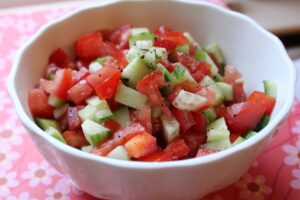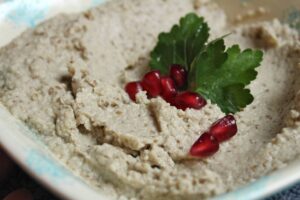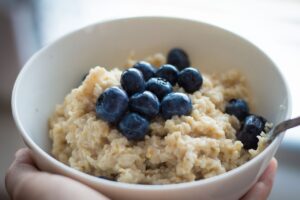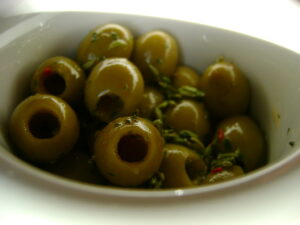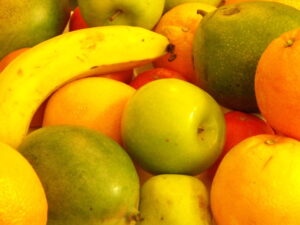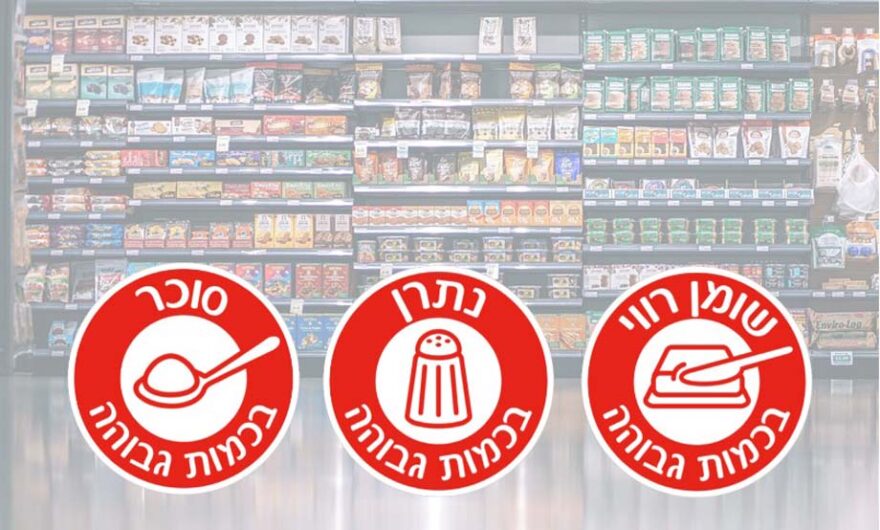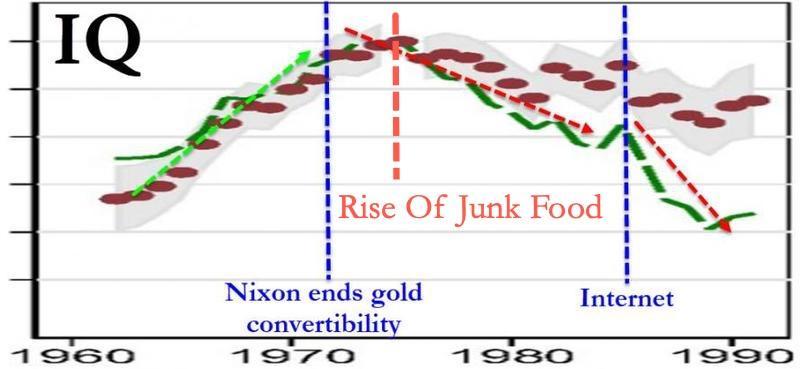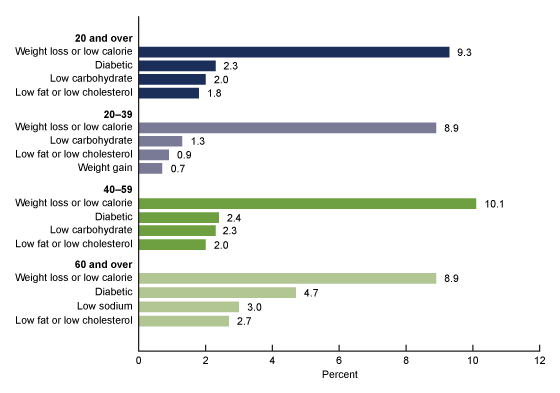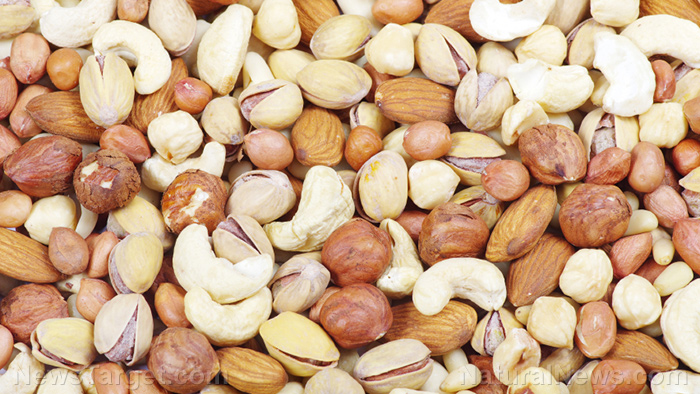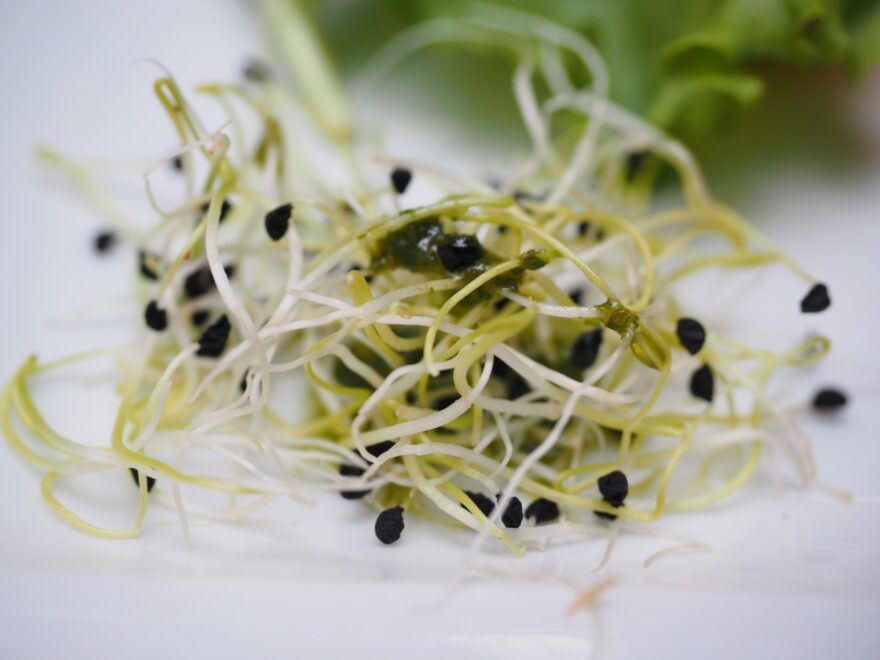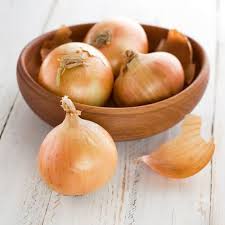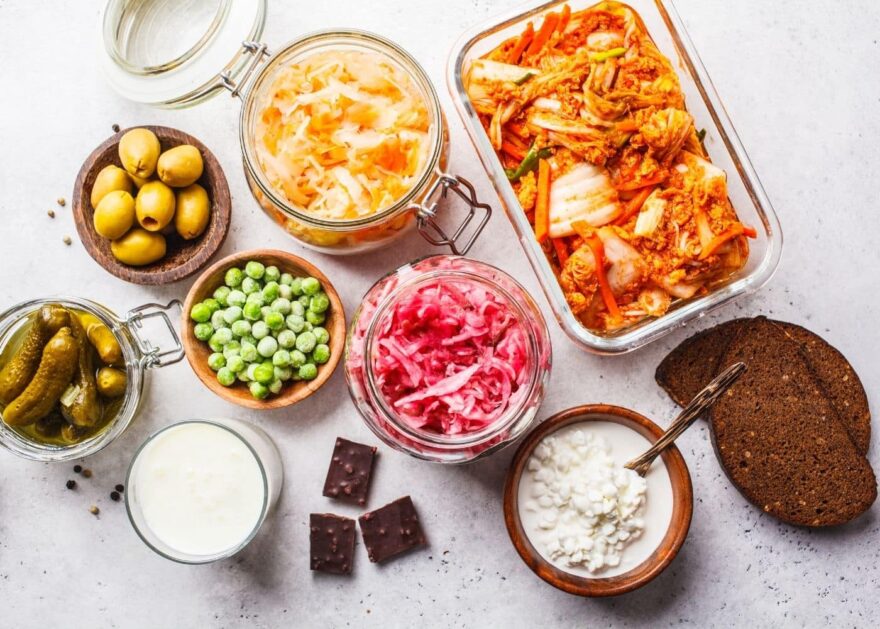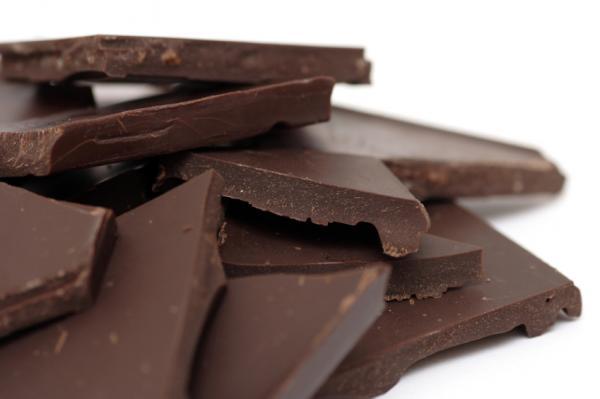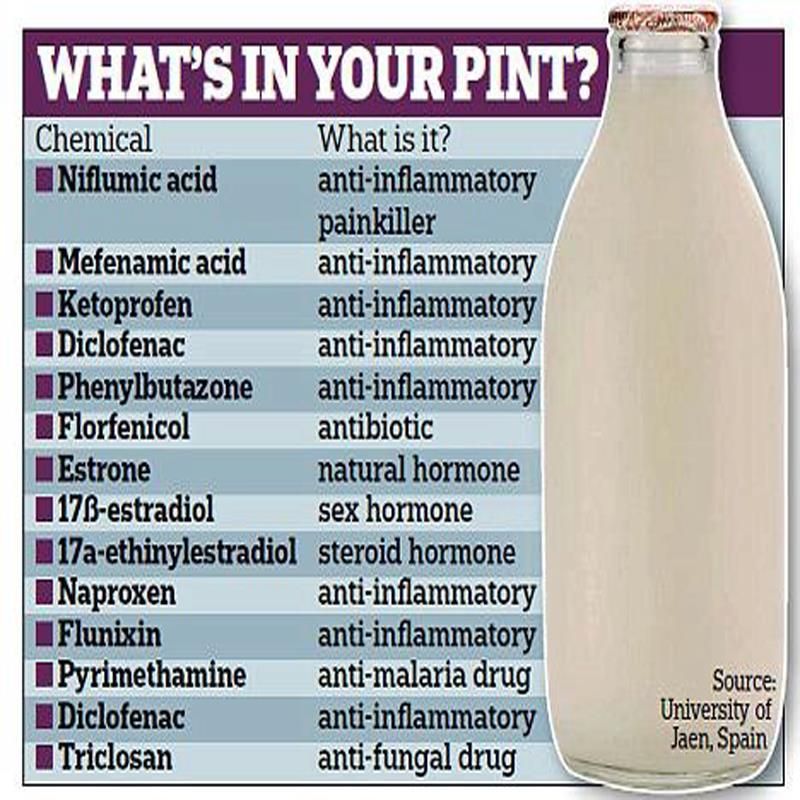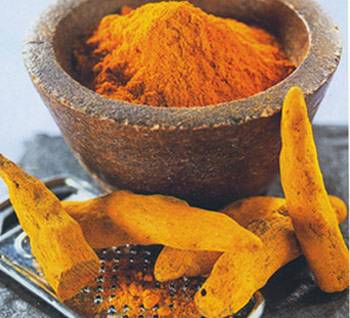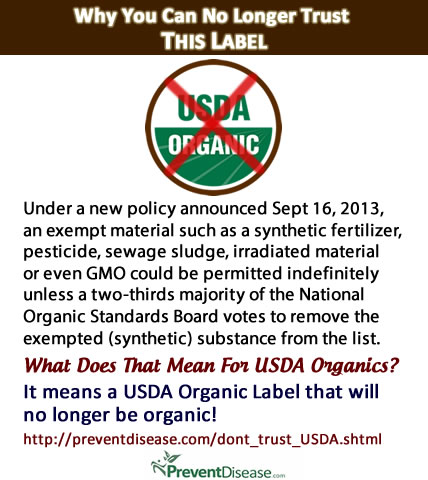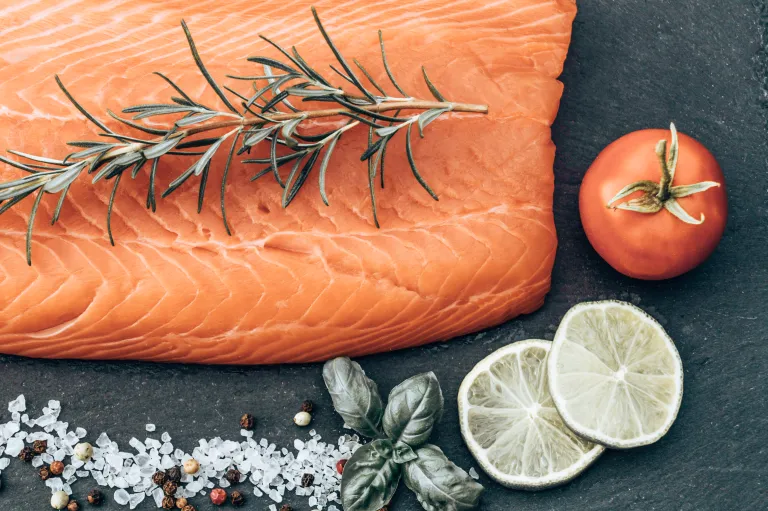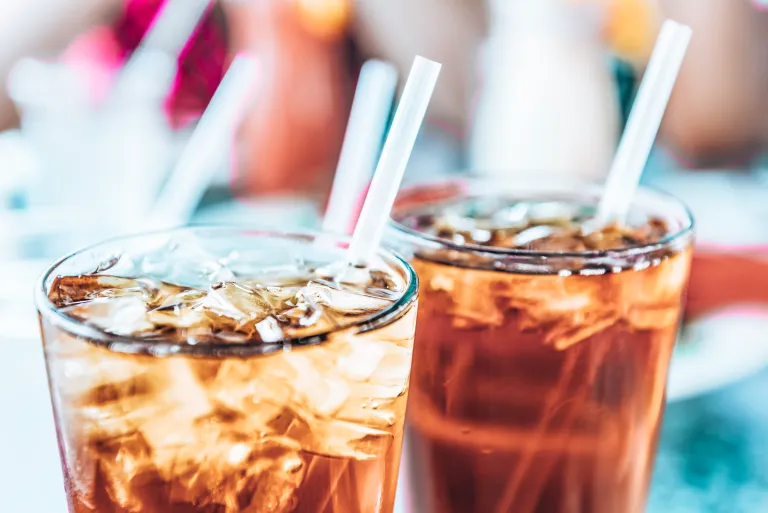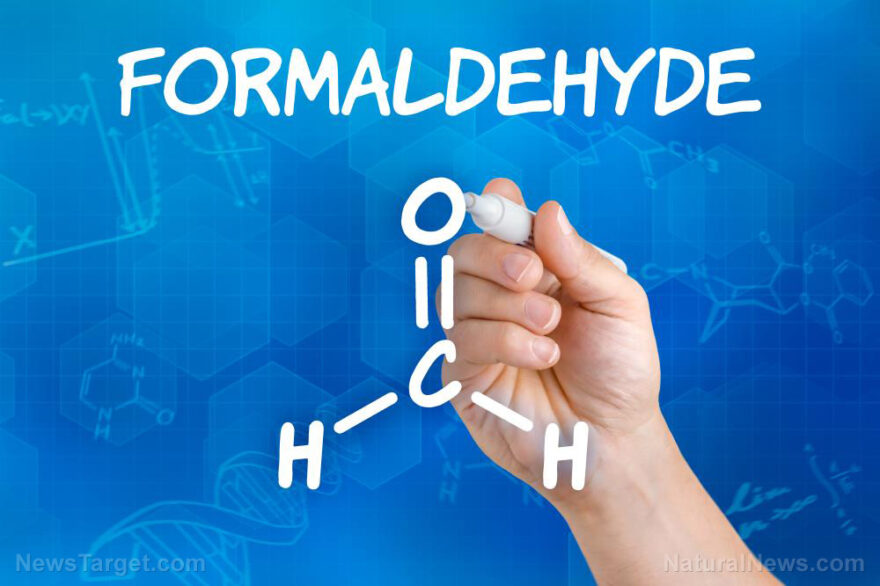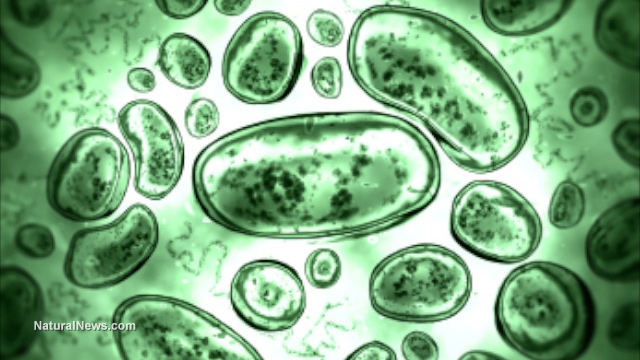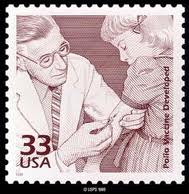
Israeli Breakfasts – Don’t Skip that Morning MealLearn from those delicious Israeli hotel breakfasts – whether you are in Israel or anywhere else – and don’t skip a healthy morning meal..By Nili Abrahams, CHHC, 30/04/13 09:04 http://www.israelnationalnews.com/News/News.aspx/167592#.UX_fpkpWKp0 Israel is famous for its breakfast. This fresh and colourful morning meal served at Israeli hotels and vacation destinations includes: an assortment of salads, cheeses, herrings, fruit and breads to start. It might possibly be the reason that Israel was ranked 6th by Bloomberg Rankings of the World’s healthiest countries in May 2012. Israelis know how to start their morning right.
Are you trying to lose weight by skipping breakfast each day? Do you grab coffees a few times throughout your day rushing to just keep going? Do you find yourself binging at supper and well into the evening?
This is not the ideal weight loss plan. Skipping breakfast must mean that the body’s need and craving for food is ignored. A cycle of binge eating sabotages all efforts at staying nutritionally balanced. Many people overeat in the evenings because they are beyond hungry. Good intentions and weight loss goals can’t be met under these erratic conditions.
The first step to successful weight loss is eating a healthy breakfast. Many studies show that this meal lays the foundation for lifelong health benefits such as lowering cholesterol, improving sugar numbers and possibly preventing heart disease. Breakfast feeds the brain the nutrients it needs for learning, problem solving and improving short term memory while ensuring you feel more energized.
Going without breakfast may mean eating more throughout the day. And finally breakfast eaters consume more nutrients such as calcium and potassium than non breakfast eaters.
A healthful breakfast could consist of eggs, vegetables, fruit and a wholesome grain. You might enjoy a smoothie made with plain yogurt, berries and some ground flax seeds and chia. Leftover brown rice and steamed vegetables make a perfect breakfast. Mix up your breakfast choices to prevent boredom and falling back on old habits.
The possibilities for a creative start to your day are endless. So enjoy your tasty beginnings knowing that you are doing your body a great favour.
Nili Abrahams, Certified Holistic Health Coach at ChooseLifeNutrition, integrating Health and Wellness with Torah’s Wisdom.
And remember you can choose your best life one step at a time. The Benefits of Early Time Restricted Eating |
|||||||||||||
How Circadian Rhythms Affect Blood Sugar Levels |
|||||||||||||
Israel Ministry of Foreign Affairs |
|||||||||||||
How to Make an Amazing Israeli Breakfast BuffetThe Dishes Lean Toward Savory Versus SweetWhen you make Aliyah, you will learn about the Israeli Breakfast. With fresh Salads, Fruit, Hummus and Pita and ELITE Instant Coffee “Nes Cafe” to wake vou up in the morning there is nothing like an Israeli Breakfast. Fruits and Vegitables are very healthy. Israelis live 14 years longer then Americans. Israeli diet ranks among healthiest in world
When it comes to entertaining, it’s also a nice change-up from the standard bagels and lox brunch. Even if you’re looking for a different weekday breakfast, these dishes are ideal inspiration for those days when you want something more exciting than cereal or an egg. After all, hummus, cucumbers, and tomatoes in a pita are a great way to fuel up in the morning. |
|||||||||||||
Classic Israeli Hummushttps://www.thespruceeats.com/israeli-hummus-pareve-2121734 Hummus—that much loved, humble chickpea dip—is a vital part of the cuisine throughout the Middle East. In Israel, where it’s served at breakfast, lunch, dinner, and snack times, it’s practically iconic.
Nowadays, you can find tubs of hummus in supermarkets worldwide, in all sorts of flavors. But nothing beats homemade hummus, and once you get the hang of the basic recipe, you can tweak it to get exactly the texture and flavor you desire.
Hummus is naturally high in good fat because of its sesame seed and olive oil content, with around 1 tbsp (30g) containing 8g of unsaturated fats. Hummus is low in carbohydrates and is also a fairly good source of plant-based protein and fibre. Depending on the recipe, it can be slightly high in salt, so it needs to be used sparingly if you’re watching your salt intake.
Hummus contains some omega-3 fats, calcium, magnesium, iron and zinc, as well as most of the B vitamins. It also counts as one of your 5-a-day because it contains chickpeas, but only up to a maximum of 80g, which is approximately 3 tbsp. |
|||||||||||||
Pita Breadhttps://www.thespruceeats.com/israeli-pita-bread-2121767 This recipe for Israeli pita bread makes it easy to enjoy your own fresh pita breads (pitot in Hebrew) warm from the oven. If you want to make them ahead, you can store them in the freezer so they stay fresh, then warm them up before serving.
Pita, by the way, isn’t the only bread you’ll find in a typical spread. Rolls, multigrain breads, challah, and bagels are all popular choices, too. |
|||||||||||||
Israeli Saladhttps://www.thespruceeats.com/classic-israeli-salad-2121980 This chopped tomato and cucumber salad is so iconic of Israeli cuisine that it has been dubbed “Israeli salad,” and shows up on the table any time of day—breakfast included. It’s virtually impossible to imagine stuffing a falafel sandwich or enjoying some freshly baked pita and hummus without it.
The truth is, Israelis aren’t the only ones who appreciate this simple salad; you’ll find similar recipes throughout the Middle East and Mediterranean region. Some include fresh herbs, other vegetables, or vinegar. |
|||||||||||||
Baba Ghanoush Eggplant Dip Recipehttps://www.thespruceeats.com/easy-vegan-baba-ganoush-eggplant-hummus-3377666 Popular throughout the Middle East, Baba Ghanoush—also known as Baba Ghanouj and Babaganoush—is a dip or spread made of roasted eggplant and tahini. The recipe is straightforward: simply roast the eggplant, spoon out the softened pulp, and then puree with tahini and seasonings. Scoop it up with fresh pita bread or raw veggies. This dish is a great source of proteins and dietary fiber. It also contains a lot of fat with up to 30 grams of fat. However, this fat is healthy as it consists of monounsaturated and polyunsaturated fats. |
|||||||||||||
Chia Oatmeal PuddingA alternative to a sugary American Breakfast.Oats are Heart Healthy: You may or may not know that heart disease is the number one killer in the United States. And, you’re probably trying to think of ways to not be afflicted by this unfortunate disease. Fortunately, oats are great for your heart! They contain a fiber called beta-glucan which is shown to be effective at reducing both total and LDL cholesterol levels. The beta-glucan can also increase the excretion of cholesterol-rich bile, which in turn helps circulate levels of cholesterol in the blood. Last, oats can help with reducing inflammation in the arteries, reducing risks for heart attacks and strokes.
Oats Improve Blood Sugar Control: Oats can be very beneficial for those who have diabetes. The beta-glucan fibers in the oats can help prevent blood sugar levels from rising after a meal. Not only do oats help reduce blood sugar levels, it also improves insulin sensitivity.
Oats Help Alleviate Constipation: Everyone experiences constipation from time to time, and some more than others. We can all agree that constipation is not a fun experience at all. But, luckily, oats can help with that. Because oats are fiber-rich, they help keep bowel movements regular.
Oats Can Help You Lose Weight: Part of losing weight is eating a lower calorie diet so that you burn more calories than you eat, but also that you are taking in the macronutrients necessary for your body to be healthy. Oats are both filling and have well-balanced macros to lead you on your way to your weight loss goals.
Oats Can Help Reduce Risks for Cancer: We don’t have to tell you how much cancer sucks. But, fortunately, oats can help reduce your risk of cancer. Oats contain phytochemicals which have been known to reduce susceptibility to hormone-related cancers such as prostate cancer or breast cancer.
Chia Seeds Are Loaded With Antioxidants. … Almost All the Carbs in Them Are Fiber. … Chia Seeds Are High in Quality Protein. … Chia Seeds Are High in Omega-3 Fatty Acids. Ingredients:
Optional Toppings – fresh berries or diced fruit, Bananas, Dried Dates, cut lengthwise and remove the pitt, dried berries or fruit, chopped nuts, seeds, nut butter, yogurt, granola, shredded coconut, cacao nibs Instructions
|
|||||||||||||
Hashachar Ha`ole” Chocolate Spread and Israeli Bakery items
|
|||||||||||||
OK; Bottom line is this is highly adictive and will ruin your diet. That said: Think of chocolate spread as Israel’s answer to Nutella, only without the hazelnuts. Like its much loved Italian counterpart, Israeli chocolate spread first hit the market in the mid-1940s and has been popular as a breakfast spread, snack, and dessert ever since. Unlike Nutella, the most commercial chocolate spread is pareve, so it can be enjoyed any time of day or night.The original and arguably most popular brand in Israel is called “Hashachar Ha`ole” literally – “Bright Morning” spread—so how can one not associate it with breakfast? Try it on challah or warm pita, or as a filling for crepes. Add some banana or strawberries if you want to up the nutrition factor.
Bourekas
In Israel, freshly baked bourekas with all sorts of fillings are a bakery mainstay, and the supermarkets sell frozen ones as a convenience item. Kosher supermarkets in the U.S. and elsewhere often carry them, too, but they can be hard to find otherwise.
Fortunately, they’re not at all hard to make at home. Cheese or potato bourekas are often included as part of a breakfast buffet at Israeli hotels, and you can grab them on the go from countless bakeries or shuks (open-air markets). |
|||||||||||||
Coffee“No matter when and how you drink your coffee, coffee is always a break of sanity, a moment of sober contemplation of the world.”Israel has always had a strong coffee culture, ELITE Instant Coffee “Nes Cafe” is the most popular coffee here but historically Turkish coffee is a perpetual mainstay.
But espresso-based drinks have gained lots of ground, too. One favorite is the “cafe hafuch,” or “upside-down coffee,” a latte-like drink made with steamed milk on the bottom, espresso, and sometimes foamed milk on top. |
|||||||||||||
OlivesOlives are very high in vitamin E and other powerful antioxidants. Studies show that they are good for the heart and may protect against osteoporosis and cancer. The healthy fats in olives are extracted to produce olive oil, one of the key components of the incredibly healthy Mediterranean diet. They’re a natural fit for a meal featuring savory fares like hummus, cheese, and eggs. |
|||||||||||||
FruitIsrael is known for it’s Fruit. Most fruits are naturally low in fat, sodium, and calories. None have cholesterol.
Fruits are sources of many essential nutrients that are underconsumed, including potassium, dietary fiber, vitamin C, and folate (folic acid).
Diets rich in potassium may help to maintain healthy blood pressure. Fruit sources of potassium include bananas, prunes and prune juice, dried peaches and apricots, cantaloupe, honeydew melon, and orange juice.
Dietary fiber from fruits, as part of an overall healthy diet, helps reduce blood cholesterol levels and may lower risk of heart disease. Fiber is important for proper bowel function. It helps reduce constipation and diverticulosis. Fiber-containing foods such as fruits help provide a feeling of fullness with fewer calories. Whole or cut-up fruits are sources of dietary fiber; fruit juices contain little or no fiber.
Vitamin C is important for growth and repair of all body tissues, helps heal cuts and wounds, and keeps teeth and gums healthy.
Folate (folic acid) helps the body form red blood cells. Women of childbearing age who may become pregnant should consume adequate folate from foods, and in addition 400 mcg of synthetic folic acid from fortified foods or supplements. This reduces the risk of neural tube defects, spina bifida, and anencephaly during fetal development. |
|||||||||||||
Gavina LabnehGavina Labneh is a thick, tangy strained yogurt that’s delicious with cucumber and tomato salad, drizzled with olive oil and seasoned with za’atar, or served as a spread for pita and breakfast breads. Like most Middle Eastern foods, labneh is extremely good for you. Apart from being an important source of protein, labneh is considered a probiotic food, meaning that it is high in a range of healthy bacteria that help to boost your immune system.
Fruit yogurts also tend to make an appearance on Israeli breakfast buffets, so if you prefer things on the sweeter side, feel free to add. |
|||||||||||||
Shakshouka (Baked Eggs in Tomato Sauce) Israeli Breakfast: Shakshouka, from the Hebrew word leshakshek meaning “to shake”, is a popular, spiced, egg and tomato dish. Shakshouka:”This Tunisian and Israeli dish is like a Mediterranean version of huevos rancheros. Fried eggs simmer in a sauce of tomatoes, onions, colorful bell peppers, chile peppers, and spices. |
|||||||||||||
| Ingredients: 3 tablespoons olive oil 1 1/3 cups chopped onion 1 cup thinly sliced bell peppers, any color 2 cloves garlic, minced, or to taste 2 1/2 cups chopped tomatoes1 teaspoon ground cumin 1 teaspoon paprika 1 teaspoon salt 1 hot chile pepper, seeded and finely chopped, or to taste 4 eggs |
Directions: 1. Heat the olive oil in a skillet over medium heat. Stir in the onion, bell peppers, and garlic; cook and stir until the vegetables have softened and the onion has turned translucent, about 5 minutes. 2. Combine the tomatoes, cumin, paprika, salt, and chile pepper into a bowl and mix briefly. Pour the tomato mixture into the skillet, and stir to combine. 3. Simmer, uncovered, until the tomato juices have cooked off, about 10 minutes. Make four indentations in the tomato mixture for the eggs. Crack the eggs into the indentations. Cover the skillet and let the eggs cook until they’re firm but not dry, about 5 minutes. ALL RIGHTS RESERVED © 2013 Allrecipes.com Printed from Allrecipes.com 5/1/2013< |
||||||||||||
TOP |
|||||||||||||

Health Ministry food labeling reform launchesFood companies in Israel now required to mark products to warn public of high levels of sugar, saturated fat, and sodium.Mordechai Sones, 02January2020 http://www.israelnationalnews.com/News/News.aspx/274001 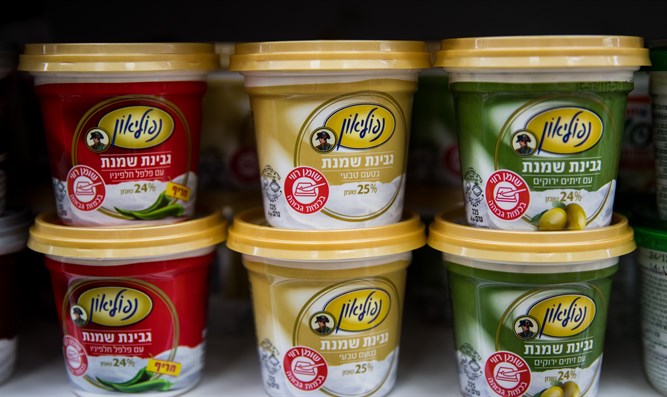 Food companies in Israel now required to mark products to warn public of high levels of sugar, Red sticker on high-fat cream cheesesaturated fat, and sodium. As of January 1, 2020, food companies in Israel were required to mark their products to warn the public of high levels of sugar, saturated fat and sodium.
Products that contain large quantities, as determined by the Health Ministry, will be marked with prominent red stickers aimed at attracting consumers’ attention.
Products defined by the ministry as “Healthy” will be marked with green stickers.
In the last few months, many food companies in Israel have reduced sugar, saturated fat and sodium in their products to avoid the red stickers. רפורמת סימון המזון יצאה לדרך
31December2019 רפורמת סימון המזון של משרד הבריאות במסגרת אפשירבריא – התכנית הלאומית לחיים פעילים ובריאים, יצאה לדרך ומעכשיו קל ופשוט יותר לבחור בריא יותר. סימונים אדומים למוצרי מזון המכילים כמויות גדולות של סוכר, נתרן או שומן רווי, וסימון ירוק למזונות שכדאי לצרוך כחלק מתזונה בריאה. הסימונים האדומים מגיעים למדפיםמעכשיו נדע בקלות ובמהירות אם במוצרי המזון יש כמויות סוכר, שומן ונתרן שחורגות מהסף שקבע משרד הבריאות. למה נועד המהלך וכיצד הוא ישפיע על הבריאות שלנו? The red markings reach the shelveshttps://www.efsharibari.gov.il/eat-healthy/buy-healthy-food/food-labeling/harmful-food-labeling/ From now on we will know easily and quickly if the food products have amounts of sugar, fat and sodium that exceed the threshold set by the Ministry of Health. What is the purpose of the move and how will it affect our health? So which foods will be marked with red marks?
What types of food will be marked with the green symbol?The green marking is intended to help consumers understand which foods are better for them as part of a healthy and balanced diet. The meaning of the green marking: raw foods, meaning in a state as close as possible to their natural state or after minimal processing. In the diverse list of “green” foods you can find dairy products and substitutes (milk, yogurts, cheeses, tofu, soy drinks), certain vegetable oils, seeds and nuts, grains, legumes, tahini, tahini salad, fish, eggs, prepackaged poultry, fruits and vegetables. For each of these food groups, individual conditions have been set so that they can carry a green label – if they meet them. What about food products that are not marked in red or green?The fact that a certain product is not marked in red does not really indicate that it is recommended for consumption or that it should be part of a healthy and balanced diet. The absence of a red marking means that the values of sodium, saturated fat and sugar in the product are lower than the set threshold. |
|||||||||||||

Video: 11-Year-Old Takes Down Monsanto In TED TalkPosted by Anthony Gucciardi on May 29, 2013 http://tv.naturalsociety.com/11-year-old-takes-down-monsanto-ted-talk/ Monsanto Corporation gets owned by 11 year old boyThe fight against Monsanto has heated up like never before, especially with the recent March Against Monsanto and other campaigns that have been rooted in similar activism. But the simple reality is that it doesn’t take a PHD to realize how Monsanto’s genetic manipulation of the food supply is an assault on the health of the world — an experiment to which we do not know the full extent of the damage. Instead, as 11-year-old Birke Baehr shows us, it simply takes a bit of research.
I wanted to share Birke’s TEDX speech as I feel it shows just how far the information we continue to cover each day has spread. Even the youngest citizens of the world are continuing the tradition of seeking truth that those before them have initiated since the beginning. The speech also reveals how even an 11-year-old can examine the situation at hand and realize the inherent problems that go along with giving control of the world’s staple food supply to a company that created one of the deadliest chemical weapons of all time — Agent Orange. A History Of CorruptionWe know that Monsanto was responsible for creating the Vietnam-era chemical warfare weapon known as Agent Orange. A chemical creation that killed 400,000 individuals (many of which were innocent or our own troops), led to 300,000 plus birth defects, and continues to haunt veterans and their families to this day. We also know that Monsanto managed to slip away from criminal charges without so much as a real apology. Quite simply, this is a company with a confirmed history of widespread death that has, in typical mega corporation fashion, utilized an army of lawyers to protect itself from fair treatment within the court system.
And thanks to the company’s extreme ties to the government and the media, from associates like top FDA head Michael Taylor, Supreme Court Justice Clarence Thomas, and beyond, it has managed to get away without a hitch. Monsanto’s good pal Clarence Thomas has even helped secure them a foothold within the Supreme Court that has allowed for them to openly patent life under what the Supreme Court determines to be a perfectly ‘legal’ practice.
Watch as Birke exposes Monsanto based on the information surrounding the GMO juggernaut that he has researched during his homeschooling. |
|||||||||||||

Nutrient deficiencies on the rise: Vitamin A levels take a nosedive over the last decade, causing the rise of infectious diseases such as measlesFriday, August 16, 2019 by: Lance D Johnson https://www.naturalnews.com/2019-08-16-vitamin-a-levels-take-a-nosedive-rise-of-infectious-diseases-measles.html (Natural News) Even though developed nations boast of great technology, infrastructure, economy, and advanced medical care, they still suffer from ballooning rates of obesity, chronic disease, cardiovascular issues, metabolic disorders, and cancer. Infectious diseases still run rampant in developed nations, despite advances in plumbing and sanitation. The breakdown of developed nations is a slow and painful process, and at the root of it all is toxic human beings who suffer from nutrient deficiencies, multiple chemical exposures, and heavy metal poisoning. Addicted to processed foods and sugar, the general population has become fragile ghosts of the men and women who once roamed the Earth with vitality and vigor.
According to the U.K.’s latest National Diet and Nutrition Survey, the population’s intake of basic vitamins and minerals has taken a nosedive over the last decade. The most shocking observation from this study is that basic, readily-available nutrients are not showing up in blood samples like they used to. Vitamin A, fiber, vitamin D, and iron levels are falling steadily across all age groups, in both men and women. Vitamin A deficiency and measles resurgenceBetween 2008 and 2017, the average vitamin A blood concentration fell by four percent every year for children between the ages of 1.5 and 18. The same downward trend was observed in the elderly (65 and older). Vitamin A blood levels dropped an average two percent each year for all other adults (19-64 years). This is deeply concerning because vitamin A levels impact infectious disease duration and severity, including but not limited to: measles. A greater vitamin A level helps fortify the intracellular T-cell response of the immune system. This is the part of the immune system that is already weakened in people who are heavily vaccinated. Vaccine science generates an unsustainable, short-term, allergic, extra-cellular B-cell response, but this augmentation inevitably weakens the response of T cells that work to eliminate viruses within the cells. Plummeting vitamin A levels throughout the population and over-vaccination plays a role in early childhood death and the resurgence of measles and other infectious diseases. Iron deficiency and anemiaThe study also found that iron levels are rapidly falling in women, primarily young girls and women of child-birthing age. Iron deficiency causes birth defects, primarily neural tube defects. Young girls between four and 10 years saw the sharpest decline in iron levels (.2mg/day), which ultimately causes anemia. In 2015, iron deficiency anemia affected up to 1.48 billion people. During the past decade, anemia risk has risen by 19 percent for children between the ages of 11 and 18. Iron deficiency is a global health crisis, resulting in 54,000 deaths annually.
Vitamin D levels, on the other hand, were more likely to fall in young boys. Over a nine-year period, boys between the ages of 11 and 18 suffered a two percent reduction in vitamin D levels — double the losses experienced by adults during that same time period. Like vitamin A, vitamin D helps build the natural immune system. Due to a lack of sun exposure, it is expected that vitamin D levels fall off during the winter months, but the reduction got worse with each winter season. By the end of the study, nearly a third of adults were at risk from vitamin D deficiency. Vitamin D supplements are affordable, readily available, and can help mitigate immune deficiencies caused by indoor, sedentary lifestyles.
Finally, the study found that fiber levels are falling for every age group of children, primarily those between the ages of 4 and 10. Men saw an increase of fiber intake over the past decade, but deficiencies in children could spell health issues as they reach adulthood. The authors of the study recommend that developed nations prioritize the nutritional needs of the population by investing in diverse agriculture, making nutrient-rich foods more affordable and more readily available. Overworked soils are lacking trace minerals such as selenium, chromium, magnesium, and zinc. Monotonous rows of genetically modified corn and soybeans should be replaced with more vegetables, fruits, nuts, seeds, herbs, and medicinal roots. Reduction of basic vitamins such as A and D in the human diet will inevitably cause greater rates of illness and the resurgence of nutrition-preventable diseases such as measles and pneumonia.
For more on the issue of malnutrition, visit Nutrients.News. Sources include: |
|||||||||||||

Idiocracy Explained – New Study Finds Western Diet Impairs Brain Functionby Tyler Durden 20February2020 – https://www.zerohedge.com/markets/idiocracy-explained-new-study-finds-western-diet-impairs-brain-function
A new study suggests this is possible through today’s eating trends in western countries that could severely impair brain functions.
Researchers discovered that volunteers in the study performed with high cognitive processes when they did not consume high fat and high added sugar diets, commonly found in many western-style meals.
Richard Stevenson, professor of Psychology at Macquarie University in Sydney and one of the co-authors of the study, said eating a western-style diet causes some disruption in the hippocampus region of the brain, the part involving memory and appetite control.
…
Norwegian researchers in 2018 analyzed the IQ scores of people from western countries between 1962 and 1991 and discovered scores increased by almost 3 percentage points each decade for those born between 1962 to 1975 – but then, in nearly the same year the term “junk food” was popularized in 1976, IQ scores started to plunge.
Junk food has plagued many western countries for the last four decades, suggesting a cognition crisis has developed as society becomes stupider by the day. And if it’s by design or just an accident, that remains an open discussion among the tinfoil hat community. Read the full study: link https://royalsocietypublishing.org/doi/10.1098/rsos.191338 Hippocampal-dependent appetitive control is impaired by experimental exposure to a Western-style diet
|
|||||||||||||

Study in diet trends reveals that a poor diet is WORSE for your health than drinking and smokingPoor eating habits kill more people than drinking or smoking, says an alarming study published in the journal The Lancet12 September 2019 / By Zoey Sky https://frankenfood.news/2019-09-12-study-reveals-poor-diet-is-worse-than-drinking-and-smoking.html  Junk Food-Poor eating habits kill more people than drinking or smoking, says an alarming study published in the journal The Lancet. The extensive study on worldwide diet trends identified a link between unhealthy diets and 11 million deaths around the globe in 2017. Over 50 percent of these deaths were associated with consuming a lot of salty foods and not getting enough fruits and whole grains.
Junk food and premature deathData from the study revealed that a bad diet is worse for your health compared to alcohol consumption and other common risk factors for premature death. Poor diets were significant contributors to deaths associated with cancer, heart disease, and Type 2 diabetes.
Dr. Ashkan Afshin, one of the authors of the study, explained that risk factors linked to poor diets affect individuals “regardless of their age, gender, or socioeconomic background.”
Afshin, who is also an assistant professor of health metrics sciences at the University of Washington’s Institute for Health Metrics and Evaluation, added that despite the varying magnitude of this problem, people from different countries are all affected.
Analyzing dietary factorsThe researchers conducted the study as part of the Global Burden of Disease (GBD) research effort. The program aims to gather and analyze data concerning premature death and disability from over 350 diseases and injuries in 195 countries.
In the study, the researchers referenced data from the GBD and other sources such as national nutrition surveys. The participants were adults aged 25 and older, and the data covered 27 years from 1990 to 2017.
The study authors analyzed 15 dietary factors. This included diets low in calcium, fiber, fruits, legumes, milk, nuts and seeds, omega-3 fatty acids (from seafood), polyunsaturated fats, vegetables, and whole grains.
The rest of the factors included diets high in processed meat, red meat, sugar-sweetened beverages, trans fatty acids, and sodium.
The researchers used various statistical approaches to determine the consumption and the number of deaths and disabilities linked to poor dietary habits. Additionally, they compared the number of deaths associated with each of the 15 dietary components with other established risk factors like being overweight or obese, drinking, high blood pressure, low physical activity, and smoking.
The researchers found that poor dietary factors overall ranked as the most important risk factor for mortality globally. Bad diets led to more deaths than other risk factors like drinking and smoking. Eat more greens and less meatThe researchers also determined the optimal intake for every dietary factor by estimating the levels of intake linked to the lowest chances of death.
They found that the global population didn’t consume enough fruit and whole grains. The survey takers also didn’t consume beneficial levels of milk, nuts, and seeds.
Meanwhile, the participants consumed too many sugary drinks and processed meats. (Related: Bad food will kill you: Poor diet number one cause of death, chronic disease worldwide.)
The average per-person overload of processed meats was almost twice the advised amount, or 0.14 compared to 0.07 ounces, respectively. Worldwide, people were consuming 86 percent more sodium every day, or a little over one teaspoon, than what was considered healthy.
Dr. David Katz, founder and president of the True Health Initiative, warned that high salt intake seems to be the number one association with premature death all over the developed world. Katz believes that this is because about 80 percent of the sodium people consume comes from processed food and that this tolerance of processed food may be lethal.
Katz, who wasn’t involved in the study, suggested that the study verifies findings from earlier research about the significant impact of healthy eating habits on the prevention of chronic diseases.
In the study, scientists associated 255 million disability-adjusted life years (DALYs) to poor diet. The World Health Organization noted that one DALY is equal to one lost year of “healthy” life.
Katz emphasized that the basics of healthy eating habits and overall well-being will stay the same. A nutritious diet must include a lot of minimally processed foods such as beans, fruits, lentils, nuts, seeds, vegetables, and whole grains, along with plain water instead of sugary drinks. Make these foods the bulk of your diet and consume dairy, eggs, fish, and lean meat moderately.
Avoid fad diets and start a healthy meal plan, such as a vegetarian or Mediterranean diet. Other easy ways to improve your eating habits include eating more fresh fruit, drinking more water, consuming whole grains, and eating smaller portion sizes.
Afshin said that the study suggests that the major problem isn’t the high intake of junk food. Rather, it’s the low intake of nutritious food.
The current GBD findings provide proof that this problem can be rectified by shifting the focus from “an emphasis on dietary restriction to promoting healthy food components.” Sources include: |
|||||||||||||

Does removing sugar from your diet starve cancer cells? New study finds surprising answersSunday, July 22, 2018 by: Ralph Flores https://www.naturalnews.com/2018-07-22-does-removing-sugar-from-your-diet-starve-cancer-cells.html (Natural News) Cutting back on sugar may help decrease your likelihood of getting certain cancers, a recent study noted. The finding, which was part of an investigation made by researchers from Duke-NUS Medical School and the National University of Singapore, together with the Duke University School of Medicine and the Medical University of Vienna, is part of a unique approach explaining how reducing sugar can cause cancer cells to die.
The paper, which was published in the online journal Science Signaling, presented a novel cell death pathway through introducing how depriving cancer cells of sugar can trigger a reaction that causes them to die. This research builds on earlier scientific literature that indicates that cancer cells that quickly multiply need higher levels of sugar than healthy cells. (Related: More Evidence that Sugar Fuels Cancer Growth.)
In the study, researchers found that in specific cancer cells, the presence of low levels of sugar that are insufficient for providing energy may be used as a method to enhance the survivability of the cells. They then posited that this might be another effect that sugar has on cancer cells.
They also found that when cancer cells are deprived of sugar, this causes a reaction across the cancer cell membrane and leads to an increased intake of calcium ions into the cells, which causes them to die ultimately. For the study, they used two cancer cells: one that contained extra glucose and the other, which didn’t. Both samples were then exposed to a “two-pronged attack.” The first one was with STF-31, a compound that inhibits glucose transport into cells, and the second one was with thapsigargin, which increases the level of calcium in cells. The team found out the cancer cells that had that extra glucose in them were unaffected; however, those with limited reserves were killed off.
The power of the elements: Discover Colloidal Silver Mouthwash with quality, natural ingredients like Sangre de Drago sap, black walnut hulls, menthol crystals and more. Zero artificial sweeteners, colors or alcohol. Learn more at the Health Ranger Store and help support this news site.
The team believes that this approach can be used in unique approaches to treating cancer. Initial tests in the study showed that depriving cancer cells of sugar and increasing the body’s calcium levels managed to destroy cancer cells while leaving the healthy ones unharmed. Also, only certain types of cancer cells were noted to have lost the capacity to maintain intercellular sugar levels after the treatment. Researchers believe that this only applies to cells which are sensitive to sugar deprivation.
“Because these phenomena are not seen in normal/healthy cells, this inability of some tumors to maintain intracellular glucose levels could be an unappreciated Achilles’ heel that might be therapeutically targeted,” the researchers wrote of the results, as it appeared in Cosmos. “A molecular signature of cancers with reduced ability to maintain intracellular glucose would help develop that strategy for clinical application.”
Of the results, the team plans to conduct further research to create possible treatment procedures from this approach in the future.
Other adverse effects of added sugar on the bodyOne of the leading causes of the increase of sugar in the body is the consumption of added sugars. Unlike naturally-occurring sugars, which can already be found in fresh fruit and vegetables, added sugars that are found in processed food and beverages overload the body, carrying a significant risk of disease. Here are some of the other dangers that added sugars have on our body.
Does Sugar Lead to Weight Gain?Learn more about the adverse effects of sugar by going to Sweeteners.news today. Sources include: |
|||||||||||||

9 Superfoods with powerful anti-viral properties18March2020 by: Divina Ramirez https://www.naturalnews.com/2020-03-18-9-superfoods-with-anti-viral-properties.html (Natural News) Viruses are responsible for many infectious diseases, including the flu, influenza and tuberculosis. Due to increased global travel, viral outbreaks often pose a serious threat to public health. Some examples include the emergence of dengue, measles and severe acute respiratory syndrome (SARS).
Currently, the coronavirus disease (COVID-19) is rapidly spreading in different countries. COVID-19 is caused by a new strain of coronavirus. Although the disease has a low fatality rate compared to the flu or tuberculosis, healthcare professionals note that a healthy immune system is the body’s first line of defense.
Luckily, there are natural ways to fortify the immune system. For instance, eating a balanced diet ensures that the body receives important nutrients. However, boosting the immune system requires more than just eating the usual foods.
Here are some superfoods with potent anti-viral properties that can help your immune system defend against viruses: GarlicGarlic is a powerful anti-viral, anti-bacterial and anti-fungal agent. It fortifies the immune system against mild infections, like the common cold, by stimulating the production of white blood cells. Its anti-viral properties also allows garlic to help fight different viruses, such as the influenza viruses that cause the flu and the rhinoviruses that cause the common cold. Shiitake mushroomShiitake mushroom can also boost the immune system because it contains high amounts of beta-glucans, which are found in the cell walls of bacteria, fungi, yeasts and algae. Beta-glucan supplements are commonly used to treat hyperlipidemia, hypertension and canker sores. However, recent studies have shown that beta-glucan also has anti-viral effects against influenza, swine flu and hepatitis. ElderberryElderberries are commonly used to relieve symptoms of the flu. They also possess antioxidant and anti-inflammatory properties that strengthen the immune system. Elderberries may also be effective against viral infections caused by the herpes simplex virus and HIV. SproutsMany sprouts, like mung bean sprouts and broccoli sprouts, provide the body with high amounts of essential vitamins, minerals and nutrients. Mung bean sprouts, in particular, also possess powerful anti-viral and antibacterial properties. Meanwhile, broccoli sprouts have been shown to enhance anti-viral host defense responses, thanks to the activity of a compound called sulforaphane. Citrus fruitsCitrus fruits, such as oranges, lemons, tangerines, grapefruits, limes and pineapples, contain high amounts of vitamin C. This vitamin is essential to many body functions, including metabolism, bone development and cell repair. It also plays an important role in fortifying the immune system against diseases and viral infections. Many green, leafy vegetables contain vitamin C. These include chili peppers, thyme, parsley, spinach, kale and broccoli. (Related: Chinese doctors study vitamin C for treating coronavirus infections.) RosemaryThis aromatic herb is used in traditional medicine to boost immunity, relieve muscle pain, improve memory and stimulate hair growth. Rosemary contains a plant compound known as oleanolic acid, which can also be found in olives, garlic and brush cherries. Aside from its antioxidant and antibacterial effects, oleanolic acid has potent anti-viral effects against the herpes simplex virus, HIV, influenza and the hepatitis A virus. YogurtPlain, unsweetened yogurt is rich in probiotics that improve digestion and promote a healthy gut. Some strains of probiotics also possess anti-viral effects against respiratory viruses. HerbsMany herbs possess anti-viral properties that fortify the immune system against infections, such as:
Green teaEpigallocatechin-3-gallate (EGCG) is a unique plant compound found in green tea leaves that has anti-inflammatory and anti-viral properties. Green tea is known to be potent against HIV, the herpes simplex virus and the hepatitis B virus.
Common kitchen herbs, spices and ingredients have powerful antioxidant, antibacterial and anti-viral properties that protect the body from infections and diseases. Boost your immune system by including these foods in your recipes, drinks and snacks. Sources include: |
|||||||||||||

Just 2 teaspoons of nuts can stave off cognitive decline in the elderlyDecember 01, 2019 by: Edsel Cook https://www.naturalnews.com/2019-12-01-2-teaspoons-of-nuts-can-stave-off-cognitive-decline-in-elderly.html
(Natural News) As people grow older, their cognitive health declines. But a new Australian study suggests that aging people can improve their cognitive function if they eat large amounts of nuts every day.
The researchers surveyed more than 4,800 Chinese adults who were 55 years of age or older for 15 years. They discovered a link between eating more than 10 grams of nuts every day and improved mental ability.
They reported that participants who ate that amount of nuts regularly displayed better memory, reasoning, and thinking.
Dr. Ming Li oversaw the efforts of the University of South Australia (UniSA) research team. He remarked that their findings provided the first evidence of a correlation between cognition and nut intake in aging Chinese adults.
Their findings also offered a potential solution for the increasing number of mental health problems that affected aging populations, such as dementia.
“Population aging is one of the most substantial challenges of the twenty-first century,” explained Li. “Not only are people living longer, but as they age, they require additional health support which is placing unprecedented pressure on aged-care and health services.” (Related: Improve cognitive performance and attention with good fats and nutrition.) The world’s population of older people is growing rapidlyLi believed that preventative health care might solve the problems faced by an aging population. Adding healthy foods to their diet, for instance, might prove effective in preserving mental health.
Based on the findings of his team, older people might enhance their cognitive function by as much as 60 percent if they eat at least two teaspoons of nuts each day. Daily intake of nuts can help prevent the loss of two year’s worth of cognitive function.
Age-related mental health problems are becoming common in China. The country has one of the fastest-growing populations of aging people in the world.
Experts predict that the population of China will hit its peak at 1.44 billion in 2029. Senior citizens will heavily outnumber younger people by then.
By the time 2050 rolls in, there will be 330 million Chinese who are more than 65 years old. Another 90.4 million will be older than 80. China will have the largest population of elderly people in the world.
China is not the only country that will experience this problem. The World Health Organization (WHO) predicts that the global population of people aged 60 years and above will exceed the world’s number of children less than five years old.
Eating plenty of peanuts every day may help older adults stay independentLi and his UniSA team evaluated nine sets of data collected by the China Health Nutrition Survey for 22 years. They noticed that 17 percent of the participants regularly ate nuts.
Peanuts made up most of their daily nut intake. Li said that the nut reduced inflammation and displayed antioxidant activity. Both effects helped alleviate and limit the loss of cognitive function.
“Nuts are known to be high in healthy fats, protein and [fiber] with nutritional properties that can lower cholesterol and improve cognitive health,” he noted. “While there is no cure for age-related cognition decline and neurogenerative disease, variations in what people eat are delivering improvements for older people.”
The WHO’s most recent estimate places the global population of dementia patients at 47 million. The number will hit 75 million in 2030 and reach 141 million by 2050.
Unsurprisingly, China contains the highest number of dementia cases in the world.
Li explained that cognition naturally declines during the aging process. Additionally, age contributes to the onset of cognitive diseases.
If eating peanuts and other nuts might help older people preserve their cognitive health, they would be able to maintain independent lifestyles for years to come. Sources include: |
|||||||||||||

6 Steps to Growing Your Own Sprouts for Better Nutrition
by Christina Sarich June 24th, 2013 Updated 05/07/2014 https://naturalsociety.com/six-steps-growing-your-own-sprouts-better-nutrition/ Getting more antioxidants and phytochemicals is one of the easiest ways to prevent cancer, reach your physical peak and have lots of energy. Sprouting grains, non-GMO seeds and legumes can increase your nutrition by up to an astounding 900%. Sprouts are also full of minerals, amino acids, protein and chlorophyll.
Why not start growing some in your own kitchen? Here are six very simple steps to get your sprouts started:
|
|||||||||||||

Eating Healthy on a Budget – 5 Tips for Smart, Healthy Shoppingby Paul Fassa May 8th, 2013 https://naturalsociety.com/5-tips-eating-healthy-on-a-budget-smart-shopping/ Few people are able or ready to grow their own food. With food prices rising and the dollar shrinking, it’s a good idea to know what to buy and where. The first thing to realize is eating solely for taste or convenience while eating out often are the wrong approaches. But eating healthy on a budget is quite possibly more important than ever, and it’s best to start right now.
Allocating serious shopping time for some trial and error to determine where the best deals are is necessary. If you have more than one health food store available, learn which ones offer better deals on specific items and keep up with their sales fliers.
Cooperatives or co-ops usually charge an annual membership fee to get the better deals. You’ll have to decide if it’s worth it. You may be surprised that sometimes the pricier stores will have better deals on some items than the less expensive stores.
If you think you cannot spend the money for quality, organic foods, add up all your eating out expenses and the chips and dips and other processed yummy food and snack expenditures. Processed foods have unhealthy additives that make you eat more. These eating and snacking habits can add up to an expense greater than buying whole organic foods and preparing them from scratch. Not to mention the money you’d save on pharmacy visits and medical bills from replacing your destructive food with health-boosting food. A Few Suggestions for Eating Healthy on a BudgetThere are many tips and tricks for saving money while eating healthful foods at the same time. Many people think it’s not possible, but you may be surprised. Here are a few suggestions for eating healthy while on a budget. 1. BreadsHere’s where you have to spring for the bucks. If possible, invest in a bread making machine and make your own from non-wheat grain items ordered online or from local bulk bins. Then you’ll get the highest quality breads for the cheapest prices, though admittedly with the most work. Otherwise, try to find a local bakery that makes fresh, organic bread without bleached white flour or bromides (bromine).
Bleached flour is a chemically induced artificial, digestive clogging non-nutrient abomination for easy dough, literally and financially. White flours in Europe are bleached by the sun; chemical bleaching is not allowed there. Bromine makes mass produced baking easier and cost efficient, but it replaces the vital nutrient iodine from thyroid glands, which leads to hypothyroidism and all sorts of related health problems.
Avoid bread, rolls, doughnuts, and cakes that list “potassium bromate” or “bromated flour” among their ingredients. It’s likely the higher end whole grain baked products from California bakeries and Ezekiel products that are bromate free. 2. and 3. Grains and LegumesOrganic rice and beans from bulk bins are healthful and cheap. Healthy cold pressed oils, lemons, and spices can give you a variety of flavors. Avoid canned beans even if they’re in non-BPA cans.
The bulk dried beans should be soaked overnight for boiling the next day. Organic lentils are inexpensive and healthful, and they don’t require any soaking time. Most other beans, like black or turtle beans and garbanzo or chick peas do need overnight soaking.
Some insist that grains should be soaked overnight to partially remove nutrition-blocking phytic acid or phytates. Soaking organic steel cut oats overnight with a two to one water to oats ratio makes morning cereal preparation quick and easy as well more healthful. After the overnight soak, bring the oats to a boil, shut off the heat, cover with a lid and leave it for around 15 to 20 minutes.
And in case you didn’t know, beans are some of the foods for eating healthy on a budget, while also being some of the best emergency foods to keep around in case of a crisis or disaster. 4. ProduceThis is the trickiest for budgeting when it comes to fresh organic produce. It requires serious shopping and coupon/sales flier scavenging. If you can’t find organic produce to fit your budget, at least avoid the Environmental Working Group’s (EWG) “dirty dozen” and shop for their “clean fifteen” listed here.
It’s best to lightly steam or eat the veggies raw. A salad a day with dark greens, cucumber and carrot slices is a good way to eat veggies. Juicing is especially healthful as well, although will require more produce than usually. 5. SoupsWhen it comes to soups, do not choose MSG laden instant soups or conveniently canned soups, even if their labels say no BPA. Slow cook soups the old fashioned way with veggies, potatoes, and beans. A wand or stick immersion blender is ideal for grinding and mixing the veggies in your soup as it cooks in the pot.
Make enough to refrigerate what’s left over. It seasons while stored in the fridge to taste even better after a couple of days. This is healthier and cheaper over time.
Another way to boost nutrients for grains and legumes while offering variety is by sprouting. Sprouting broccoli seeds gives you a super food, while many other seeds and legumes can be sprouted as well. Doing your own sprouts is much less expensive and offers fresher sprouts then store bought.
Do you have any of your own tips for eating healthy on a budget? Don’t forget to share them in the comments below! Additional Sources: |
|||||||||||||

Onions: Harnessing Powerful Anti-Inflammatory Propertiesby Elizabeth Renter April 14th, 2013 https://naturalsociety.com/onions-powerful-anti-inflammatory-properties/
In the world of health foods and nutrition, some vegetables are instantly recognized for the wealth of health benefits they offer. If you were asked to name the healthiest foods, you would likely name things like kale, spinach, garlic, ginger, and the like. Another healthful food, onions have been pegged as flavorful and a staple in many dishes, but despite their overwhelming popularity, few know about their many health benefits. One such health benefit of onions revolves around their anti-inflammatory properties. Anti-Inflammatory Powers of OnionsWhat really produces the anti-inflammatory properties in onions are antioxidant phytonutrients. Compounds like quercetin and anthocyanin work to prevent the oxidation of fatty acids. They also act to reduce inflammation throughout the body.
Quercetin, according to Arthritis Today, has been shown to inhibit or stop leukotrines, histamines, and prostaglandins (inflammation causers) in both rheumatoid and osteo-arthritis. Additionally, quercetin has been recognized for inhibiting the inflammatory enzyme 5-lipoxygenase, which helps prevent inflammation.
Another Argentinian study on rats showed that both garlic and onions have the ability to reduce inflammation in animals that had developed insulin resistance after a steady diet of fructose. According to those researchers:
So, how can you reap these anti-inflammatory benefits? Reaping Onion’s Anti-Inflammatory BenefitsFirst, seek out pungent red or yellow onions. The onions that have the strongest smells are those with the greatest benefits. Red onions contain more antioxidants and total flavonoids than white and yellow onions.
Next, don’t be so quick to discard so many outer layers of the onion. Once you get the paper-thin skin off, keep the others. The outer layers contain the highest concentrations of antioxidants. By over-peeling the onion, you could shed off about 20% of the vegetable’s quercetin and 75% of its anthocyanins.
Also, be careful in your food preparation. When you use onion in a soup, for instance, the quercetin doesn’t disappear. It does, however, leave the onion and is transferred to the broth. So, keep the broth and drink it up!
Although there are supplements that claim to offer similar benefits of quercetin, the quality derived directly from the onion is far superior. So, save your money and buy a bag of onions rather than a bottle of pills. Try having a serving of onions each day. |
|||||||||||||

Reverse smoking damage with fresh apples and tomatoes: Study finds they repair lung tissue and slow aging of the lungsWednesday, September 05, 2018 by: Michelle Simmons (Natural News) It’s a known fact that smoking adversely affects the body, particularly the lungs. However, a study discovered a way to reverse the damage caused by smoking. In particular, a diet rich in fresh fruits, such as tomatoes and apples could repair lung tissue and slow the natural aging process of the lungs.
A team of researchers from the Johns Hopkins Bloomberg School of Public Health evaluated the diet and lung function of over 650 adults in 2002 and conducted the same test to the group after 10 years. The individuals, who came from Germany, Norway, and the U.K., then answered a survey which measured their diets and overall nutritional intake. Moreover, they underwent a procedure called spirometry, which records how much oxygen the lungs can take.
The participants were tested to see how much air they could expel from their lungs – two instances were recorded: how much they could exhale in a second, and in six seconds. The researchers also considered other factors, which include age, height, sex, body mass index, socioeconomic status, physical activity, and total energy intake.
The findings of the study revealed that adults who, on average, ate more than two tomatoes or more than three portions of fresh fruit a day showed a slower decline in lung function than those who ate less than one tomato or a portion of fruit per day. The result also noted that adults who stopped smoking and ate a diet high in tomatoes and fruits had a slower decline in lung function in a ten-year period. This indicated that nutrients in their diets aid in repairing the damage caused by smoking. Additionally, the natural decline in lung function was slower in all participants who ate the most amount of tomatoes, even those who did not stop smoking.
“Lung function starts to decline at around age 30 at variable speed depending on the general and specific health of individuals,” according to Vanessa Garcia-Larsen, the study’s lead author. The research also presents the possibility of diet as a way to aid lung damage repair for people who have quit smoking. Moreover, a diet rich in fruits slows down lung aging for all people, even those who never smoked.
“Our study suggests that eating more fruits on a regular basis can help attenuate the decline as people age, and might even help repair damage caused by smoking. Diet could become one way of combating rising diagnosis of COPD [chronic obstructive pulmonary disease] around the world.”
However, the researchers only saw the protective effect in fresh fruits and vegetables and not on other dietary sources, such as dishes and processed foods that contain fruits and vegetables, like tomato sauce.
“The findings support the need for dietary recommendations, especially for people at risk of developing respiratory diseases such as COPD,” she said.
The study, published in the European Respiratory Journal, was funded by the European Commission and led by Imperial College London.
According to the Centers for Disease Control and Prevention (CDC), cigarette smoking is the leading preventable cause of death in the U.S., killing over 480,000 Americans every year. It causes detrimental effects on almost all of the body organs, leading to many diseases and impairing the overall health of smokers. (Related: Smoking causes up to 40% of cancer deaths in the US… so why are cigarettes still sold by pharmacies?)
Read more stories on the detrimental effects of smoking at StopSmoking.news. Sources include: |
|||||||||||||

5 Superfoods that need be in your diet todayWednesday, July 25, 2018 by: Earl Garcia https://www.naturalnews.com/2018-07-25-5-easy-ways-to-achieve-the-remarkable-benefits-of-superfoods.html (Natural News) Renowned family physician and ten-time #1 New York Times bestselling author Dr. Mark Hyman has listed five superfoods that you should integrate into your diet today.
Plant foodsAccording to Dr. Hyman, this food group represents a vast array of vegetables that contains up to 25,000 compounds that are beneficial for the health. According to a study published in the journal Oxidative Medicine and Cellular Longevity, polyphenols found in these vegetables contain powerful antioxidant properties that help fight infection and protect the body from pathogen aggression and ultraviolet radiation. According to Dr. Hyman, our hunting and gathering ancestors consumed more than 800 varieties of plant foods. The world-recognized leader recommends that people follow a diverse diet with many fresh and colorful fruits and vegetables. Rainbow foodsDr. Hyman says every fruit and vegetable color identifies with certain types of healing properties. He suggests that people incorporate more colors in their diets.
MushroomsMushrooms such as reishi, shiitake, and cordyceps have powerful healing properties that promote healthy hormone production and bolster the body’s immune system. Mushrooms also contain anti-inflammatory, anti-cancer, and antiviral properties. These fungi are also packed with selenium that helps improve the body’s immune response to infection. Mushrooms keep certain conditions such as heart disease, diabetes, and obesity in check. Dr. Hyman recommends that people incorporate mushrooms in a variety of recipes, such as reishi tea or mushroom soup.
100% organic essential oil sets now available for your home and personal care, including Rosemary, Oregano, Eucalyptus, Tea Tree, Clary Sage and more, all 100% organic and laboratory tested for safety. A multitude of uses, from stress reduction to topical first aid. See the complete listing here, and help support this news site. Healthy fatsAccording to Dr. Hyman, cell walls made from healthy fats appeared better at metabolizing insulin. This helps keep the body’s blood glucose levels in check. Eating the right types of fat may also facilitate fat metabolism. The doctor recommends consuming healthy fats such as avocado, nuts, and seeds as well as wild fatty fish, grass-fed meat, and extra-virgin olive oil. SeedsSeeds are high in dietary fiber and omega-3 fatty acids, according to Dr. Hyman. He suggests adding seeds — such as chia, hemp and flax seeds — to smoothies and baked goods to reap their benefits. Chia seeds in particular are touted for their high protein and omega-3 fatty acid content. Hemp seeds and flax seeds on the other hand contain huge amounts of essential minerals. Sources include: |
|||||||||||||

Eight telltale signs you’ve eaten toxic foodMonday, July 22, 2013 by: S. D. Wells http://www.naturalnews.com/041302_toxic_foods_symptoms_MSG_headache.html
(NaturalNews) What you are about to read may come as a major shock to your brain, especially if you read the newspaper, flip through popular magazines often, or pay any attention to the advertisements on television. What you are about to read may seem too simple to be true, and it’s exactly what the FDA (Food and Drug Administration), the AMA (American Medical Association), and the Western World of prescription medications does NOT want you to understand, much less remember and use to your advantage. Your body’s immediate response (within 6 hours) to consuming something that it does not want to process and cannot utilize for nutrition are often tell tale signs that if you continue to inflict the same “damage” to your system, eventually major system “failure” will occur.
Just as your car or truck needs clean gas, clean oil, and a clean air filter to function properly, your body needs “clean” food. If you pour in the wrong kind of oil, or gas that’s loaded with “fillers” or your exhaust system is clogged up, your car will give you obvious and immediate signs of system breakdown, like bucking when you step on the gas, or smoke coming out of the tail pipe, or the “check engine” light will come on. What will you do about it? Will you pour in more dirty gas and more of the wrong oil? Will you try to keep driving until the engine completely fails? Will you drive to the first car “doctor” (rip-off mechanic) and get the latest “prescription” (car parts or “diagnostic” you don’t need) and waste your money, your time, and destroy all common sense when it comes to proper maintenance? What ever happened to preventive maintenance?
It’s time to understand that your symptoms are simply your body’s way of telling you to “check fluid.” All of those “symptoms” are signs with simple remedies that will provide you with a long lasting, productive “engine” (the only one you’ll ever have). That engine will burn clean “fuel,” it will fire on all cylinders all the time, and won’t break down when you need it most, and that’s every day of your life. (http://www.nongmoproject.org) 8 Telltale Signs are “Flashing”Without further adieu, here are 8 telltale signs that you’ve consumed some toxic food and your “symptoms” need more than just cover up medicine, in fact, your body needs organic food, from now on: • You have a migraine headache: Most headaches are the result of dehydration. Drink only natural spring water and stop consuming concentrated salts like monosodium glutamate (MSG), hydrolyzed soy protein, autolyzed yeast extract and maltodextrin. Also, never drink water from the tap, as it contains fluoride and bleach, which add to dehydration and other chronic health problems. •You are experiencing inflammation or edema: Are you retaining abnormal amounts of water? This could show up as weight gain. Do your hands and feet swell often? Are you consuming excessive animal protein, dairy, or GM wheat? What about refined sugars? Check the sodium levels in processed foods, especially ones you ate in the past 6 hours. Most doctors will not tell you that this is a dietary problem. • You have vertigo (dizziness): This is usually an equilibrium issue in the inner ear, boiling right back to diet. Check your recent intake for MSG, Aspartame, nitrates in meats and concentrated sweets. (http://www.drfuhrman.com) • You are constipated or you have diarrhea, stomach pains, acid reflux or irritable bowels (IBS): Gluten is “mutant” GMO food “glue” and causes constipation. Gluten and artificial sweeteners can irritate your entire digestive tract and pollute your cleansing organs with synthetic toxins which may never release. Your body knows when you’ve consumed these “poisons” and lets you know right away. Pay attention to the warning signs. • You are breaking out with a skin rash, eczema or psoriasis: Check your concentrated sweets, gluten, GMO pesticide-laden foods like corn and soy, and remember, the more processed food you eat, the more you break out with these skin conditions. Even typical medications like aspirin, cough syrup and ibuprofen can be overdone and cause headaches and rashes. • You are experiencing lethargy: Nothing slows down a human body faster than “trash” food. Any athlete will tell you “garbage in – garbage out,” which means if you eat nutrient-void food, you will not have any energy. It’s not complicated. Read more about organic food and Superfoods and realize you don’t have to reinvent the wheel to get rolling on the highway of vitality. (http://www.mybitesofbliss.com/) • You are caught in a massive brain fog: Did you just drink some tap water? Did you just get a flu shot or a vaccine? Did you just eat something with aspartame in it? Did you just return from the dentist with a new mercury cavity filling? Did you just take some toxic pharmaceutical medication for anxiety, depression or ADHD? Visit the Health Ranger’s Nutrition Store on line for the natural remedy: (http://store.naturalnews.com) • You have no motivation and you are depressed: Everyone has heard the saying, “You are what you eat.” It’s true. If you eat animals that lived their whole life depressed, you will experience depression. If you eat pesticide and insecticide that makes bugs sick, you will be sick. Know what’s in your food at all times. Get the free phone app called “Fooducate” and scan the barcodes of every food product for toxins, before you buy anything! (http://www.fooducate.com/) Most prescription medications seem idioticAny intelligent, informed human being listening to the advertisements for QUACK medications on television today immediately realizes that the side effects are 10 times worse than the condition being treated, and 9 out of 10 times, the condition being treated is a host of symptoms resulting from consuming toxic food. If you imagine that you are watching a comedy skit, perhaps a Saturday Night Live mock commercial, you can laugh at these real commercials for real prescription medications and know that they do nothing but harm to the body and the brain. By covering up symptoms or temporarily “killing the pain,” human beings are acting like complete idiots, asking for massive system failure later on, all while they continue consuming toxic food. There is a simple solution to the madness.
If you are experiencing one or more of the 8 most popular categories of “telltale” symptoms of toxic food consumption, simply go through your refrigerator, freezer and pantry and throw away everything which is not organic or locally grown without food additives, pesticides, and that which is not processed, and begin your journey towards perfect health and longevity. Never cut the wire to the “check engine” light. Also, do not believe the myths and the lies about GMO, which are dangerous genetically modified organisms in your food. They WILL break down your “engine.” Change your daily intake and don’t be a processed idiot who believes in covering up symptoms with toxic medications. Toxic food and toxic medications to treat “toxic food” symptoms are a 75 year old science scam! The biggest question of them all is, “Are you promoting disease or protecting yourself against it?” Sources for this article include:
|
|||||||||||||

5 Poison ‘Medicines’ Women Should Avoid and Replace with Natural Remediesby Christina Sarich July 1st, 2013 https://naturalsociety.com/5-medicines-women-avoid-replace-natural-remedies/ While science is always developing, the western world is slow to alter its ways in the face of evidence pointing to the dangers or inefficiency of new medicine and realizations that old treatments could replace current medicines. As ludicrous as this sounds, it is no different than some of the decisions we make with our health. Everyone could make some beneficial changes, and a woman’s well-being is often neglected due to these hard-sticking myths about our health. Here are 5 ‘medicines’ that can easily be replaced with more natural alternatives: [wpex Read more] 1. Uva Ursi Instead of AntibiotoicsAntibiotics are already over-prescribed for many ailments, and they are causing bacteria to become stronger and more resistant to the prescription drugs that are often prescribed. Urinary tract infections are often stubborn and are primarily treated in allopathic medicine with more than one type of antibiotic. This type of infection can happen often in women, and is sometimes referred to as ‘the honeymooner’s disease.’ Uva Ursi, also known as bearberry, has been used for centuries as a natural diuretic and homeopathic treatment for ailments like urinary tract infections, bladder inflammation, and other inflammatory diseases primarily due to two chemical constituents: arbutin and hydroquinone. The herb is also full of antioxidants and has an astringent affect, so it naturally fights unwanted bacteria. Conversely, antibiotics disrupt the natural flora of the gut and wipe out all the good bacteria in the bladder and urethra so that persistent urinary tract infections are more likely to occur. 2. Chrysin in Passion Flower Extracts Instead of Breast Cancer DrugsMany of the estrogen-stopping drugs found in aromatase-inhibitors made by the pharmaceutical companies can wreck havoc on a woman’s body. They are often used to treat breast cancer, but with prolonged use they cause liver inflammation and even cancer. Chrysin, a naturally occurring flavanoid in passion flower, has shown to effectively reduce inflammation which leads to this type of cancer through the Cox 2 pathway. 3. Stop Giving Your Baby BPA-Filled Teething Rings and use Baltic Amber InsteadWhile many baby teething rings are filled with BPA (biosphenal A), an industrial chemical which can adversely affect your baby’s brain and development, Baltic amber teething necklaces and rings made with real amber and not counterfeit are full of succinic acid. Baltic amber specifically has an 8% concentration of this beneficial natural compound. Amber found in the Baltic region has been used throughout Europe for centuries as a natural antibiotic and cure for numerous ailments. 4. Natural Remedies for Menstrual Cramps Instead of Medications that Harm the Endocrine SystemThere are two types of menstrual cramps: primary and secondary dysmenorrheal. They are both equally debilitating for millions of women. Instead of popping Midol like candy, try increasing your omega 3 fatty acids, eat more magnesium and try acupressure. These will all save endocrine system from producing more stress hormones, which can happen due to the high levels of caffeine in products like Midol. Overuse of Ibuprofin or aspirin can also adversely affect your gastrointestinal system. Check out our home remedies for menstrual cramps page for more natural alternatives. 5. Breathe, Meditate or Do Yoga Instead of Taking Anti-DepressantsA study recently published in the Journal of the American Medical Association said that many medications like Paxil and Prozac were no more effective than a placebo pill, but they have a whole lot of unsavory side effects. If you are feeling blue, try taking a deep diaphragmatic breath, as suggested by a recent NPR program, meditate (it has been proven to be more effective at reducing pain than morphine) or do some yoga, which naturally relieves deep emotional and psychological tensions from the body. |
|||||||||||||

Small Lifestyle Changes May Have Big Impact On Reducing Stroke Risk
Date: June 6, 2013 Source: American Heart Association Summary: Making small lifestyle changes could reduce your risk of having a stroke, according to a new study. https://www.sciencedaily.com/releases/2013/06/130606185712.htm Making small lifestyle changes could reduce your risk of having a stroke, according to a new study in the American Heart Association journal Stroke.
Researchers assessed stroke risk using the American Heart Association’s Life’s Simple 7 health factors: be active, control cholesterol, eat a healthy diet, manage blood pressure, maintain a healthy weight, control blood sugar and don’t smoke.
“We used the assessment tool to look at stroke risk and found that small differences in health status were associated with large reductions in stroke risk,” said Mary Cushman, M.D., M.Sc., senior author and professor of medicine at the University of Vermont in Burlington.
Researchers divided the Life’s Simple 7 scores into three categories: zero to four points for inadequate, five to nine points for average, and 10 to 14 points for optimum cardiovascular health.
Researchers found:
While black participants had worse Life’s Simple 7 scores than whites, the association of the Life’s Simple 7 score with stroke risk was similar in black and white participants. “This highlights the critical importance of improving these health factors since blacks have nearly twice the stroke mortality rates as whites,” Cushman said.
Cushman and colleagues reviewed information on 22,914 black and white Americans age 45 and older who are participating in a nationwide population-based study called the Reasons for Geographic and Racial Differences in Stroke (REGARDS).
Researchers collected data in 2003-07 by telephone, self-administered questionnaires and at-home exams. Participants were followed for 5 years for stroke. Many of the study participants live in the Southeast region of the United States where death rates from stroke are the highest.
During the study, 432 strokes occurred. All seven health factors in Life’s Simple 7 played an important role in predicting the risk for stroke, but having ideal blood pressure was the most important indicator of stroke risk, researchers said.
“Compared to those with poor blood pressure status, those who were ideal had a 60 percent lower risk of future stroke,” Cushman said.
Researchers also found that those who didn’t smoke or quit smoking more than one year prior to the beginning of the study had a 40 percent lower stroke risk.
Each year, about 795,000 people in the United States have a stroke — the No. 4 killer and a leading cause of long-term disability. Every four minutes, an American dies from stroke. People can check their health status at www.mylifecheck.org. Story Source: Materials provided by American Heart Association. Note: Content may be edited for style and length. Journal Reference:
Cite This Page: American Heart Association. “Small lifestyle changes may have big impact on reducing stroke risk.” ScienceDaily. ScienceDaily, 6 June 2013. <www.sciencedaily.com/releases/2013/06/130606185712.htm>. |
|||||||||||||

Study – Probiotics reduce obesity and diabetesFriday, July 12, 2013 by: PF Louis https://www.naturalnews.com/041157_probiotics_obesity_diabetes_prevention.html (NaturalNews) Probiotics have been covered in the alternative health media, especially Natural News, extensively over the past few years. Yet the mainstream media hardly touches it. And when’s the last time your doctor recommended taking probiotics, even after prescribing antibiotics?
One might conclude from doctors’ ignorance of probiotic importance and their reluctance to recommend them that there’s not enough medical literature available for them to peruse.
But PubMed has recorded almost 10,000 published international probiotic related studies suggesting various treatment modalities since 1954. Nearly 900 have been published in the first half of this year alone, demonstrating the increased interest and awareness of probiotics’ health benefits. Recent study obliquely addresses mainstream medical ignoranceA study published by the peer reviewed Journal of Biological Chemistry (JBC) on July 8, 2013 states the study’s background and premise for their research into probiotics for obesity and diabetes: “Prescription of probiotics as obesity and diabetes therapy is limited due to insufficient efficacy data and lack of understanding of their mechanism of action.”
The irony of that statement is allopathic medical doctors rarely if ever even advise the use of probiotics for anything, even after mass murdering gut friendly bacteria with antibiotics, despite decades of thousands of published studies.
Nevertheless, this research team took it upon themselves to tackle the ever increasing epidemics of obesity and diabetes with a novel approach – probiotics.
But they didn’t use off-the-shelf yogurt. They used a pricey product offered by Sigma-Tau Pharmaceuticals called VSL#3, which offers a variety of bacteria count strengths that can be purchased online or in pharmacies or, at its highest bacteria count, has to be prescribed.
Note: Sigma-Tau is a pharmaceutical company and their online ordering website displays numerous pharmacies that sell their products, yet there’s no mention of health food stores.
The clinical trial was done with mice. Their weight gain and insulin resistance was suppressed by VSL3’s influence of gut flora, which resulted in the release of hormones that specifically reduce food cravings and promote glucose tolerance, both helpful for preventing obesity and diabetes type 2.
Those hormone releases were linked to the increased levels of a short chain fatty acid (SCFA) butyrate created by certain intestinal wall cells from the probiotic supplement’s influence.
It’s generally understood that certain conditions, such as chronic candida overgrowth, may require a dramatic intervention with more heavily loaded probiotic supplements than what’s generally available in fermented foods or even most probiotic supplements. So here’s a list of this product’s bacteria strains: • Bifidobacterium breve As mentioned earlier, the amounts of these strains vary, with the most expensive and highest amount available by prescription only. But who knows enough about probiotics with prescription power?
You could shop your favorite health food store and you will find those eight strains in some probiotic supplements. The amounts of bacteria are a different matter. You can visit the VSL3 site (linked below) and use their stats to compare with what you find with other sources.
In addition to antibiotics, vaccines and the transfer viruses used for GMOs adversely affect beneficial gut flora (bacteria). So do stress and SAD (standard American Diet). Make sure any probiotic supplement you purchase is organic.
Here’s why, according to Mike Adams the Health Ranger’s research (http://www.naturalnews.com).
According to Dr. Natasha Campbell-Mcbride, author of Gut and Psychology Syndrome (GAPS), more of the population is probiotic deficient from infancy than before. Her book offers a diet to offset these deficiencies, while others online contribute more recipes to the GAPS diet. (GAPS, sources below)
With all the latest data on the gut as our “second brain” and probiotics providing up to 80% of our immune system’s capacity, it’s wise to check out other methods, including homemade fermentation, for restoring and balancing beneficial gut flora here (http://www.naturalnews.com). Sources for this article include: |
|||||||||||||

7 Probiotic Foods That Help In Digestion, Reduceing Depression & Improve Heart Health
Posted Tuesday, February 2, 2016 http://blogs.naturalnews.com/7- -foods-help-digestion-reduce-depression-improve-heart-health/ Your intestines are home to million bacteria, some good and some bad. Recent research suggests that the more good bacteria in your gut, the stronger your immune system will be. Probiotics are often referred to as “good bacteria”—they help the body absorb important vitamins and minerals, including calcium, iron, chromium, and vitamins A, D, E, and K, just to name a few. 7 Probiotic Foods That Help In Digestion, Reduce Depression & Improve Heart HealthSoft Cheeses It’s packed with lactobacillus casel, a beneficial bacterium that neutralizes bad bacteria and boosts immunity. Add fresh fruit to cottage cheese for even more health benefits from Vitamin C and antioxidants. Soft fermented cheeses have bacteria that survive the passage through the GI tract, giving you better gut bacteria that eventually benefit your brain and emotional health. Tempeh Tempeh is made from naturally fermented soybeans. With a slightly nutty flavor, it’s a good source of probiotics—and, because it contains all the essential amino acids, it’s a complete source of vegetarian protein. Cultured Vegetable Made from fermented cabbage and other vegetables, sauerkraut is not diverse in probiotics, but is high in organic acids (what gives food its sour taste) which support the growth of good bacteria. Kimchi is a cousin to sauerkraut and is the Korean take on cultured veggies. Both of the fermented formulas are also high in enzymes, which can aid digestion. Kefir This fermented dairy product is a unique combination of goat’s milk and fermented kefir grains. High in lactobacilli and bifidus bacteria, kefir is also rich in antioxidants. Look for a good, organic version at your local health food store. Yogurt Possibly the most popular probiotic food is live cultured yogurt or greek yogurt made from the milk of cows, goats, or sheep. Yogurt in most cases can rank at the top of probiotic foods if it comes from raw grass-fed animals. It is recommend when buying yogurt to look for 3 things. First, that it comes from goat’s or sheep milk, second, that it is grass-fed, and third, that it is organic. Kombucha This is a form of fermented tea that contains a high amount of healthy gut bacteria. This probiotic drink has been used for centuries and is believed to help increase your energy, enhance your wellbeing, and maybe even help you lose weight. Kimchi Kimchi is an extremely spicy and sour fermented cabbage, typically served alongside meals in Korea. Besides beneficial bacteria, Kimchi is also a great source of beta-carotene, calcium, iron and vitamins A, C, B1 and B2. Kimchi is one of the best probiotic foods you can add to your diet, assuming you can handle the spice, of course. Sources: 1- http://paleoleap.com/eat-probiotic-foods/ 2- http://www.mindbodygreen.com/0-9331/top-10-probiotic-foods-to-add-to-your-diet.html 3- http://draxe.com/probiotic-foods/ |
|||||||||||||

The benefits of using cilantroMarch 14, 2014 by: Sandeep Godiyal https://www.naturalnews.com/044301_cilantro_health_benefits_heavy_metal_detoxification.html
(NaturalNews) Cilantro is far from just being an herb used for side dishes in Mexican food. Even though this herb takes on the appearance of parsley, it does not taste like it at all. With that in mind, because it looks so much like parsley, it is important to keep your herbs properly marked. Cilantro is best known for how well it detoxifies the human body.Dr. Edward Group, CEO of Global Healing Center, states that “cilantro is most often cited as being effective for toxic metal cleansing and rightfully so, this herb is a powerful, natural cleansing agent. The chemical compounds in cilantro bind to toxic metals and loosen them from the tissue.” This does not mean that we should not err on the side of caution, though, and consult with our primary care physician regarding detoxing. Once toxins become mobilized, the elimination process must be quick in order to prevent physical harm.
Juicing from cilantro, at least six cups, is highly recommended every week. It is not recommended, of course, that this be done all at once. Begin by adding two cups of cilantro juice in with your regular juicing routine at least three times per week. It is optimal if you are already using a dark leafy juice blend of spinach and parsley in your juicing routine.
If you have an aversion to the taste of cilantro, you can help mitigate the taste through use of properly juicing with greens. There are a number of nutritional benefits to cilantro.There is an unusual array of antioxidants and phytonutrients found in cilantro, which are both rich in healing properties such as being antiseptic, fungicidal, aphrodisiac, analgesic, having digestive properties and being a natural stimulant. When cilantro is juiced raw, it is in its most powerful form.
Even though cilantro only has traces of vitamin B, it is a very good source of vitamins K and A, and C vitamins. Cilantro is also a good source of potassium, calcium, manganese, iron and sodium. It is important, especially in these days, to keep the body rich in minerals. Cilantro helps heal the body in many ways.
Sources: http://www.globalhealingcenter.com http://www.nutrition-and-you.com http://science.naturalnews.com About the author: |
|||||||||||||

Chocolate Reduces Cardiovascular Disease Risk by 39%, Stroke by 29%by Contributor July 1st, 2013 https://naturalsociety.com/chocolate-lovers-less-likely-suffer-heart-attack/ Recent research findings released by the scientific community will gladden the hearts of chocolate lovers the world over. Instead of being regarded as a sinfully decadent food that people should avoid, growing evidence indicates that it may be beneficial in preventing several medical conditions. Recent investigations published in the British Medical Journal show that eating chocolate is linked to a 39% lower risk of cardiovascular disease and a 29% reduced risk of stroke. Boosting the Heart with ChocolateDuring the past 10 years, cardiologists have responded with healthy skepticism to research suggesting chocolate’s possible cardiovascular effects. Since it does not fit into the profile of unappealing and difficult lifestyle measures aimed at improving health, doctors were reluctant to embrace the concept that a food so enjoyable could actually be beneficial. Now, however, an expanding number of cardiologists are considering the potential cardiovascular advantages of chocolate as being valid. Researchers involved in the British study, who compiled a systematic review of seven studies using data from 114,000 patients, express two main cautions. They say the results fail to provide definitive proof of chocolate’s cardiovascular benefit, theorizing that the positive effects could possibly be caused by something else chocolate eaters do.
Their other concern is that commercially available chocolate has a high caloric content, which can lead to weight gain, diabetes and heart disease. Since dark chocolate has a higher amount of cocoa and lower amount of sugar, it would be preferable over the other varieties.
Scientists postulate that the component of chocolate responsible for the cardiovascular effects is flavonols, which they believe renders a bodily substance, nitric oxide, more bioavailable. The greater bioavailability of this substance increases blood vessel elasticity and also lowers blood pressure and high fat blood levels.
Additionally, it reduces insulin resistance, as well as lowers platelet stickiness and blood clotting. Aside from benefits for cardiovascular health and possibly diabetes, these compounds may also help prevent eclampsia, which is a dangerous rise in blood pressure during pregnancy.
And other course this isn’t the only research to shed some light on chocolate’s heart-healthy benefits. One study found that compared to those eating white chocolate, individuals who ate dark chocolate reduced their “bad” cholesterol by 20% while increasing their “good” cholesterol by the same percentage.
Another study found that Swedish who ate one or two servings of dark chocolate each week cut their risk of heart failure by up to one-third. This study lasted 9 years and included 31,000 participants.
Until further studies are performed to ascertain why chocolate appears beneficial, doctors will not be “prescribing” it to patients. However, they admit that the health benefits of chocolate can be experienced guilt-free when it’s moderately consumed. Therefore, those who regularly consume a judicious amount of chocolate can enjoy it. Additional Sources: |
|||||||||||||

6 Foods for Naturally Managing Cholesterolby Elizabeth Renter 06July2014 https://naturalsociety.com/natural-solutions-managing-cholesterol/ Cholesterol is a necessary nutrient that is often misunderstood. In an interview at NaturalNews, Dr. B explains that cholesterol is far from all bad, actually working to repair and protect the body. Still, 71 million Americans “suffer” from high cholesterol and many manage it with potentially-dangerous medications like statins, this when the proper balance of cholesterol can be managed with dietary changes. There are some foods that naturally help balance cholesterol levels. Some you may have heard of and others could be news to you: 1. OatsOatmeal is often marketed as a solution for those struggling to reduce their cholesterol levels. Oats are a good source of soluble fiber, which can reduce the absorption of cholesterol into your bloodstream, according to the Mayo Clinic. One study found adding oatmeal to your morning meal could aid in reducing cholesterol by as much as 7 percent. 2. FishFish rich in omega-3 fatty acids can both reduce blood pressure and reduce your risk of developing blood clots. In people who have already suffered a heart attack, omega 3 fats can reduce the risk of sudden death. Fish high in omega-3s include: salmon, tuna, sardines, mackerel, and halibut. Read: 5 Easy Ways to Elevate ‘Good’ Cholesterol Levels 3. Olive OilFor many, the idea of adding fat to reduce cholesterol seems counterintuitive, but the antioxidants in olive oil can help lower LDL cholesterol while leaving HDL (good) cholesterol alone. 4. NutsRich in plant sterols and ‘good’ fats, nuts can prevent the absorption of cholesterol into the bloodstream. They are high in calories, however, so for those who are simultaneously watching their weight, a serving size of about two ounces a day is plenty. 5. TomatoesSlice tomatoes on a sandwich, on your salad, or eat them whole, straight out of the garden. Tomatoes are rich in lycopene, which helps reduce LDL levels. 6. Green TeaRich in catechins, green tea differs from black and other forms of tea because of how it is prepared, dried prior to the fermentation process. These antioxidant compounds are loaded with many benefits, among them: cholesterol control. There are many modern ills that can be remedied with diet and diet alone. Before seeking out a potentially damaging prescription drug, consider natural alternatives for what ails you. Read more: http://naturalsociety.com/natural-solutions-managing-cholesterol/#ixzz36kjQvVSq |
|||||||||||||

What’s in Your Milk? 20+ Painkillers, Antibiotics, and MoreCholov Yisroel: Does a Neshama Goodby Lisa Garber December 28th, 2012 https://naturalsociety.com/the-cocktail-of-up-to-20-chemicals-in-a-glass-of-milk/
With the aid of innovative and highly sensitive testing, Spanish-Moroccan scientists determined that there could be up to 20 painkillers, antibiotics, and growth hormones in a single glass of milk. The researchers say that the traces are so small that consumers need not worry about adverse effects, so we’ll just have to take their word for it, it seems.
The scientists analyzed 20 samples of milk—cow’s, goat’s, and human—bought in Spain and Morocco, and found a chemical cocktail of ingredients added to the animal’s diet prior to milking or contamination through feed or on the farm. Some of the contaminants found in trace amounts include triclosan (an anti-fungal), 17-beta-estradiol (a sex hormone), and florfenicol (an antibiotic).
It’s worth noting that the image provided by the University of Jaen lists the anti-inflammatory drug diclofenac twice in error. Their findings were published in the Journal of Agricultural and Food Chemistry. Advances in Food SafetyUniversity of Jaen’s Dr. Evaristo Ballesteros marveled over their technique, which could be used to assess the food safety of other products. “We believe the new methodology will help to provide a more effective way of determining the presence of these kinds of contaminants in milk or other products.”
While all types of milk tested contained chemicals cow’s milk was most contaminated. This is not surprising, seeing as cows are routinely given antibiotics, growth hormones, and fed questionable GMO feed. Unfortunately, you will probably be picking up some of these chemicals each time you purchase milk from big-time and conventional supermarkets. What Milk Should You Buy?JerusalemCats Comments: If you are Jewish Buy Cholov Yisroel Dairy Products. In Israel, Mehadrin Dairy Products.If you do drink milk, there is always a better option than traveling to your nearest grocery store. Organic milk is superior to conventional milk, as the cows won’t typically be on an antibiotic, growth hormone, and GMO corn feed diet; they will likely be grass-fed and graze freely. But there is an even better milk than organic.
Raw milk, like organic, should not come from antibiotic-fed, hormone-injected cows. In addition, raw milk is not pasteurized, a process that destroys beneficial bacteria, transforms proteins, and ruins many of the other vitamins and nutrients found in the milk. It’s always smart to go one step further when buying raw milk to ensure safety, finding out a little bit about the farm and farmer the milk come. Detoxing Your Body and EnvironmentToxic residue in food is hardly limited to milk. The Daily Mail writes about earlier studies that have found fish with altered brain chemistry and sexuality thanks to caffeine, antibiotics, and hormones from contraceptive pills and HRT that survived treatment from sewage plants.
While some scientists say these trace amounts aren’t enough to affect people, many of them are stored in our bodies for great lengths of time, which can become problematic with frequent consumption. To this end, it’s important to limit our exposure to environmental toxins and poisons found in conventionally grown and prepared food and water. You can also take steps to detox your body naturally. Read more: https://naturalsociety.com/the-cocktail-of-up-to-20-chemicals-in-a-glass-of-milk/#ixzz6ax21V57u |
|||||||||||||
Cholov Yisroel: Does a Neshama GoodRabbi Moshe Heinemann, Star-K Rabbinic Administrator https://www.star-k.org/articles/articles/1179/cholov-yisroel-does-a-neshama-good/
There is a general rule in Halacha, Jewish Law, governing natural derivatives from Kosher and non-Kosher animals. Kol hayotzei min hatahor tahor, vichol hayotzei min hatamei tamei. Derivatives from a Kosher species are Kosher, while derivatives from a non-Kosher species are not. Therefore, milk produced by Kosher mammals, such as cows, goats, and sheep, are considered Kosher, while milk from non-Kosher mammals, such as horses, pigs, camels, or whales, are forbidden.
Although the Halacha is clear, controls and safeguards which take the human element into consideration are required to assure that Kashrus has not been compromised. One of the oldest Halachic safeguard systems put into place has been the system overseeing productions of Kosher milk.
Part I – Cholov Yisroel
Our Rabbis stipulated that in order to ensure that the milk of an Akum is Kosher, a Yehudi must be present from the milking until the bottling. The Yehudi must be able to identify that the milk production has not been compromised, or that the milk has not been adulterated. The supervisor must be a G-d fearing Jew in his personal activities so that his credibility regarding Kashrus issues is beyond reproach. Milk produced under the auspices of this Mashgiach is called Cholov Yisroel.
A few centuries ago, a major controversy arose between the leading Torah scholars of that generation regarding the following question: What is the Halachic status of milk coming from an Akum owned farm that only has Kosher animals? Are we allowed to assume that the milk is Kosher because no non-Kosher animals are found in the herd, or does the Rabbinic ban of purchasing only supervised milk, Cholov Yisroel, still apply since it is possible, albeit improbable, that the farmer may have brought milk from an outside source to mix with the milk of his Kosher herd. The prevalent custom in European communities was to adhere to the stricter side of the controversy and to require a Mashgiach to be present, even at an Akum farm of totally Kosher animals. Another alternative was to purchase milk from the farm of an observant Jew.
Is the European custom applicable to the milk produced in the dairies of the United States? This question was posed to one of the foremost Poskim of our generation, HaGaon Rav Moshe Feinstein zt”l who stated that circumstances today, in the United States, are not the same as centuries ago, due to the fact that Federal law prohibits the use of the term “milk” for any species other than cow’s milk. If milk is derived from another species, the name of that species must be appended to the term milk, eg. goat’s milk. Furthermore, USDA, a Federal Agency, sends federal inspectors to visit all dairy plants to determine whether they are complying with the law. If the dairy is found in violation of the law, a stiff fine can result, plus negative publicity that would be in the dairy’s worst interest.
In view of these company fears, Horav Feinstein zt”l asserts that our own intellect allows us to proclaim, with assurance, that United States liquid milk is 100% unadulterated cow’s milk, with no other milk being added. What one’s intellect tells us is as valid as seeing a situation with one’s own eyes, and is comparable to two witnesses testifying that this milk is cow’s milk. Halacha calls this intellectual interpretation of these circumstances an Anon Sahadi.
In essence, Rabbi Feinstein zt”l maintains that the milk produced in dairies never acquires the status of Cholov Akum. This milk has gained a unique classification of Cholov Stam (literally – plain milk), which our Rabbanim never forbade. If for some reason the milk production scenario does not fit into the parameters of Cholov Stam, as defined by Reb Moshe zt”l the milk would indeed become Cholov Akum and would be forbidden according to the original Rabbinical decree.
What would the Halacha be if the dairy was owned by a Jew or if the dairy was part of a stock-held corporation where the majority of stockholders are Jewish? As was mentioned earlier, the basis for Rav Moshe’s zt”l’s ruling was based on the factor that there is a mirsus, an innate fear that the (Akum) dairy owner would be afraid to adulterate the cow’s milk. Therefore, once the milk reaches the Jewish homemaker, it never had a chance to achieve Cholov Akum status.
In the case of a Jewish dairy, the milk becomes Jewish property immediately, before the mirsus factor takes effect. Does this milk automatically become Cholov Akum? Rav Moshe zt”l does not provide us with clear permission to use this type of milk. This problem is especially relevant since there are major Jewish owned dairies that bottle their own brand of milk as well as many private label dairy products sold.
Obviously, Rav Moshe zt”l ‘s rationale depends upon the integrity and enforcement of the USDA federal inspection system. Whether this rationale can be applied to other countries depends upon the laws of that country, and how those laws are implemented. What is the nature of their inspection system, can you bribe inspectors, or are punishments effectively enforced?
It has been stated by Torah scholars that, even in the USA, the actual enforcement of laws and penalties is not without fault. Every system has its pitfalls, the USDA not withstanding. Even Rav Feinstein zt”l himself indicates in his response that where Cholov Yisroel is readily available it is the preferable choice. Some scholars, that take issue with Reb Moshe zt”l, agree with him in principle, but dispute the fact upon which the response was based. They do not feel that government regulations and fear of legal consequences can be equated to the credibility of two witnesses. They feel that only Cholov Yisroel can be consumed and if it were not available, regular milk could not be substituted.
Today, Cholov Yisroel is widely available. More and more people have accepted upon themselves the more stringent standard of Cholov Yisroel.
It would be wise for those accepting upon themselves exclusive use of Cholov Yisroel to explicitly state from the outset that they are not accepting this upon themselves as a vow. Therefore, they would not be bound by their vow to refrain from drinking regular milk if they were in a place where no Cholov Yisroel was available. Nevertheless, one should still ask his Rav for guidance regarding use of non-supervised milk in such circumstances.
Utensils that were used with Cholov Akum would also be considered non-Kosher, treife, and would require Kashering before reuse. However, according to Rav Moshe Feinstein zt”l, since American milk does not fall into the category of Cholov Akum, the dishes and vessels used with this milk would not be disqualified from use.
Part II – Cheese & Dairy Products
Cheese – Chazal point out that there is a natural phenomenon regarding the production of hard cheese. Cheese can only be made from the milk of a Kosher animal. Milk of a non-Kosher animal will not coagulate. Furthermore, even the smallest addition of non-Kosher milk to a large vat of regular Kosher milk will cause a chemical reaction that would stop the milk from curdling.
Based on this natural fact, some Poskim have indicated that milk procured for cheese making from the farm of an Akum may be assumed to be Kosher even without a Jewish supervisor present. We have a right to assume that the Akum would not mix any non-Kosher milk into the load of Kosher milk for the following reasons: The Akum realizes that the milk will disappoint his customers when the milk will not convert into cheese. He will either have to refund the customer’s money or face a lawsuit if he reneges repayment. Furthermore, some Torah authorities permit the use of non-Cholov Yisroel hard cheese even from countries that don’t have stringent milk production laws even l’chatchila; other authorities only permit the use of non-Cholov Yisroel hard cheese b’dieved, in hardship cases. Based on this reasoning, some people who drink Cholov Yisroel milk will eat hard cheese made from regular milk.
However, there is another general Kashrus consideration governing Kosher cheese productions, even if the cheese is made from Cholov Yisroel. What rennet was used for the production? Rennet is an extract of the fourth stomach of a calf, rich in rennin, an enzyme which is used to curdle the milk in the cheese making process. It makes no difference whether the rennet comes from a non-Kosher species, a non-ritually slaughtered or an improperly slaughtered Kosher species. If rennet comes from such an animal, the cheese made from this rennet is not Kosher.
Today, most of the Kosher rennet used in cheese productions is known as microbial rennet. Microbial rennet is genetically engineered, which means that scientists were able to grow microorganisms under appropriate conditions to create a new programmed organism that has the same qualities as the natural animal enzyme.
Additionally, our Rabbis have decreed that in order for the cheese of an Akum to be Kosher, the Kosher rennet, as well as the starter culture and other coagulation media, must be put into the milk by a Mashgiach. Some authorities permit the cheese even if the coagulating media was put into the milk by an Akum, if it was done in the presence of a Yehudi supervisor.
Clearly, we see that the rennet source and its addition to the cheese is crucial in Kosher cheese making. Regardless if the cheese was made from Cholov Yisroel, a reliable Mashgiach on premises is integral to Kosher cheese productions.
What are the Cholov Yisroel requirements for other dairy productions? Whey is a by-product of the cheese-making process. In the early stages of the cheese-making process, the solidified milk is broken up in the cheese vat into curds. As the curds break up, they release a cloudy liquid that floats to the top of the vat. This cloudy liquid, called whey, is “cooked off” so that it can be spray-dried into whey powder. Today, whey powder has far-reaching industrial food applications.
What are some of the Kashrus considerations and concerns regarding whey?
What is the status of Kosher, non-supervised, non-Cholov Yisroel whey for the Cholov Yisroel adherent? Whey has the same Halachic consideration as cheese. Those authorities who permit non-Cholov Yisroel cheese point to the fact that the same reasoning used for permitting hard cheese applies to whey as well.
Cream and Butter – In former, less sophisticated, years of dairy production, one would open a bottle of milk and see the cream floating on the top of the milk. In those times, heavy cream was obtained by skimming large quantities of cream off the milk. The remaining milk is commonly known as skim milk. The cream that contains the large percentage of the butterfat, could remain in its natural state or be churned into butter. Since it is not possible to naturally skim off cream found in milk of non-Kosher animal or to naturally churn non-Kosher milk into butter, many Torah authorities permitted the use of cream and pure butter produced from unsupervised milk, even in places where the heter of Rav Moshe Feinstein zt”l is not applicable.
Today, there are many more Kashrus issues relating to the production of cream and butter. In order to separate cream from milk, a separator, or centrifuge, is used. Since this process canalso be used to separate cream from milk of a non-Kosher animal, those who insist on Cholov Yisroel milk should also use Cholov Yisroel cream.
Furthermore, today, not all butter is pure and not all butter is produced from only milk. At times, butter can contain whey powder, flavorings, or even non-Kosher gelatin ingredients. Furthermore, “creamery butter,” a product that is produced from cheese, presents serious Kashrus problems.
It is understood that the Halachic leniency applied to butter is only true if the milk was produced with the understanding that it would be used for butter. However, if this information had not been relayed to the farmers, the Halacha of Cholov Akum has found a foothold and will stay with the milk. Subsequently, any dairy product, butter, or cheese produced from this milk would not be acceptable.
Cottage Cheese, Farmers Cheese, Ricotta Cheese – Cottage cheese is a combination of farmers cheese, a dry curd, and a liquid dressing consisting of a mixture of cream and milk, which creams the dry curd, brings up the butterfat content, and creates cottage cheese. Creamed cottage cheese is an old favorite and was formally called curds and whey.
Since curds are the soft form of hard cheese, all the Halachos that we have discussed regarding hard cheese applies to the curds of cottage cheese, farmers cheese, and ricotta cheese. However, the dressing, which is a mixture of cream and milk, must be made from Cholov Yisroel for those who adhere to the Cholov Yisroel standard. Yogurt – Yogurt was originally made from camel’s milk. Even though yogurt is only made from cow’s milk today, those using Cholov Yisroel should only use Cholov Yisroel yogurt.
Powdered Milk – There are some Torah scholars who permit the use of powdered milk which is made from regular milk since it is not in its original form when it comes into Jewish hands. Most people who are careful about Cholov Yisroel do not rely on this lenient ruling.
Today, the Cholov Yisroel market is larger than ever, with more and more products offered to the Kosher consumer. The Star-K is proud to be a front-runner and proponent of high quality, reasonably priced, Cholov Yisroel products. |
|||||||||||||

Health benefits of spinach to help manage general health
 This is a great addition to healthy balanced meals not only for its nutrient content but also because it is low in calories. Monday, July 22, 2013 by: Sandeep Godiyal https://www.naturalnews.com/041308_spinach_health_benefits_superfood.html (NaturalNews) Dr. Michael Murray, an authority on natural medicine, asserts that spinach is among the most nutritious vegetables and quite an excellent source of iron, vitamins, and minerals. This is a great addition to healthy balanced meals not only for its nutrient content but also because it is low in calories.Different types of spinachSpinach comes in different varieties. One is savoy which has crusty and curly leaves with creases and springs back fast when squeezed or stretched. The smooth-leaf type has smooth and even leaf, not wrinkled, and it has leaves in the shape of a spade. The other type is semi-savoy which has similar characteristics to the first type. However, the semi-savoy variety does not have as much creases. Young spinach leaves or baby spinach are excellent for making vegetable salads because of their sweet taste and smaller leaves. When selecting spinach, choose the ones with lively dark green leaves and stalks. Yellowing is not a good characteristic of any green leafy vegetable. The leaves have to look fresh and not wilting. When you see slime coats on the leaves, this means the spinach is already in the process of decaying. It is also important not to rinse these vegetables prior to storing. When they come in contact with water, it promotes early decay. Beneficial content of spinachSpinach is a good source of beta-carotene, an antioxidant which helps in fighting diseases and eye conditions such as cataracts. It also aids in fighting cancer and since it has abundant levels of potassium it also helps reduce the risks of heart conditions. When uncooked, spinach is also a great source of vitamin C. It should never be overcooked; otherwise, it will lose its healthy properties. Since it has a rich green color, spinach contains phytochemicals that help in the prevention of age-related eye conditions. Its lipoic acid content makes regeneration of Vitamin C and Vitamin E possible. The leaves of the spinach are rich in Vitamin K. A hundred-gram serving of this vegetable can provide 402 percent of the daily required amount of Vitamin K. This nutrient has proven its function in lessening any neuronal damage in the brain such as what occurs in a person suffering from Alzheimer’s disease. To sum upTo conclude, Dr. Murray always emphasizes this combination of valuable nutrients makes spinach a highly nutritious vegetable. The unique combination of phytonutrients makes it a very potent antioxidant and anti-inflammatory organic product. Studies indicate that drinking a freshly made spinach juice or smoothie is a very healthy means to ingest this nutritious vegetable even when combined with other fruits and vegetables. Apparently, there have been no recorded negative effects in consuming spinach on a daily basis. Actually, making this part of regular meals can be very beneficial to health. Nevertheless, it is also important to eat other healthy foods and other sources of valuable nutrients. Sources for this article include: http://www.nutrition-and-you.com http://www.kitchenstewardship.com |
|

“Secret Weapon” in Carrots Reduces Risk of Cancerous ‘Full Scale Tumors’ by 1/3by Elizabeth Renter May 16th, 2013 https://naturalsociety.com/secret-weapon-falcarinol-carrots-fight-cancer/ Carrots aren’t only good for your eyesight, and though beta-carotene is often thought of as the most beneficial compound within this root vegetable, carrots have another “secret weapon” that offers powerful anti-cancer benefits as well.
Known as falcarinol, this secret weapon acts to protect carrots from fungal disease. It’s a natural defense mechanism for the vegetable, and when eaten, it becomes a natural defense mechanism against cancer.
Researchers with Newcastle University’s School of Agriculture, Food, and Rural Development have led the way on falcarinol research. They found that rats who ate feed with falcarinol equal to the amount in carrots were one-third less likely to develop “full scale tumors” than those who didn’t have facarinol. These were rats who already had pre-cancerous tumors.
Additional research from Dr. Brandt and her colleagues found that whole carrots contain more benefits than sliced carrots. Boiling whole carrots, they found, increased the falcarinol concentration by 25%.
The researchers say this is because although some nutrients are leeched out in the cooking process, keeping the carrots whole helps prevent this. In addition, the heat from boiling decreases water retention in the vegetable, increasing concentration.
On the other hand, boiling sliced carrots for 12 minutes reduces the concentration of falcarinol by about 70%, according to researchers with Harvard University.
The lesson here is, if you like your carrots cooked, keep them whole. If you prefer them raw, you can slice them all you want. But, no matter how you eat them, you are receiving some anti-cancer benefits – at least according to this study and other research.
While beta-carotene and alpha-carotene also have anti-cancer properties, Dr. Brandt says the anti-cancer activity of falcarinol is even more powerful. She recommends eating one small carrot daily—certainly an easy prescription. Read more: https://naturalsociety.com/secret-weapon-falcarinol-carrots-fight-cancer/#ixzz6b0lk7tkc |
|

Simple Steps to Heavy Metal Chelation, Preventing Damage from Heavy MetalsBy Elizabeth Renter Posted On May 6, 2013 https://naturalsociety.com/simple-steps-heavy-metal-chelation-preventing-damage-heavy-metals/ It’s not likely that you are the victim of arsenic poisoning. But the average modern lifestyle could put you in contact with heavy metals through your food, the air you breathe, and the water you drink—not to mention the products you use in your home. These heavy metals can do significant damage to your body over time. Luckily there are completely natural ways to expel these metals from your body and therefore prevent the damage they are capable of causing.
Heavy metal chelation is often marketed as some major undertaking that requires bottles of various supplements and several days of free time to dedicate to the process. And while significant heavy metal contamination may warrant such an approach, your body can handle heavy metal removal with just some simple additions to your diet and lifestyle. Drink WaterFirstly, stay hydrated. No toxins will be removed if you don’t provide the vehicle for them to exit on. In other words, water is the ultimate purifier and should be your first line against toxins of all kinds. Make sure your water is purified and free of fluoride and chlorine whenever possible. And don’t wait until you are thirsty to drink water; drink it when you first wake, with meals, throughout the day, and before bed. Drink water when you exercise and when you relax. Basically, drink it all the time. Include these Specific Foods in Your DietNext, include foods that are naturally good at heavy metal chelation. I profiled six of them here in 6 Foods for Natural Heavy Metal Chelation. Foods like garlic, onion, and cilantro naturally bind with heavy metals to remove them from the body. Amino acids found in eggs and fish are particularly good to balance enzymes in the liver, crucial to detoxification. Charcoal is another good source of chelating benefits. Omit these Specific FoodsChange what you eat. High fructose corn syrup often has high levels of mercury. If you are still eating processed foods that contain HFCS, it’s high time you stopped. Consumer reports also points to fitness protein shakes as a common source of heavy metals. But even things like non-organic produce, wines, and canned foods can be contaminated with heavy metals. As with any unhealthy foods or toxins, you must pay attention to both what you take in and what you expel. From eating the right foods to practicing hydration and other methods to eliminate toxins, there are several naturally simple ways to reduce your exposure to heavy metals. Read more: https://naturalsociety.com/simple-steps-heavy-metal-chelation-preventing-damage-heavy-metals/#ixzz6b0mcv93Y |
|

6 Foods for Natural Heavy Metal ChelationBy Elizabeth Renter March 14, 2013 http://naturalsociety.com/6-foods-natural-heavy-metal-chelation/ Heavy metals can do significant damage to the body. Historically, they’ve been used as “an instrument of murder” (in the case of arsenic) and instruments of war. But most people who are exposed to heavy metals in today’s times are through their food, water, vaccines, or the air around them. The good news is that there are natural ways to chelate heavy metals from your body. In high amounts, heavy metal toxicity can cause numerous symptoms like headache, nausea, vomiting, sweating, and even death. In lower amounts toxicity from lead or mercury, for example, can have much subtler effects. In either case, however, ridding the body of these harmful metals is important.
Removal of heavy metals from the body is known as chelation. This word actually comes from the Greek word “claw” and was used because early practitioners saw substances that they believed grabbed a hold of the metals and carried them out of the body through the digestive system. The term stuck.
Fortunately, there are foods with natural chelation properties. In cases of minor exposure, you don’t need to spend a fortune on prescriptions or even supplements in order to restore optimal health. The following are natural heavy metal chelating agents.
If you’re looking for a more advanced way to cleanse your body of heavy metals, Dr. Edward Group has a great starter heavy metal cleansing kit as well as an advanced kit. Here are 7 other methods for cleansing your body of toxins. Additional Sources: Read more: https://naturalsociety.com/6-foods-natural-heavy-metal-chelation/#ixzz6b1Aen7Dy |
|

7 Methods for Detoxing and Cleansing Your Body of ToxinsBy: Jan Edwards December 26, 2012 https://naturalsociety.com/7-methods-holistic-detox-cleansing-body-toxic-exposure/ With the myriad of toxins we’re exposed to in modern society, we’re faced with an increasing burden of unnatural substances that invade our bodies, from pesticides, herbicides and fungicides to air and water pollution, mercury, arsenic and other heavy metals in our food, and the list goes on. Our current unhealthy living conditions call for a few radical corrective measures, if our goal is to maintain any level of healthy lifestyle. One of those corrective measures is to partake in a holistic detox. The following is a list of various recommendations to effectively lessen your internal toxin levels, which can be done in any combination for increased effectiveness. For optimum results, these should be applied on a regular or seasonal basis, and at minimum once a year. 1. Include Plenty of Deep Colored Vegetables, Herbs and Algae in Your Dietary ArsenalCilantro, parsley, alfalfa, and a blue-green algae, chlorella, are three extremely powerful chemical and heavy metal chelators. Dark green vegetables and herbs alkalize and purify the blood, making it easier for the body to rid itself of wastes with less discomfort or “healing crisis” (when the loosening of toxic debris causes a sick or flu- like reaction). You can juice these, include them in salads, and/or mix powdered forms into water or juice for a quick and effective dose. 2. Try Fasting with Lemon Water, Cayenne Pepper and Maple SyrupThis is a radical, but very effective method of giving your digestive system a much needed break from the constant intake of less than optimal foods and flushing out harmful substances. A period of 3 to 7 days, 3 to 4 times a year is a sufficient and proactive strategy. (Use as much lemon as possible, with just enough maple syrup to make it palatable.) Drink as much as desired throughout the day.
Of course lemon water anytime has great benefits. 3. Fast with Juice! A Grade-A Health-Boosting Method for HealthDevote 3 to 14 days (or more for the advanced juice faster) to consuming only fresh, organic, unpasteurized vegetable and fruit juices. Kale, celery, cucumber, beet, carrot, lettuce, ginger and lemon are all excellent choices for neutralizing acidity in the body, increasing our nutrient levels, and flushing our systems of unwanted materials. Remember to actually juice real foods, and not buy bottled juices from supermarkets. 4. Apply a Series of Enemas, Professional Colonics, or a Colon CleanseEvery substance that goes into our mouths ends up in our colons, where our bodies absorb nutrients, as well as any pollutants that came along for the ride. Though enemas and colon cleanses may seem uncomfortable or strange, cleaning the colon on a regular basis is considered by many experts to be an essential action to take in maintaining an internally clean, healthy environment. Colonics may not be for everyone, so a high-quality colon cleanser could be the preferred choice. 5. Eat a Diet of Predominantly High Water Content, Ripe Fruits, Green Leafy Vegetables, and Juiced VegetableTry this: Eat only fruit and/or vegetable juice for breakfast, and as much as desired. Again for lunch have as much fruit and juice as desired, followed by a large colorful salad with any dairy free dressing. For dinner, eat more fruit if possible, followed by another large salad consisting of as many vegetables as desired. Top it off with a baked sweet potato, yam, or red/purple potatoes, and add spices (preferably low salt). Heavier foods like meat, dairy, beans, and even most grains will slow down, or even stop the detoxification process, so be conservative with these foods if you really want to experience results. 6. Sweat it Out!Detoxing your body naturally through sweating is very important. Through moderate amounts of cardio exercise, wastes is removed through pores on the skin. Aim to sweat at least fifteen minutes every day. You can even follow up with a detoxifying brushing of our skin from head to toe with a boar bristle brush to remove dead skin cells that clog the pores. 7. Get Plenty of Sleep!Sleeping causes your body to go into a state of cleansing and regeneration. Without proper and sufficient sleep, detoxification organs don’t get the full recharge they need to function at optimal levels. Aim for 7 to 9 hours of sleep per night, in a dark, noiseless environment for optimal results.
In addition to applying these seven steps to detoxifying from hazardous foods and environmental substances, it’s important to remember to hydrate and cleanse your body by drinking plenty of mineralized purified water daily (half of body weight in ounces).
We should be cautious and conscious in our daily lifestyle choices. Consuming safe, natural, and nutrient rich foods, beverages, supplements, and body products, as well as cleansing, hydrating, and detoxifying are the foundation of a proper chemical balance. A higher awareness of our internal and external environments is key. It’s much easier to prevent toxification and maintain a healthy body than attempt to clean up damage that’s already been done. As in life, being proactive beats being reactive by a long shot. Additional Sources: “The Detox Miracle Sourcebook” by Dr. Robert Morse ND. |
|

Cancer Doctor Explains How Cooking with Turmeric Leads to Amazing Health Benefits
Posted On April 26, 2013 https://naturalsociety.com/cancer-doctor-explains-how-cooking-turmeric-health-benefits/ It’s one thing to read all the studies, to keep informed through breaking news and research about natural health, but it’s another to hear it from the people who put it into practice. When you can combine the practical applications of natural health with the scientific background, the evidence can be awfully convincing. This is where Johns Hopkins medical oncologist Dr. Saraswati Sukumar comes in, explaining how you can get the most out of the amazing spice turmeric. The Power of Cooking with TurmericDr. Sukumar is a cancer doctor, but she is also a frequent user of turmeric. She knows first-hand how curcumin (the active component in turmeric) can provide health benefits and how it can easily be incorporated into your daily life. She uses it daily in her kitchen and has built a good portion of her professional reputation on touting the benefits of this powerful root.
She can point to the research that shows how curcumin can not only regulate inflammation which leads to certain types of cancer, but also the other types of cancer where curcumin “actually seeks out malignany cancer cells and alters the regulation of DNA in order to kill them,” as stated by Natural News.
As Dr. Sukumar said, the benefits of turmeric are many—from inflammation of the joints as is common in arthritis, to reduced cancer risk and the treatment of diabetes. But, not all sources of curcumin are equal. As Dr. Sukumar points out, your body can get the most benefits when you add it to your cooking.
Fortunately, turmeric is versatile. It has a mellow, smoky flavor despite its bright color. It tastes great in sautéed veggies of all kinds and if you are a meat-eater, you can use it in a rub. Dr. Sukumar says she uses as little as one-quarter to one-half teaspoon in her cooking, depending on the dish. But there is nothing wrong with using more in intensely flavored dishes like curry. Read more: https://naturalsociety.com/cancer-doctor-explains-how-cooking-turmeric-health-benefits/#ixzz6b2eGxqii |
|

Why You Can No Longer Trust The USDA Organic LabelSeptember 19, 2013 by NATASHA LONGO
“USDA Organic” is simply a marketing term those who take government ethics at face value. The goal has always been to increase agricultural sales, not promote organic farming. The public seems to confide in this label through sheer ignorance. The National Organic Program (NOP) which governs the “USDA Organic” label has no interest in organic farming, improving soil, quality of the produce, or factors that pollute the environment. In another blow to their organics program that will further downgrade consumer confidence, the USDA announced this week that the agency has changed the process for exempting otherwise prohibited substances (such as synthetics) in food that carries the “organic or “made with organic” label. This decision makes it easier to continue use of artificial ingredients and substances, undermining integrity of the organic label.
According to the National Organic Program, the organic label indicates that the food or other agricultural product has been produced through methods that integrate cultural, biological, and mechanical practices that foster cycling of resources, promote ecological balance, and conserve biodiversity. Synthetic fertilizers, sewage sludge, irradiation, and genetic engineering may not be used…until now.
Under the federal organic law and prior to the announcement, there was a controlled process for allowing the use of substances not normally permitted in organic production because of extenuating circumstances. Under the Organic Foods Production Act 7 USC 6517 (e) Sunset Provision, “No exemption or prohibition contained in the National List shall be valid unless the National Organic Standards Board has reviewed such exemption or prohibition as provided in this section within 5 years of such exemption or prohibition being adopted or reviewed and the Secretary has renewed such exemption or prohibition.”
Under the law, these exemptions are authorized for a five-year period, in order to encourage the development of natural (or organic) alternatives. The exemptions are required by law to expire, known as “sunset,” unless they were reinstated by a two-thirds “decisive” majority vote of the National Organic Standards Board (NOSB) and include a public review. While this is the law, USDA has said it will no longer operate the program in this manner.
USDA organics has been hijacked by big agriculture and their food scientists for some time. Senior food scientist Toby McDonald insists that the only way to protect the population is through current and modified sterilization techniques that will make food safe for all. “Current and modified practices including irradiation and pasteurization are extremely effective in reducing harmful bacteria and pathogens in the food supply,” he proclaimed. MacDonald says that as food demand reaches its climax, proper sterilization will be necessary at all levels.” An increase of 50 percent in food demand by 2030 will require more funding into food monitoring infrastructures so that all food with the potential to produce outbreaks can be properly sterilized to prevent those outbreaks,” he added.
The USDA’s recent decision now puts the burden of identifying exempted materials for removal largely onto environmentalists and consumers. It largely suggests that the alternative media will now have to step up their efforts to identify all genetically modified and toxic sources which the USDA will eventually label as organic.
Under the new policy, an exempt material could be permitted indefinitely unless a two-thirds majority of the NOSB votes to remove an exempted (synthetic) substance from the list. The new policy allows USDA to relist exemptions for synthetic materials without the recommendation of the independent board and outside of public view, as required by current law.
This isn’t the only strike on the USDA’s public record. Just a few years ago, The Cornucopia Institute released an independent report that focused on the widespread abuses in organic egg production, primarily by large industrial agribusinesses. The study profiled the exemplary management practices employed by many family-scale organic farmers engaged in egg production, while spotlighting abuses at so-called factory farms, some confining hundreds of thousands of chickens in industrial facilities, and representing these eggs to consumers as “organic.”
As I have been vocally stating for years now, the public perception that USDA Organic label is “truly organic” is a falsity. The USDA has repeatedly permitted certifications of organizations known to not meet the legal requirement for said certification. Two examples are CCFO and Oregon Tilth.
So What Should Organic Farming Entail? – Free of synthetic chemicals of any kind
The USDA’s recent decision means there is no guarantee on any of the above. In a joint statement issued by Beyond Pesticides, Consumers Union, Center for Food Safety, and Food and Water Watch, they stated:
“The USDA’s decision minimizes all incentives for creating organic, natural alternative ingredients and lowers the standard for what consumers can expect behind the organic label. Allowing the USDA to automatically relist materials without the recommendation of the NOSB erodes the Board’s legal authority over materials decisions, a key to consumer trust in the organic label. The fact that the agency made this decision without any public input only adds to the violation felt by watchdog groups and consumers alike,”
“Potentially allowing an indefinite listing of non-natural ingredients and requiring a super-majority vote to retire a substance after five years undermines the spirit of the law for how materials head into “sunset” or retirement. It is unfair to producers trying to produce a truly organic product and it is unfair to consumers trying to make meaningful purchasing decisions. Simply put, this lowers the bar for much of the organic market. We believe USDA must reverse course and we intend to mount a fierce campaign to hold the agency accountable to the millions of Americans who expect more from the government–and the organic label.”
Organic agriculture embodies an ecological approach to farming that focuses on feeding the soil and growing naturally healthy crops, whereas chemical-intensive agriculture depends on toxic chemicals and inputs which poison the soil, as well as air, water, farmworkers and consumers. In conventional chemical agriculture there are tens of thousands of synthetic materials, including over 200 registered pesticide active ingredients used regularly
Expanding organics is literally a matter of life or death for public health, climate, and the environment. None of the largest food suppliers of our world are leading the charge to double or triple organic food and farming sales by exposing the myth of organic foods because it is not in their best interest. The industry giants will never get serious about making a societal transition to organic food and farming. The reason for this is simple: it is far easier and profitable for these conglomerates to sell conventional or even so-called natural foods at a premium price, than it is to pay a premium price for organics and educate consumers as to why “cheap” conventional and deceptive “natural food” is really more expensive than organic, given the astronomical hidden costs (health, pollution, climate destabilization) of conventional agriculture and food processing. Sources: Natasha Longo has a master’s degree in nutrition and is a certified fitness and nutritional counselor. She has consulted on public health policy and procurement in Canada, Australia, Spain, Ireland, England and Germany. |
|

Could 89% of Landmark Cancer Research Be Untruthful?Posted on: Friday, April 12th 2013 at 5:00 am Written By: Eleni Roumeliotou https://www.greenmedinfo.com/blog/could-89-landmark-cancer-research-be-untruthful
Several different studies investigating the objectivity of scientific research have shown that this quality of science may be seriously compromised by industrial funding. In fact, it looks like the scientific literature is contaminated with a growing number of tainted studies, which may reach 89%, the results of which are not reproducible by any means. This means that to an extent, we have based our healthcare and clinical guidelines on fake studies that reported untruthful results in order to accommodate the interests of industrial corporations.
Cancer is a major killer in US. The American Cancer Society reports that in 2012, more than half a million Americans died from cancer, while more than 1.6 million new cases were diagnosed. Given the seriousness of these statistics and the necessity of evidence-based medicine, it would make sense to trust that honest, objective research is tirelessly trying to find the best cancer therapies out there. In March 2012, Nature, the famous high-impact factor scientific journal, published a shocking study. Glenn Begley and Lee Ellis double checked the results of 53 landmark studies in cancer research, but they were only able to reproduce the published results in 11% of them.
There are two very worrying points here. First of all, the cross-checked studies were published in high-impact factor journals and secondly, they have served as the basis for the “state of the art” cancer therapies that millions of people are receiving this very moment. Unfortunately, the authors were not able to disclose these fake studies, because when they contacted the original authors and asked for details of the experiments, they had to sign an agreement that they would not disclose their findings or sources. This shows that the scientists, who published the tainted research, were all along, fully aware of the discrepancies of their articles and criminally conscious of the fact that they were misleading the medical and public opinion.
The connection and support that many scientists enjoy from big pharmaceutical companies seems to be the core of this problem. Exposing such connections should be enough to either limit this situation or at least put the credibility of the study in question. However, most people involved in such interactions try to hide them as much as possible. While all authors are gently encouraged to sign the conflict of interest and funding statements prior to publication of their work, data show that only a small percentage of scientists publishing research on anticancer targeted therapies disclose potential sources of bias. A study from the University of Michigan has found that only 29% of cancer studies report conflict of interest.
This situation is certainly not limited to the area of cancer research. In fact, clinical guidelines may be severely biased as well. While very few authors of clinical practice guidelines declare conflict of interest, a big percentage of those who do, have financial relationships with the pharmaceutical industry that may range from consultancy, equity/stock ownership to old-fashioned research support. These reports paint a disturbing picture indeed and suggest that there is good chance that the greatest part of the clinical healthcare and medical system has slowly been established on corrupted foundations. References
Eleni Roumeliotou is a mom, clinical nutritionist, environmental toxins expert and founder of Primal Baby, a health sanctuary for modern families. Through her work, Eleni helps parents and parents-to-be create a safe, non-toxic environment for their baby to grow up and thrive. She also helps pregnant women adopt the right diet and lifestyle to minimize complication risk and ensure the immediate and long-term health of their little one.
Disclaimer: This article is not intended to provide medical advice, diagnosis or treatment. Views expressed here do not necessarily reflect those of GreenMedInfo or its staff. |
|

Daily Serving of Soda Increases Aggressive Prostate Cancer Risk by 40%by Mike Barrett April 17, 2013 http://naturalsociety.com/daily-serving-of-soda-increases-aggressive-prostate-cancer-risk-by-40/#ixzz3o3ABhvH1
Soda is quite possibly the most vilified food/beverage on the market, and for good reason. The beverage offers zero nutritional value, all while increasing the risk of countless diseases. But even with everything we know as a society, soda sales continue upward, and so do the number of studies showcasing the negative effects of the popular drink. According to one recent study, consuming about 1 soda per day increases a man’s risk of prostate cancer by 40% compared to someone who never touches the beverage.
The Swedish study, coming from Lund University and recently published in the American Journal of Clinical Nutrition, focused on the associations between carbohydrates and their food sources in regards to prostate cancer risk. The researchers followed 8,128 men ages 45-73 for an average of 15 years. All were reported to be in good health.
Overall, it was found that fast-releasing carbohydrates and sugary drinks increased the risk of the most aggressive forms of prostate cancer. But for soda specifically, the researchers found that men who drank 300ml of soda each day (slightly less than one can) were more likely to develop the type of prostate cancer which required treatment. Lead researcher Dr. Isabel Drake commented by saying “among the men who drank a lot of soft drinks or other drinks with added sugar, we saw an increased risk of prostate cancer of around 40 percent.”
In addition to the concerning association between soda consumption and increased prostate cancer risk, the researchers also found that:
Also outlining an association between soda and increased cancer risk, another study from University of Minnesota School of Public Health found that 87 percent of over 60,000 test subjects were likely to develop pancreatic cancer, and soda played a role.
Time to Stop Drinking SodaWith soda increasing your risk of heart disease, obesity, diabetes, and even cancer, it’s more important than ever to reduce soda consumption on a national and global level. The average person is consuming 300% more sugar than recommended each day, while kids are taking in 7 trillion calories of sugar from soda each year. By dropping the cola, you can dramatically reduce your risk of countless ailments and improve overall health exponentially. Additional Sources: |
|

10 telltale signs you eat too much sugar10/07/2015 / By Vicki Batts https://www.slender.news/2015-10-07-10-telltale-signs-you-eat-too-much-sugar.html
The average American takes in far more sugar in one year than is recommended for a whole lifetime. But how do you know if you’re consuming too much?
Find out about healthy diets and how to curb your sugar intake at AlternativeNews.com |
|

Revealing the Connection Between Sugar and Cancer…AgainBy Elizabeth Renter An estimated 12.5 million people had some form of cancer in 2009, according to the American Cancer Society. Another 25.8 million have diabetes. These two preventable diseases are responsible for millions of deaths worldwide each year. In the constant battle to stay healthy, many of us know that too much sugar in the blood can lead to diabetes and that by controlling our diets we can both prevent and even reverse the disease. But, could the same be said for cancer?
According to researchers, sugar and cancer are indeed connected. The Sugar-Cancer ConnectionObesity and high blood sugar are risk factors for diabetes. And diabetics have an estimated double risk of suffering a colon or pancreatic cancer diagnosis. Scientists say that the two facts are connected and that blood sugar could play a role in the development of cancer.
In one study published in the journal Molecular Cell, a team of researchers under Dr. Custodia Garcia-Jimenez, have identified how sugar could directly increase the cancer risk.
During digestion, cells in the intestine identify sugar and tell the pancreas to release insulin (the hormone responsible for blood sugar regulation). The sugars in the digestive system do this with the use of a hormone called GIP which assists in the insulin release. Dr. Garcia-Jimenez found that a specific protein known as β-catenin controls the ability of the intestines to release GIP and this protein is dependent on sugar levels.
Simplified: increased blood sugar levels could lead to increased production of this protein which is known to impact cancer risk.
Dr. Garcia-Jimenez went on to say something very simple and profound: “Changing diet is one of the easiest prevention strategies that can potentially save a lot of suffering and money.” I’m sure everyone agrees with that one.
Experts agree, sugar is a health destroyer. And with the average person consuming 300% more sugar daily than recommended and kids taking in 7 trillion calories of sugar from sodas each year, it seems more important than ever to instill a new dietary lifestyle.
Read more: https://naturalsociety.com/revealing-connection-sugar-and-cancer/#ixzz6b9sQ6Qng |
|

Study: High-fructose corn syrup is as addictive as cocaineBy JohnThomas Didymus Jun 8, 2013 in Health http://www.digitaljournal.com/article/351810 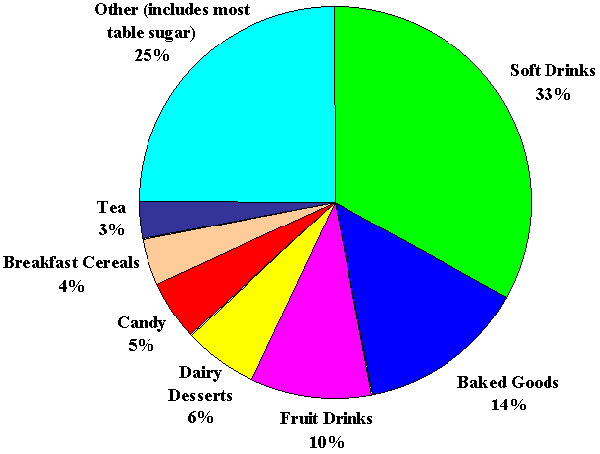 If you look at where Americans get their empty calories from, HFCS (particularly in our beverages) is high up on the list. Take a look at this graph of the sources of added sugars in our diets: From: http://www.dailykos.com/story/2008/06/29/543526/-High-Fructose-Corn-Syrup-is-Good-For-You# A new study has shown that high-fructose corn syrup (HFCS) can cause behavioral reactions in rats similar to those produced by addictive drugs such as cocaine.
According to a study presented by Francesco Leri, an addiction expert and Associate Professor of Neuroscience and Applied Cognitive Science at the University of Guelph, at the 2013 meeting of the Canadian Association of Neuroscience, food addiction could partly explain the current global obesity epidemic.
According to the “Food Addiction” hypothesis that has been proposed by some experts, one could become addicted to taste enhanced food just as one could become addicted to addictive drugs such as cocaine.
To test the hypothesis, Dr. Leri carried out a study on the response of rats to foods containing very high concentrations high-fructose corn syrup (HFCS).
In the experiments, rats were fed diets containing different levels of HFCS. They were then taught to press a lever which controlled how much syrup they received. The researchers found that rats responded to diets containing large amounts of HFCS in the same way that cocaine addicts respond when addicted to the drug. The more concentrated the syrup, the harder the rats worked at pressing the lever to obtain the taste enhanced food.
According to the researchers, the findings of their study suggest that foods with high levels of HFCS have the same addictive properties as cocaine and could partly explain the global obesity epidemic.
Leri concluded: “We have evidence in laboratory animals of a shared vulnerability to develop preferences for sweet foods and for cocaine. As you increase the percentage (of HFCS), the animals work harder and harder for each infusion. There is now convincing neurobiological and behavioral evidence indicating that addiction to food is possible.”
The findings suggest that increased availability of taste enhanced foods could explain the high global incidence of obesity. However, experts believe that availability is not enough to explain why, given the same levels of availability, some people are obese and others are not. According to Dr. Leri and his colleagues, one of the factors predisposing to obesity could be individual differences in vulnerability to addiction.
According to a former head of the FDA, David Kessler, eating sugar is “highly pleasurable. It gives you this momentary bliss. When you’re eating food that is highly hedonic, it sort of takes over your brain.”
Previous studies on cocaine use have found that although many try the drug, only a small percentage become addicted. Leri and his colleagues concluded that the same principle applies to high HFCS foods: different individuals have different levels of vulnerability to food addiction which explains why some people are obese and why some are not, in spite of the widespread availability of HFCS enhanced foods.
High-fructose corn syrup can be found in practically all fast-foods. Research has implicated the product not only in obesity but also in other diseases such as diabetes. HFCS became widely available in 1970s after it was discovered in the 1950s. It is found in processed foods such as bread, pizza, meat, donut, chocolate bars, soda, cereals, ketchup, soup, tinned tuna, mayonnaise and yougurt.
Apart from making food more palatable, it is also used to increase the shell-life of processed food products.
A 2008 study by Professor Bart Hoebel and his colleagues at Princeton University’s Department of Psychology and the Princeton Neuroscience Institute, found that rats fed on high sugar diets showed withdrawal symptoms when sugar was withdrawn from their diet. They exhibited withdrawal symptoms of stress, nervousness and anxiety, similar to those found in people addicted to drugs such as nicotine and morphine.
Hoebel said: “If bingeing on sugar is really a form of addiction, there should be long-lasting effects in the brains of sugar addicts. Craving and relapse are critical components of addiction, and we have been able to demonstrate these behaviors in sugar-bingeing rats in a number of ways.”
Leri and his colleagues investigated the behavioral, chemical and neurobiological changes induced by consumption of HFCS enhanced foods in the bodies and brains of rats. He said: “We are not rats, but our children do not think too much about the impact of sweets on their brain and behavior. There is now convincing neurobiological and behavioral evidence indicating that addiction to food is possible. Our primary objective is to discover biological predictors of vulnerability to develop excessive consumption of high fructose corn syrup.”
According to Leri and his colleagues, their findings could lead to novel pharmacological intervention for obese individuals that could help them make wiser dietary choices.
The researchers proposed that educating the public about the consequences of their dietary choices could be an effective strategy for combating the global obesity epidemic.
According to WHO, there is a worldwide epidemic of obesity, which it terms “globesity.” The distribution of the incidence is not limited to affluent industrialized societies. It occurs also in less developed economies. WHO estimates that the global incidence of obesity has more than doubled since 1980 with more than 1.4 billion people classified as overweight in 2008 and 500 million of overweight people classified as obese.
Obesity poses major health risks. The incidence of diabetes, cardiovascular diseases, hypertension, stroke and certain forms of cancer is higher among obese people.
The US Food and Drug Administration places a legal limit of 55 percent on the fructose content of HFCS. But studies have shown that fructose levels in popular soda brands are often higher than the legal limit. The Corn Refiners Association who produce HFCS have revealed that they have been producing a version of HFCS with 90 percent fructose levels for decades, although the product has never been tested for safety or approved by FDA.
|
|
High energy snacks and drinks link to bowel cancerPublished on 14/07/2013 01:06 https://www.scotsman.com/news/high-energy-snacks-and-drinks-link-bowel-cancer-1567865
By TOM PETERKIN
The scientists, from Edinburgh and Aberdeen universities, analysed the data and found a statistical association between bowel cancer patients and high consumption of what they described as “high energy snack foods” and “sugar sweetened beverages”.
The high-energy snacks covered a wide range of foods with high fat and sugar content and included crisps, biscuits, cakes, chocolates, nuts and sweets. The sugar-sweetened drinks included both fizzy and fruit drinks.
Official government surveys carried out by the Food Standards Agency have found that the intake of non-diet soft drinks, confectionery, biscuits, cakes and pastries among Scottish children – particularly in older children and those living in more deprived areas – is “considerably higher than recommended”.
Bowel cancer accounts for almost ten per cent of all cancer cases and for eight per cent of all cancer-related deaths. It is the fourth most common cancer in the UK and around 40,700 people in Britain were diagnosed in 2010 – around 110 people every day. Unlike some other cancers, rates for bowel cancer have remained relatively stable for over a decade.
Previous research has shown that there has been a north-south divide in bowel cancer incidence since at least the 1990s. The most recent data shows that the highest incidence rates are still in areas of Scotland, Northern Ireland and the north of England for males. However, a clear divide across the UK is much less evident for females.
The study, which will be published in the European Journal of Cancer Prevention, also factored in known cancer risk factors such as weight, smoking and lifestyle.
Lead author Evropi Theodoratou, of Edinburgh University’s School of Molecular Genetics and Population Health Science, said: “Some of the risk factors were novel, including the intake of ‘high-energy snack foods’ and the consumption of the sugar-sweetened beverages (SSBs). To our knowledge this is the first study to report an association between these factors and colorectal [bowel] cancer. These particular snacks and drinks have not been identified as risk factors for colorectal cancer before.”
She added: “We found that the odds of having colorectal cancer were 18 per cent higher if a diet was high in high energy snacks and sugar sweetened beverages. It is an interesting concept, because these foods are becoming more popular in western diets.”
The link remained significant when other factors such as an individual’s body mass index (a measure of weight in comparison to height) and physical activity were taken into account.
Theodoratou emphasised that although her team had found a link between foods with a high energy density and sugary drinks, there was not enough evidence to prove that they caused bowel cancer.
She said: “These positive associations do not automatically imply causal relationship between these risk factors and colorectal cancer as they can be confounded by other risk factors that we failed to account for. However, they merit further investigation from large studies as they can be very important for public health, especially since their consumption has been reported to be increasing in industrialised countries.”
The study also identified known risk factors for bowel cancer such as a family history of the disease and a high total calorie intake.
It also confirmed that taking a class of medicines called non steroidal anti-inflammatory drugs is associated with a decreased risk of bowel cancer. Commenting on the study, Jessica Harris, senior health information manager for Cancer Research UK, said: “While this study on its own can’t show for sure that these foods are linked to cancer risk, it’s still a good idea to limit the amount of high-sugar and high-calorie foods and drinks in your diet. Having too much of these types of foods can lead you to put on weight, which we know is linked to higher risks of bowel cancer.
“The best ways to reduce the risk of bowel cancer are to cut down on alcohol, get active, eat a balanced diet and aim to keep a healthy weight.”
Professor Mike Lean, chairman of human nutrition at Glasgow University School of Medicine, said: “We can’t yet start saying that this science shows that these foods cause bowel cancer. But we are fairly sure that eating more fruit and vegetables and taking more exercise can prevent cancer.
“It is always useful to have this sort of information. But it may be that part of this is that people who have cancer are inclined to blame the disease on what they eat and on the foods they believe are bad.” |
|

Over 650,000 Meals in Hospitals Will Now Be Served Without Antibiotic-Infested Meat Due to Super-Bugsby Christina Sarich June 8th, 2013 https://naturalsociety.com/650000-meals-hospitals-served-without-antibiotic-infested-meat/
Due to a precedent-setting move by the University of California at San Francisco (UCSF) Medical Center and a recent almost-unanimous vote by the Academic Senate of the university, over 650,000 meals served to hospital patients each year will now be free of meat that has been treated with antibiotics.
Livestock are often fed everything from penicillin to macrolide to ensure their health, but often to the detriment of the people who consume their meat. Ranchers and farmers discovered several decades ago that feeding their livestock just small doses of these antibiotics could fatten them up for market, and bring in larger profits. This practice isn’t often publicized, so many people are unaware of the practice. A doctor who has studied this subject Stuart B. Levy, M.D., estimates that there are 15-17 million pounds of antibiotics used sub-therapeutically in the United States each year.
What happens when humans eat antibiotic-infused meat, is that certain bacteria in the animal becomes resistant to the antibiotic and grows stronger. We consume those unsavory bacteria and can become very ill, and then trying to treat us with antibiotics becomes impossible. This situation is much like the super-weeds that are growing due to the over-use of Monsanto’s GMO poison, Roundup, the good bacteria cannot over-run the bad. We then create super-bugs that are resistant to any type of treatment.
Opposing this argument is Dr. Margaret Mellon, with the Union of Concerned Scientists, “There is no evidence that antibiotic resistance is not a problem, but there is insufficient evidence as to how big a problem it is.” If this were true, why did methicillin resistant staphylococcus aureus (MRSA) get a foothold in the 1960s ? The overuse of antibiotics in general has already caused several cases of superbugs.
It is no surprise that hospitals are interested in changing their meat procurement practices, since the primary means of treating an ill person in the hospital is either through surgery or pharmaceutical drugs, but what does this issue of Super Bugs have in common with Super Weeds? It seems quite obvious that messing with Mother Nature results in some pretty fantastic tragedy for the human race. |
|
Reverse Heart DiseaseA Simple DIY Therapy that Could Prevent and Reverse Heart Diseaseby Paul Fassa June 10th, 2013 https://naturalsociety.com/diy-vitamin-c-therapy-could-prevent-reverse-heart-disease/
A little over a two decades ago, two time Nobel Prize winning chemists Linus Pauling, PhD, and Dr. Mathias Rath, MD, developed a DIY protocol anyone can do to prevent and reverse cardiovascular disease. DIY means do-it-yourself, as in you don’t need to be supervised with its application and it’s probably not expensive.
They realized first that humans generally suffer from insufficient vitamin C since their bodies lack the gene to create it while most other mammals are able to create their own vitamin C. This leads to chronic sub-clinical scurvy, an invitation to other diseases, including heart disease.
They also discovered that only a particular subtype of LDL cholesterol, Lp(a), was the source of arterial wall damage that leads to arterial inflammation and plaque accumulation.
It’s a sticky small heavy molecule that manages to slip under the endothelial tissue of the arteries interior walls with the capacity to bind fibrin and membrane proteins of endothelial cells and monocytes, of which some are the immune system’s killer cells.
Lp(a) also stops plasminogen binding and plasmin generation. The inhibition of plasmin generation and the accumulation of Lp(a) on the surface of fibrin and cell membranes permits fibrin and cholesterol deposition at the sites of vascular injury.
So Lp(a) lipoproteins attacking weakened blood vessels is the major physiological source of cardiovascular disease.
Related Read: Over 7 Signs You’re Vitamin-C Deficient Here’s that Simple Double-Barreled Supplement ProtocolCommon sub-clinical scurvy among humans is the background for weakened arteries and other blood vessels, as well as the heart’s own endothelial tissue. Two supplements were discovered that could strengthen blood vessels and remove Lp(a) lipoproteins from inner blood vessel walls.
Increased vitamin C was called upon to strengthen blood vessels and arteries with better flexibility by creating and adding collagen to blood vessel tissues. Collagen is the strong, fibrous stuff of flexible connecting tissue. Vitamin C needs to be continually replaced because it is destroyed by creating collagen.
The type of vitamin C supplement recommended is simply ascorbic acid. Two to three grams orally on a daily basis is recommended as a preventative, but that can be doubled if one has already had heart problems. A fat based derivative of ascorbic acid, ascorbyl palmitate, permits lower doses of vitamin C because its fat base makes it easier for fatty tissue cell walls to assimilate it.
Another recent innovation of ascorbic acid lipid encapsulation comes with Lyposomal C, which allows for even lower doses of vitamin C to create the same effect of even mega-dose IV ascorbate vitamin C.
The other barrel shoots an inexpensive oral supplement into your blood vessels to scoop out the existing Lp(a) lipoproteins and prevent new ones from attaching to blood vessel walls.
Linus Pauling recommended 2 grams of inexpensive amino acid lysine or L-lysine oral supplements daily along with his recommended ascorbic acid levels of 3 grams. If one is at higher risk or has already had serious heart health issues, he recommended doubling those amounts. The total daily dosage can be broken down to half the amount twice daily or one-third the amount three times daily.
It doesn’t get any easier than that. The study and subsequent paper from Linus Pauling and Mathias Rath MD was submitted circa 1990 to the Proceedings of the National Academy of Sciences USA. It was at first accepted but then rejected and not published.
This was part of the medical mafia’s marginalizing vitamin C preventative and curative efficacy for many diseases that had began in the late 1970s, even to the point of calling Linus Pauling a quack.
It’s wise to ignore those who want you as a steady customer for heart related surgeries and statin drugs or other expensive pharmaceuticals
Instead, simply take advantage of this simple DIY therapy with one caveat: People who overcame serious heart health issues using this protocol were feeling so good they tended to drop the daily protocol. Then months later they had a heart health relapse.
Although improved health may allow for less intake, it’s recommended one keeps taking minimal dosages of those two supplements daily: ascorbic acid or ascorbate vitamin C and lysine or L-lysine Additional Sources: |
|

Don’t want additives and chemicals in your snacks? Avoid these 11 BANNED ingredients in foods that Americans are STILL eating06August2020 / By Divina Ramirez https://frankenfood.news/2020-08-06-11-banned-ingredients-foods-americans-are-still-eating.html Colored candies and hormone-packed meats are the norm in the U.S. and are not something most people second-guess before eating. But a lot of the foods that Americans eat on the regular are banned in countries across the globe.
Ocean Robbins, an adjunct professor in Chapman University’s Peace Studies Department and the chief executive officer of the Food Revolution Network (FRN), notes that a number of ingredients linked to chronic conditions, such as cancer, heart disease and diabetes, are still in use across the U.S. despite being banned in other countries.
This might explain the prevalence of these conditions in the U.S. despite being preventable diseases, Robbins adds. Banned ingredients are still in use across the U.S.It’s not uncommon for foods in the U.S. to contain additives, hormones and other substances that pose serious risks and consequences for human health. 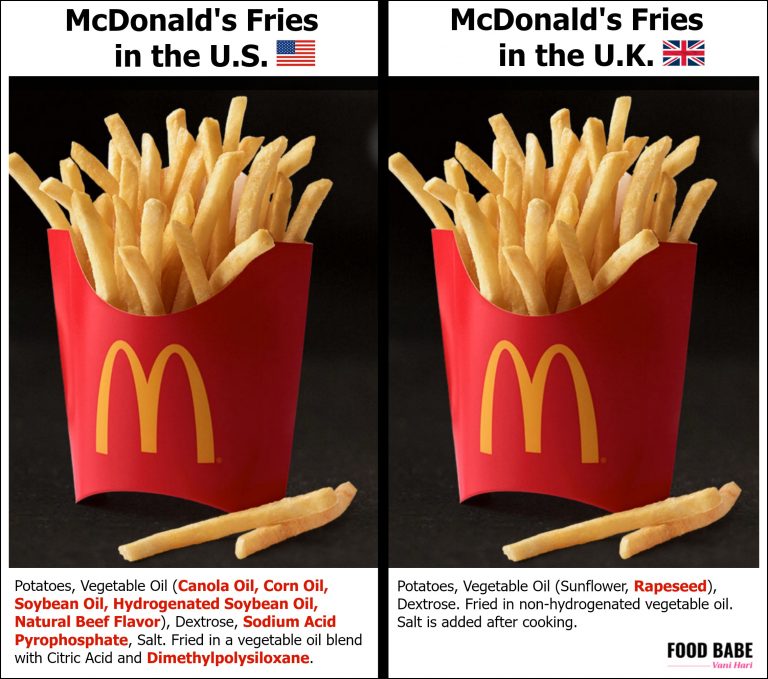 McDonalds fries in US vs UK Furthermore, a lot of the chemicals and substances banned in other countries are those that the FDA deems “generally recognized as safe” (GRAS). As such, these ingredients are exempt from other tests that the FDA might require.
Robbins also questions the expertise of the authorities marking chemicals and substances as GRAS, citing that members of the panels tasked to evaluate ingredients have financial ties to all manners of industries.
Most of the chemicals on the GRAS list have also not had long-term testing on humans, Robbins adds. Therefore, these cannot be guaranteed 100 percent safe for consumption.
On that note, here are some of the most infamous food ingredients banned in other countries but not in the U.S. Dough conditionersChemicals like potassium bromate and azodicarbonamide are often used to improve the texture of bread dough, hence their name. Scientists find that dough conditioners are potential carcinogens or cancer-causing substances. Studies also found that dough conditioners can cause breathing difficulties. Brominated vegetable oilBrominated vegetable oil or BVO is, first and foremost, a flame retardant. But this chemical can be found across various processed drinks including sodas and sports drinks. Research finds that BVO accumulates in human tissue, causing major organ damage and birth defects. PropylparabenIn the U.S., this substance is used as a preservative to keep pre-made tortillas, muffins, pies and other baked goods from spoiling. But ongoing animal research suggests that propylparaben can affect sex hormones and sperm count in male rats. Scientists also found that propylparaben exposure is linked to breast cancer. BHA and BHTButylated hydroxyanisole (BHA) and butylated hydroxytoluene (BHT) are synthetic antioxidants used as preservatives in cosmetic products, but they are also used in foods. Both BHA and BHT are possible carcinogens and hormone-disrupting substances. Synthetic food dyesSynthetic dyes are used to enhance the color of foods and make them more appealing to consumers. But recent studies found that these colorings are linked to a heightened risk of developmental problems in children. Genetically modified organismsCrops like soy, corn, cotton and alfalfa are genetically modified organisms (GMOs) and a number of European have long since banned them due to public health safety concerns.
GMOs are made through genetic manipulation to make them develop certain characteristics, such as being resistant to herbicides or being seedless. One of the most common herbicides used to condition crops to become resistant is glyphosate, and studies have found that glyphosate consumption is linked to cancer. RoxarsoneRoxarsone is an arsenic-based drug added to chicken feed to increase chickens’ muscle mass but reduce their feed consumption. Arsenic is toxic in its inorganic form, such as those used in bronzing or making special glass. Studies reveal that chronic exposure to arsenic can lead to chronic diarrhea, heart disease, numbness and even cancer. RactopamineRactopamine is another drug used to increase the muscle mass of pigs, cattle and turkeys. This substance can end up inside humans through the consumption of contaminated animals.
Countries like Russia, China and most European countries have banned these substances because it has been found to pose serious consequences on human reproductive and cardiovascular health. Herbicides, insecticides and fungicidesThese products are still commonly used on crops across the U.S. Herbicides, insecticides and fungicides have been extensively studied in the past for serious risks and dangers they pose on human health, including cancer and birth defects. (Related: Glyphosate herbicide disrupts the development of the uterus, affects female fertility.) OlestraOlestra is a fat substitute used to keep the cholesterol content of potato chips and french fries at a minimum. But an emerging body of evidence suggests that olestra can cause gastrointestinal problems, including diarrhea and leaky gut syndrome. Synthetic hormonesRecombinant bovine growth hormones (rBGH) and recombinant bovine somatotropins (rBST) are synthetic hormones fed to cows to fatten them up and increase their milk production. In humans, these synthetic hormones can heighten the risk of cancer. Minimizing the risk of exposure to harmful ingredientsIt’s near impossible to control the ingredients and chemicals that manufacturers put into their products. Nonetheless, there are doable steps one can take to minimize his or her exposure to these ingredients. Here are some of them:
Most processed foods contain harmful ingredients that pose certain health risks to consumers. Make it a habit to inspect food labels, or practice cutting back on processed foods. If sustained, these little changes can lead to safer food choices and healthier eating habits in the long run. Read more articles about the dangers of harmful ingredients in junk foods and processed foods at StopEatingPoison.com. Sources include: |
|
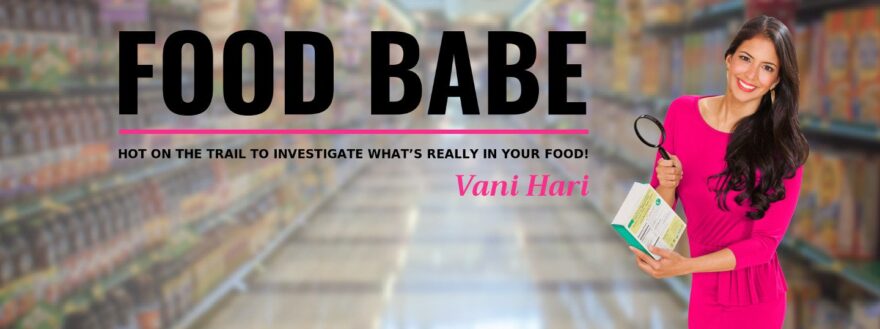
Food in America compared to the U.K. (Why is it so different?)By Food Babe https://foodbabe.com/food-in-america-compared-to-the-u-k-why-is-it-so-different/ Want to know what really opened up my eyes to how food companies exploit us? I spent years investigating the differences between European and American food products, and what I found disgusted me. A college buddy of mine decided to go live in London for a few years. While she was there, I often had her go to Tesco and other European grocery stores to take pictures of the ingredient lists for me and send me boxes of products. I’d compare them with the same brand of American products side-by-side and saw completely different ingredient lists. Companies like Kraft-Heinz, Kellogg’s, PepsiCo, and Quaker sell safer, better products oversees while making inferior versions to sell to Americans. The evidence of this runs the gamut from fast food places to boxed cake mix to cereal to candy and even oatmeal— you can’t escape it. This is what set me down the path of advocating for change in the food system and I’ve never looked back. Here are 6 American products that are completely different overseas…1. McDonald’s French Fries McDonalds fries in US vs UK
Let’s start with McDonald’s French Fries. They make their iconic french fries in the U.K. with a few simple ingredients: potatoes, oil, dextrose, salt—but in the U.S they’re made with “natural beef flavor” and sodium acid pyrophosphate, and are fried in oil laced with the anti-foaming agent dimethylpolysiloxane – the main ingredient in silly putty (1). They’ve somehow figured out how to cook their fries without all these extra ingredients overseas, so why not here? 2. Quaker Instant Oatmeal Packets
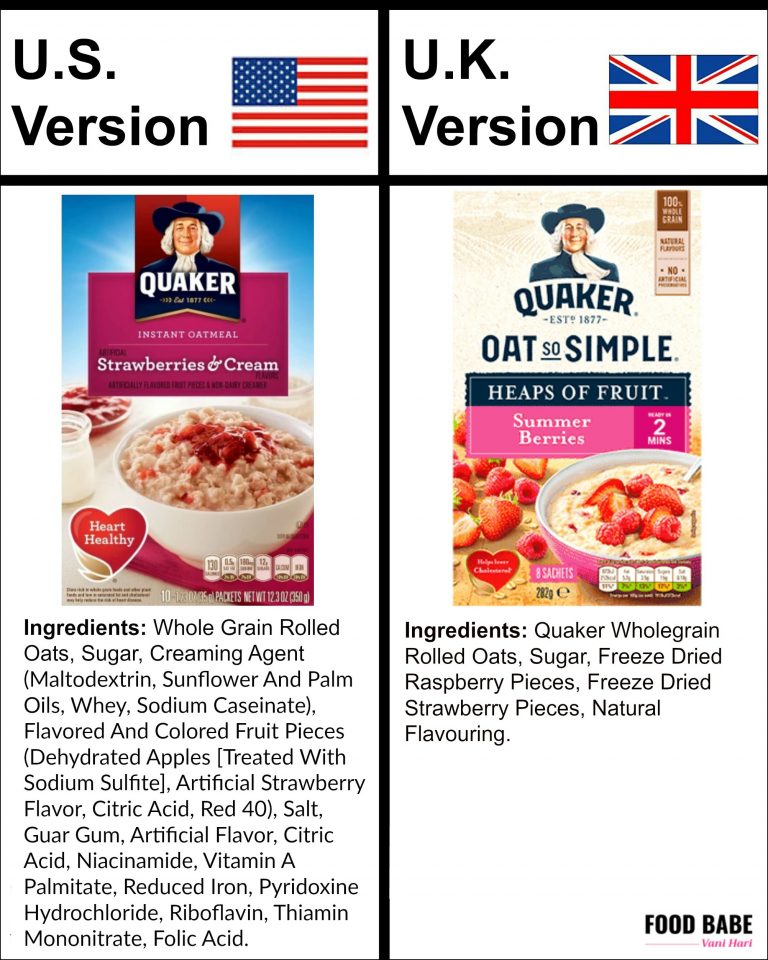 US vs Uk Quaker Oats packets ingredients Foodbabe.com Did you know Quaker Oats Strawberries & Cream has ZERO strawberries? In the U.S. Quaker mimics the look and taste of real strawberries by using “Flavored and Colored Fruit Pieces” comprised of dehydrated apples, artificial strawberry flavor, citric acid, and the artificial dye Red 40. It’s a total scam!
Meanwhile in the U.K. Quaker doesn’t even attempt to sell that garbage and doesn’t make any products like this. The closest counterpart they have is a product called “Oat So Simple” that has REAL strawberries in it—light years ahead of the popular U.S. version made with artificial dyes and artificial flavors. 3. Mountain Dew
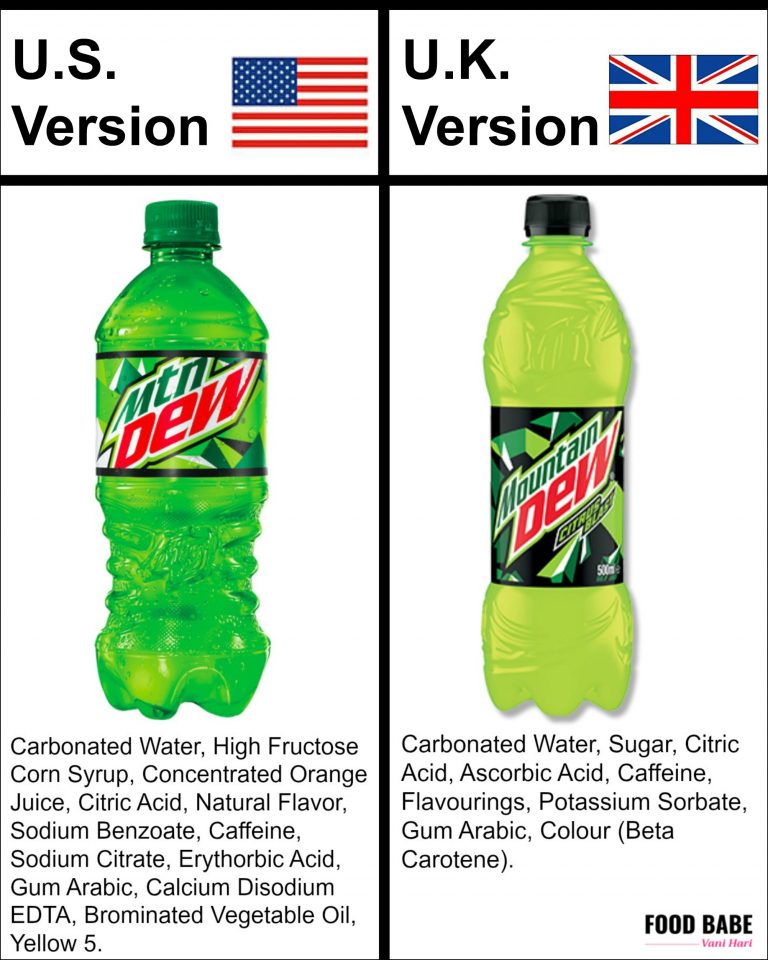 US vs Uk Mountain Dew ingredients Foodbabe.com Pick up a bottle of Mountain Dew in the U.K. and you’ll find that it gets its bright yellow color simply from beta carotene (a natural color derived from carrots and other plants). Meanwhile, PepsiCo sells a very different version of Mountain Dew in America. Here in the States, instead of using natural colors to give it a tantalizing look, Mountain Dew is artificially colored with a petroleum-based dye called Yellow #5. Although artificial dyes are common in America, that doesn’t make them okay to eat. They’ve been linked to several health issues and may be contaminated with carcinogens (2). They certainly are not as safe as beta carotene. And it gets worse…
The U.S. version of Mountain Dew contains brominated vegetable oil (BVO) – which is an ingredient BANNED in Europe (3). Way back in 2014, PepsiCo announced they would remove BVO from all of their American drinks following a successful petition by activist Sarah Kavanagh (4). But they still have not removed BVO from Mountain Dew, nearly 5 years later. Meanwhile, they continue to sell BVO-free Mountain Dew in other countries. 4. Heinz Ketchup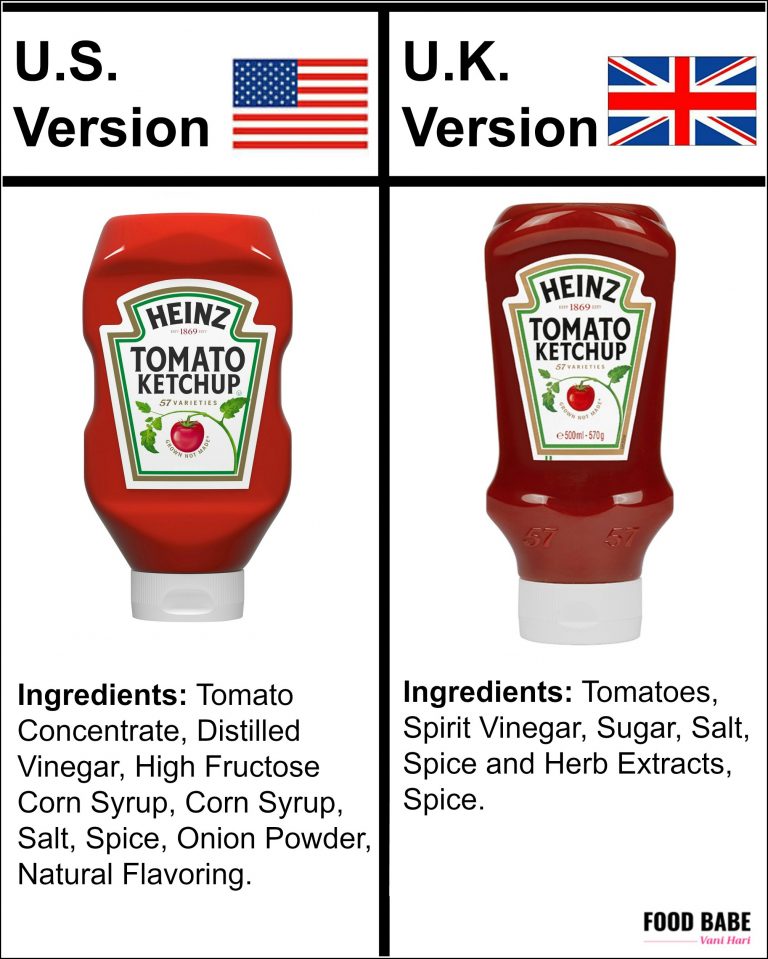 US vs Uk Heinz ketchup ingredients Foodbabe.com You know what you’ll find in almost every restaurant in America? Heinz Tomato Ketchup. Heinz ketchup is GMO-free in the U.K. (5) but full of GMOs and High Fructose Corn Syrup in the U.S., along with lab-produced “natural flavoring” that helps create an addiction to their product (6). Think of this next time you’re dipping your fries in and can’t stop! While Heinz makes a “Simply Heinz” version of ketchup in the U.S. (still with natural flavors but a cleaner ingredient list), why don’t they just make this their regular ketchup? There is no need for the heavily processed version that you’ll find in most restaurants and homes in America. 5. Doritos
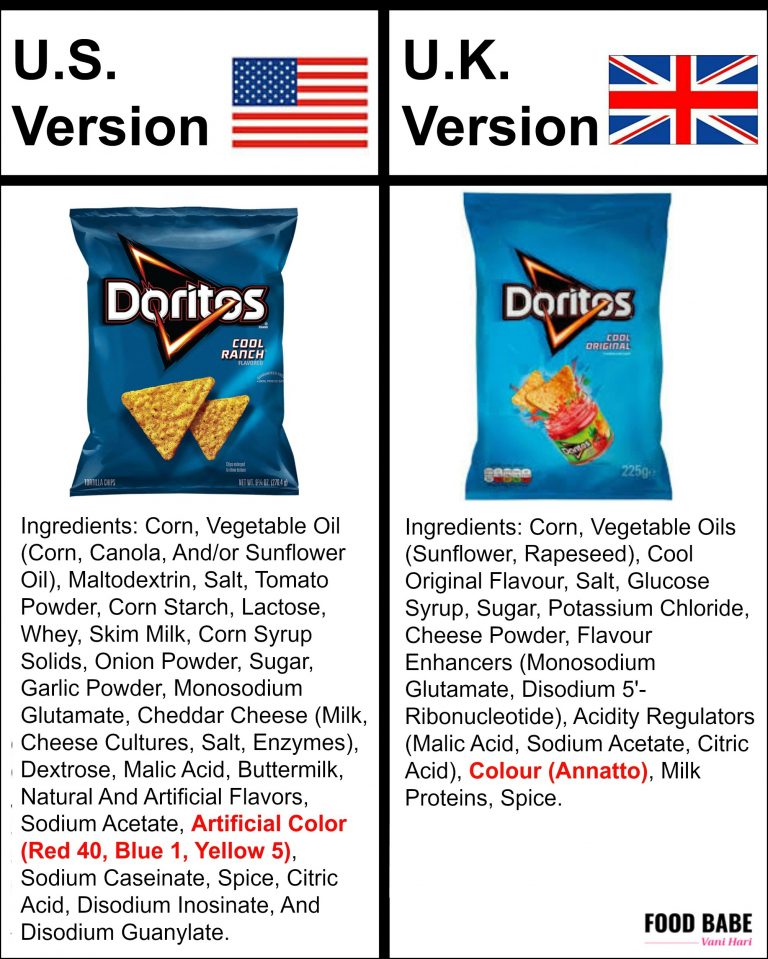 US vs Uk Doritos ingredients Foodbabe.com Both versions of Doritos are horrible, but American Doritos are covered in artificial dyes made from petroleum (Red #40, Blue #1, and Yellow #5). These dyes have been found to be contaminated with carcinogens, such as benzidine (2) In the U.K., these dyes require a warning label that says “May Have an Adverse Effect on Activity and Attention in Children” (7). No one wants to put that on their product! That’s why they don’t use artificial dyes in Doritos overseas and instead color Doritos more simply with paprika extract and annatto. The Doritos in the U.K. are also non-GMO, while the American versions are made with GMO corn contaminated with glyphosate weed killer (8). 6. Kellogg’s Frosted Flakes Cereal
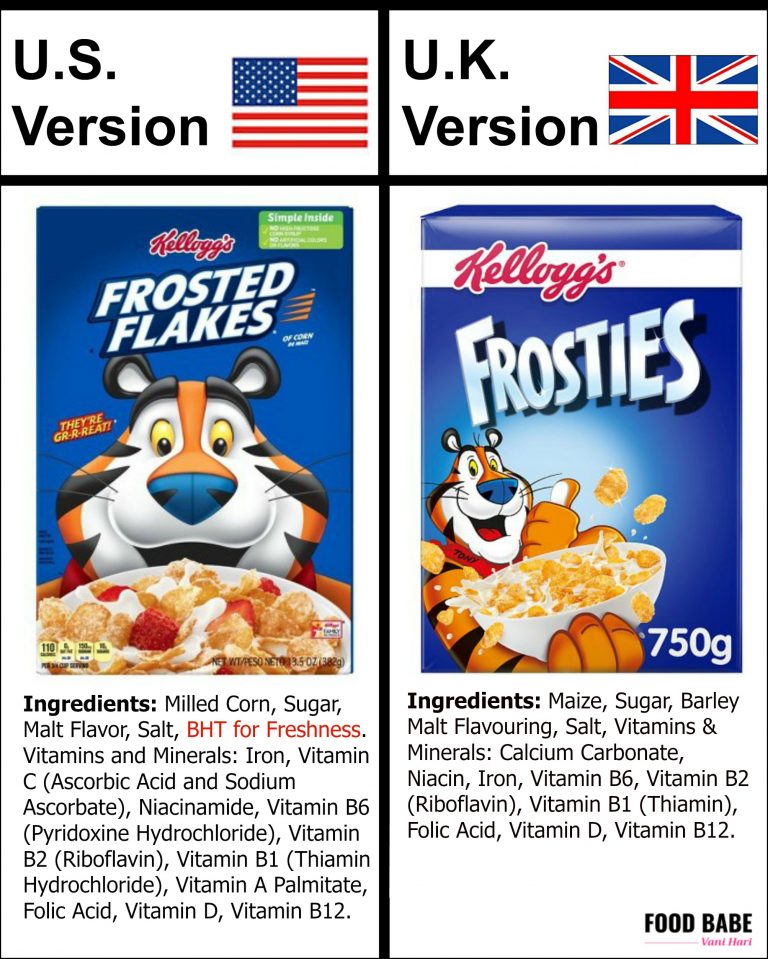 US vs Uk Kellogg’s Frosted Flakes Cereal ingredients Foodbabe.com At first glance the ingredients in Frosted Flakes in the U.S. and U.K. look nearly identical. The main difference is the addition of the preservative BHT (butylated hydroxytoluene) in the U.S. version. Controversial research links BHT to cancer (9) and it’s believed to be an endocrine disruptor that interferes with your hormones (10) BHT isn’t permitted in cereals in Europe, so Kellogg’s reformulated their cereals to sell them legally overseas. Following our 2015 petition to get BHT out of American cereal (11) Kellogg’s removed BHT from several brands (like Rice Krispies), but still use it 4 years later in Frosted Flakes despite selling it BHT-free in the U.K. Why don’t these companies just sell the same, safer, products everywhere?I’ll tell you why. Europe takes a “precautionary principle” approach towards food additives that are potentially risky. They ban or add warning labels to these additives for their citizens. The U.S. takes the opposite approach. It does not remove additives from our food supply until they have been proven dangerous – which can take a very long time and a lot of red tape. This means Americans are literally the lab rats.
The U.S. government allows food companies to largely police itself, deciding which ingredients, chemicals, and additives are “safe” to use in their products (12). This clearly isn’t a wise approach – is it?
If a company can get away with using cheaper ingredients, they will. Given a choice, they’ll always opt for the cheaper flavor enhancer, and the cheaper color additive, and the cheaper preservative, and the cheaper GMO ingredient, even if these cheaper alternatives have a negative impact on our health. The truth is that nobody is watching out for us. When they tell you they know their processed foods are safe, they are telling you a lie.
I dedicated an entire chapter in my latest book, Feeding You Lies, to this subject because there is so much more you need to know! The food industry doesn’t care about your health, so you really need to. It is now available in bookstores everywhere. If most Americans knew food companies are selling similar products overseas with healthier ingredients, they’d be outraged. I know I am.Please share this post with all of your friends. Everyone should know how food companies are scamming Americans with inferior products. This will also inspire these companies to do better and sell safer products in the U.S. Don’t believe me? Look what happened to Kraft Mac & Cheese! Xo, Vani References:
|
|

80% of Processed Foods in US Are Banned In Other NationsRead more: https://naturalsociety.com/80-percent-processed-foods-us-banned-other-nations/#ixzz6auTZuiZ5
I write a lot about the dangers of processed foods when it comes to wreaking havoc on our health, but even I was surprised to find that 80% of pre-packaged foods sold in the United States are actually banned in other nations. And for good reason.
Whether it’s toxic soda brands like Mountain Dew, or sugary artificial cereals and carcinogenic ‘potato’ chips, around 80% of the processed food variety within the US actually contains ingredients that are banned around the world in countries like Canada and the United Kingdom. As a matter of fact, sometimes they’re banned throughout the entire European Union. The FDA, however, seems quite alright with these disease-linked substances lurking within the food supply.
And the USDA? Oh, well they also went ahead and approved the very same toxic pesticide that the EU banned just days earlier over significant health concerns and links to the destruction of the bee population — a population which we need in order to generate a staple crop supply for the entire globe. Banned Ingredients In Your FoodAccording to a report in Yahoo Sunshine, a team of researchers actually went in and discovered the percentage of items banned based on the examination of ingredients the products contain that were banned across the globe.
Meanwhile, Americans are being sold these ‘food’ products throughout the nation via deep discounts and heavy promotions through their local grocery stores. And what does the government have to say?
The same government that cracks down on raw milk and natural supplements. Well, the US government goes ahead and allows for Big Food corporations to unleash their entire medley of health-crushing ingredients within the food supply, and then uses phony corporate science to say that it’s ‘unscientific’ to criticize these companies for their complete lack of concern for public safety.
The bottom line? Ditch any processed food you may be consuming, and don’t be fooled by phony Big Food corporate science. Over 80% of what’s considered food here in the US has been banned in other nations, and citizens there would never dream of eating the yoga mat chemicals that we call chicken nuggets here in the USA. |
|
|
|
1. Artificial food dye: Makes your food pretty and can inhibit nerve-cell development.Found in: Practically everything we eat: cake mixes, sports drinks, cheese, candy, and even MACARONI AND CHEESE. Why it’s dangerous: Artificial dyes are made from chemicals derived from petroleum, which is also used to make gasoline, diesel fuel, asphalt, and tar! Artificial dyes have been linked to brain cancer, nerve-cell deterioration, and hyperactivity in children, just to name a few. Where it’s banned: Norway, Finland, Austria, France, and the U.K. |
2. Olestra (or Olean): Lowers calorie counts while causing vitamin depletion and anal leakage.Found in: Fat-free potato chips, corn chips, and French fries. Why it’s dangerous: Created by Procter & Gamble as a substitute for cooking oil, Olestra robs your body of its ability to absorb vitamins. Fun side effects include cramps and leaky bowels. Where it’s banned: The U.K. and Canada. |
3. Brominated vegetable oil: Makes food dye stick to liquid, but also may cause birth defects and major organ damage.Found in: Sports drinks and citrus-flavored sodas. Why it’s dangerous: Bromine is a chemical used to stop carpets from catching on fire, so you can see why drinking it may not be the best idea. BVO is linked to major organ system damage, birth defects, growth problems, schizophrenia, and hearing loss. Where it’s banned: In over 100 countries. |
4. Potassium bromate (or bromated flour): Great for impatient bakers, bad for your kidneys and nervous system.Found in: Wraps, rolls, bread crumbs, bagel chips, flat breads. Why it’s dangerous: Derived from the same harmful chemical as brominated vegetable oil, brominated flour is used to decrease baking time and reduce costs. Only problem is, it’s linked to kidney damage, cancer, and nervous system damage. Where it’s banned: Europe, Canada, and China. |
5. Azodicarbonamide: Bleaches flour, plastic, and induces asthma as an added bonus.Found in: Breads, frozen dinners, boxed pasta mixes, and packaged baked goods. Why it’s dangerous: Used to bleach both flour and foamed plastic (yoga mats and the soles of sneakers), azodicarbonamide has been known to induce asthma. Where it’s banned: Australia, the U.K., and most European countries. |
6. BHA & BHT: Waxy preservatives linked to cancer and tumors.Found in: Cereal, nut mixes, gum, butter, meat, dehydrated potatoes. Why it’s dangerous: Used to keep food from becoming rancid, butylated hydroxyanisole (BHA) and butylated hydroxytoluene (BHT) are known to cause cancer in rats. And we’re next! Where it’s banned: The U.K., Japan, and many other European countries. |
7. Synthetic growth hormones rBGH and rBST: Harmful to cows and linked to increasing tumor development in humans.Found in: Milk and dairy products. Why it’s dangerous: Growth hormones are bad for cows and people, potentially causing infertility, weakened muscle growth, and a whole array of cancers. Where it’s banned: Australia, New Zealand, Canada, Japan, and the EU. |
8. Arsenic: Basically this fish will slowly kill you.Found in: Poultry. Why it’s dangerous: Used in some chicken feed to make meat appear pinker and fresher, arsenic is poison, which will kill you if you ingest enough. Where it’s banned: The EU. |

10 American Foods That Are Banned InternationallyBy Health Fitness Revolution Americans are slowly waking up to the sad fact that much of the food sold in the US is far inferior to the same foods sold in other nations. In fact, many of the foods you eat are BANNED in other countries There are many examples where the US federal regulatory agencies have sold out to industry at the expense of your health. About 90% of the money Americans spend on food is spent on processed foods, which is far too high a statistic. If you want to avoid these questionable foods and other potentially harmful ingredients permitted in the US food supply, then ditching processed foods entirely is your best option.
Next, you’ll want to swap out your regular meat sources to organic, grass-fed/pasture-raised versions of beef and poultry. The same goes for dairy products and animal by-products such as eggs. Swapping your processed-food diet for one that focuses on fresh whole foods is a necessity if you value your health. Frischer Atlantischer Lachs mit Meersalz, Pfeffer und Gewürzen
Macro closeup of iced tea or soda with ice cubes and straw in glass
Sliced loaf of artisanal bread and butter knife on linen cloth close-up, selective focus.
|
|

More toxic to humans than high fructose corn syrup, this dirty little secret ingredient is COMMON in U.S. foods (and beverages)Saturday, September 15, 2018 by: S.D. Wells https://www.naturalnews.com/2018-09-15-more-toxic-to-humans-than-high-fructose-corn-syrup-this-dirty-little-secret-is-common-in-u-s-food.html (Natural News) Ever wonder why one third of all Americans get cancer at some point in their lifetime, even though hardly anyone got it a century ago? How about leukemia, do you think it’s hereditary? You would be dead wrong. A common ingredient in soft drinks and most jarred peppers and pickles causes leukemia, but no medical doctor in America has been authorized to talk about it, and most of them have no clue anyhow.
What’s the poison? It’s called sodium benzoate, and you’ll find it in popular paint stripper products, permanent spot removers, rubber cements, and lots of U.S. food products all approved by the FDA for human consumption. Sodium benzoate was banned from the rubber making industry because many workers exposed to it developed leukemia and diedSodium benzoate is made by mixing sodium hydroxide with benzoic acid, which gives it highly destructive, solvent qualities. In Europe, the media is screaming to ban this toxic “preservative” as it may be interfering with normal development of children. The U.S. mass media, of course, won’t utter a word about it. Scientists fear conducting research on sodium benzoate, as they might get “suicided” by Big Food and Big Pharma, as so many cancer researchers, holistic doctors, and vaccine researchers have encountered.
Sodium benzoate is a known carcinogen that deprives the human cells of oxygen, breaks down the immune system and causes blood cancer to develop. On product ingredient labels, you’ll see the phrases, “to preserve freshness” or “as a preservative.” That’s so you’ll feel safe and cozy when your brain ingests those happy slogans, but what your body is attempting to digest is a dangerous concoction that’s been synthesized in a laboratory using chemicals.
The power of the elements: Discover Colloidal Silver Mouthwash with quality, natural ingredients like Sangre de Drago sap, black walnut hulls, menthol crystals and more. Zero artificial sweeteners, colors or alcohol. Learn more at the Health Ranger Store and help support this news site.
It gets even worse. When sodium benzoate is combined with vitamin C or E, benzene is formed. That’s where the leukemia kicks in full gear. At the cellular level, sodium benzoate deprives mitochondria of oxygen, sometimes completely shutting down the “power station” of your cells. It’s programmed cell death, and when cells are deprived of oxygen, they fail to fight off infection and disease, including cancer – the mutation and uncontrolled division of cells. Sodium benzoate extends the shelf life of foods and beverages, while shortening the life of humans that consume it regularlyCheck your salad dressings, jams, soy sauce, vinegar, fruit juices, salsa, dips, shredded cheeses, sodas, mouthwash, toothpaste, cough syrups, and hundreds of cosmetic products for the known toxic agent and carcinogen sodium benzoate. It’s the cheapest mold inhibitor on the market, but it robs the human body of essential nutrients, thus aiding and abetting chronic neuro-degenerative diseases like Parkinson’s and Alzheimer’s.
The chemical-laden-food industry of the U.S. is well-protected. No research has been done by the FDA to protect consumers from cancer-causing additives and preservatives in foods, not even on nitrates and nitrites (the latter being the number one group of cancer causing additives). Sodium benzoate is especially dangerous because it destroys parts of your DNA. It specifically attacks the mitochondria – cells that use oxygen to produce energy. Mitochondria control the cell life cycle and cell growth.
U.S. federal safety rules limit benzene levels at 5 ppb (parts per billion) in drinking water, but for some unknown reason (money), manufacturers of sodas are immune to this safety regulation. Some soft drinks are jacked up with more than 100 ppb of benzene, and that’s twenty times more than the maximum “safe level” for humans, even though no level is safe for consumption at all. The dangers of sodium benzoate consumption have been well-known since the early 1990s. But hey, if you “feel like drinking a diet soda” just do it, because your insurance will surely cover the chemotherapy later, right? Read the labels on everything folks. Know the toxins. Don’t eat cancer! Avoid sodium benzoate, aspartame, sucralose, and canola like the plague. This has been a public service message from Natural News. Check NaturalPedia.com and FDA.news for more information on foods and supplements that are safe (or not safe) for consumption. Sources for this article include: |
|

Research confirms link between exposure to formaldehyde and risk of dementia, depression and diabetesSunday, March 24, 2019 by: Tracey Watson
(Natural News) When you hear the word formaldehyde, what do you think of? Does it conjure up images of gloomy mortuaries and dead bodies? If so, you’re not alone – most of us associate this chemical with the preservation of tissue in a laboratory environment.
You may, therefore, not be aware that formaldehyde is actually pervasive in our environment. Used in everything from plywood to fabrics, glue and insulation materials, formaldehyde can be found all around us – including in the air we breathe.
Why is this a problem? Well, exposure to formaldehyde has been linked to an increased risk of cancer, glaucoma, stroke, Alzheimer’s disease and other serious health conditions. And a study by researchers from Aston University in the United Kingdom, published in the journal Aging and Disease, found that formaldehyde exposure could be a contributing cause in the development of depression, diabetes and dementia. The study focused on a natural solution to the problem: supplementation with the powerful antioxidant, carnosine.
Link between formaldehyde and age-related conditionsSeveral studies have confirmed a link between formaldehyde exposure and the dangerous trio of depression, diabetes and dementia. Natural Health 365 explains the reason for this link:
Researchers are now finding that exposure to formaldehyde causes a harmful cross-linking of the body’s proteins – the same process that occurs in the presence of high blood sugar. (Also known as glycation, cross-linking from high blood sugar can damage cells, and cause portions of the body’s tissues to become non-functional).
Intriguingly, the team found that formaldehyde decreases the availability of the neurotransmitter norepinephrine – which influences learning, memory and mood – thereby yielding a possible clue to formaldehyde’s role in triggering age-related memory decline.
Researchers have found that formaldehyde is a contributing factor in several age-related conditions because of this dangerous cross-linking process. Formaldehyde and cancerFormaldehyde exposure has also been strongly linked to the development of several cancers. In fact, the World Health Organization’s International Agency for Research on Cancer (IARC) classifies formaldehyde as a human carcinogen (cancer-causer).
As reported by the National Cancer Institute (NCI), a study conducted by the NCI, which examined the effects of occupational formaldehyde exposure on 25,619 workers, confirmed an “increased risk of death due to leukemia, particularly myeloid leukemia, among workers exposed to formaldehyde.” Follow-up studies with the same participants, a decade later, confirmed the initial results.
A study conducted by the National Institute for Occupational Safety and Health (NIOSH) also confirmed a link between formaldehyde exposure and death from leukemia. Formaldehyde in vaccinesAs noted at the outset, formaldehyde is pervasive in our environment and to a large extent exposure is unavoidable. Nonetheless, there are some areas in which we can either choose to accept or avoid such exposure.
Vaccines present one such choice.
Formaldehyde is used in very small quantities in vaccines to inactivate living pathogens. While one vaccine only contains about 100 mcg of formaldehyde, children receive a large number of vaccinations over a short period of time. In fact, kids who receive all the CDC-mandates vaccines are injected with a whopping 1,795 mcg of formaldehyde.
While each family needs to decide for themselves whether the benefits of vaccines outweigh the risks, it is always good to be in possession of all the relevant information when making such decisions. Carnosine reduces the risks of formaldehyde exposureThe study cited at the outset confirmed that carnosine – a protein building block produced naturally by the body – suppresses the dangerous cross-linking caused by formaldehyde. Previous studies have found that it also slows down the aging process and dramatically extends lifespan. Natural Health 365 reported:
In addition, carnosine’s anti-glycation properties help to prevent LDL cholesterol from forming arterial plaque, thereby protecting against atherosclerosis and diabetic damage.
Other carnosine-derived boons to cardiovascular health include its capacity to lower blood pressure in obese individuals, and its ability to protect against reperfusion injury – damage caused by the rebounding of oxygen-rich blood into tissues after a heart attack.
For good measure, carnosine has been shown in cell studies to delay senescence – a cellular consequence of aging that causes tissue and organ failure.
While carnosine is found naturally in red meat, this amino acid breaks down rapidly in the body, making reaping its benefits a little tricky. For this reason, supplementation with a high-quality, organic supplement is advisable. Sources include: |
|

PRODUCT POLICE 101: Eliminate these common toxins from your daily intake and improve your health tenfold10 March 2019 / By S.D. Well https://frankenfood.news/2019-10-03-eliminate-common-toxins-diet-improve-health.html Sure, you need some good recipes or some great restaurants if you want to find tasty food these days, especially food that also happens to be healthy for you, but the daunting task is eliminating toxins that ruin almost any dish and any meal by sabotaging the “good stuff” with “food stuff” that’s not even really food at all.
The product police have been running the gamut for a couple decades now, and most health enthusiasts know better than to eat the most popular toxins, but still, people attempt bizarre diets, over-celebrate holidays, travel and eat “whatever,” and then they slip back into bad habits and become human filters for poison. That’s what it really boils down to, and your cleansing organs pay the ultimate price.
The top 10 food toxins break down, burden, and literally deteriorate the lining of your kidneys, your liver, and your pancreas, restricting normal function. Then comes chronic inflammation. Then comes the pain, the itching, the intolerable headaches. Then come the crippling symptoms. One after another. That’s the Standard American Diet at work on you. SAD: Eat toxic food and listen to bad MD adviceThat’s when M.D.s (medical dieties) sling chemical experiments down your throat (prescription medications) to address all the warning signs of T.F.D. (toxic food disorder), without ever addressing a single one of the top 10 food toxins. Medical doctors simply do not ask you about food. They’re not allowed to, or the AMA will come suspend their license until they remember where they came from (think Flexner Report here).
Are you constantly lacking energy? Do you feel like the “aging process” is getting the better of you? Has every diet in the world failed to meet your expectations? You’re not alone. Ideal health and longevity are really not about any kind of diet anyway. It’s about whole food and 70 percent raw food. It’s about organic, unadulterated plant-based food. If it’s processed in any way, you’re losing nutrition and asking for trouble.
Corporations use toxic additives and preservatives to make money, not to protect you from anything. They protect themselves from lawsuits. They add shelf life to products while shortening human life. It’s always only about the money. So here they come. Did you forget about some of these horrific “food stuff” ingredients? 10 Food toxins you should stop consuming immediately#1. Canola oil – coagulates in your blood, causing weight gain, hypertension, inflammation, cancer, dementia #2. Bleached Foods – burns the epithelial tissue in your pancreas, bladder and prostate, leading to cancer #3. Sodium Benzoate – destroys the protective protein coating of your mytochondria (cells), depriving them of oxygen until they die, leading to cancer cells taking over #4. Nitrates – highly concentrated salts used to kill wild pigs – may be leading cause of cancer worldwide #5. MSG – Monosodium glutamate – another highly concentrated, genetically modified form of salt that causes extreme migraine headaches from dehydration, and has even given infants brain damage #6. Aspartame – Genetically modified bacteria hundreds of times sweeter than sugar that causes anxiety, leading doctors to prescribe horrifically dangerous SSRI drugs #7. Sucralose – Artificially engineered in a laboratory to cause irritable bowel syndrome and remains in the cleansing organs for extended periods of time #8. Gluten with glyphosate – loaded with chemical preservatives and softening agents after being sprayed with the most deadly weed killer, glyphosate, which functions as a drying agent before grains are processed and put in the silos #9. Processed sugar – comes from GMO corn so it contains deadly insecticide and herbicide, besides being the favorite feeding chum for cancer cells #10. Table salt – irradiated, processed, and bleached – table salt carries no nutritional value while fueling chronic inflammation and blood pressure complications
Tune in to NaturalCures.news and find out how to get some of these toxins out of your body ASAP, including heavy metal toxins. This has been a public service announcement from Natural News. Read the ingredients label on everything before purchasing. Stay frosty. Sources for this article include: |
|

Can a dirty house help fight chronic disease? Study suggests early exposure to “farm-like microbiota” helps prevent asthma in children13February2020 by: Tracey Watson https://www.naturalnews.com/2020-02-13-can-a-dirty-house-help-fight-chronic-disease-farm-like-microbiota.html (Natural News) There can be no doubt that proper hygiene practices like regular hand-washing are vital to maintaining good health. An understanding of how germs are spread and what makes people ill has literally saved millions of lives over the past century.
But, could it be that we have taken the pursuit of cleanliness too far? Might it be possible that a little dirt in the home could actually protect our families from certain illnesses?
A recent Finnish study, published in the journal Nature Medicine, examined the link between dirt and the development of asthma in children, and reached a surprising conclusion: A little dirt in the home can actually protect children from asthma because the bacteria in soil can build up their resistance to the condition. (Related: You know turmeric for its many health benefits; add anti-asthma to that list.)
The most common chronic childhood illnessAccording to the American College of Allergy, Asthma & Immunology, around 26.5 million Americans are currently battling asthma, including 6.1 million children. Asthma results in 439,000 hospitalizations and 1.3 million emergency room visits each year, and is the most common chronic childhood illness.
Asthma is generally controlled through the use of corticosteroid and anti-inflammatory medications, as well as by taking measures to try to avoid or minimize exposure to common asthma triggers like dust mites, ragweed, pollen or animal dander. Irritants in the air, like smoke and chemical fumes, as well as extremely dry, wet or windy weather conditions, can also trigger asthma attacks and cannot always be avoided.
Managing asthma can be a costly and difficult enterprise, taking a toll on the family and limiting the activities a child can partake in. And sadly, despite the availability of medications to treat the condition, around 3,500 people still die from asthma every year. (Related: Asthma explained by common allergy to milk and dairy products.) Replicating a farmyard environment in the homeInterestingly, as reported by the U.K.’s Daily Mail, the Finnish study referenced above found that a child’s risk of developing asthma is lowest when his or her home environment mimics that of a farmyard:
Researchers from the National Institute of Health and Welfare in Finland analysed the range of bacteria in 1,400 homes in Finland and Germany. …
Exposure to greater numbers of bacteria species which usually belonged outdoors made children’s lungs healthier.
Study co-author, Pirkka Kirjavainen, explained, “The key characteristic of microbiota in homes protecting from asthma appears to be large abundance of bacteria which originate from the outdoor environment and are beneficial or harmless to health, relative to bacteria that are a potential threat to our health.”
Previous studies have found that children who grow up on farms where there are animals have a 50 percent lower risk of developing asthma and allergies than those who grow up in the cities.
The Mail explained why:
Although there were more of certain strains of bacteria, there were fewer of those which would normally be found in the human lungs or which could cause breathing infections.
Obviously, a large percentage of the population no longer live on farms but make their homes in urban areas. How can parents in these families improve their children’s resistance to asthma? Don’t ask everyone to take their shoes off at the door! The researchers found that wearing shoes indoors that have first been worn outdoors can also introduce a significant number of the same protective bacteria common on farms into the home.
So, if you can’t live on a farm, at least bring the outdoors in as much as possible, thereby exposing your family to the healthy bacteria in soil proven to prevent asthma.
Learn more ways to prevent chronic and acute illnesses at Prevention.news. Sources include: |
|

Anti-mosquito diets: 3 Foods to eat to keep mosquitoes at bay17April2020 by: Arsenio Toledo https://www.naturalnews.com/2020-04-17-anti-mosquito-diets-3-foods-to-eat.html (Natural News) Mosquitoes are difficult to get rid of. You can use insect repellents, but commercially available ones are filled with chemicals that are harmful for your overall well-being. You can also try using essential oils which, when diffused into your room, can deter mosquitoes.
Another way to keep mosquitoes far away from you is to eat certain foods. Here are three of the best anti-mosquito foods you should add to your diet, especially during mosquito season. (h/t to MindBodyGreen.com) GarlicSeveral studies have found that garlic is a very powerful repellent against mosquitoes and several other insects. The studies believe that this is due to the presence of allicin, one of garlic’s active components. However, because allicin is a highly unstable compound, it disappears quickly during the processing of garlic. So, to fully benefit from garlic’s anti-mosquito properties, you need to eat garlic as close to raw as possible. Onions, leeks, chives and shallots also contain high amounts of insect-repelling allicin.
Garlic is also great for boosting your immunity and your cardiovascular health, and it is filled with antioxidants and antibacterial properties. Rubbing raw garlic onto pimples can help get rid of them. These properties extend to fighting fungus, meaning raw garlic can be rubbed on one’s feet to treat athlete’s foot. LemongrassLemongrass is a grass superfood that can has a variety of culinary and medicinal uses. It is one of the natural world’s greatest food sources of the compound citronella, which is a known mosquito repellent agent. Scientific research has also shown that lemongrass has many other bug-repelling properties. If you’re not keen on consuming lemongrass, you can use lemongrass essential oil or any citronella-rich essential oil to use in aromatherapy. Its strong fragrance can keep mosquitoes and other nasty bugs at bay. (Related: Mosquito begone: 5 Natural ingredients that work as a mosquito repellent.)
You can also consume lemongrass as a tea to help relieve anxiety, pain and bloating. Finally, lemongrass tea can boost your oral health, prevent infection and lower your cholesterol. GrapefruitGrapefruit contains a compound known as nootkatone, which can also be found in other citrus fruits. Nootkatone is a natural chemical that can effectively repel not just mosquitoes, but ticks as well. The Centers for Disease Control and Prevention (CDC) even believes that nootkatone can be useful in keeping bed bugs, lice and many other insects at bay. If you want to truly partake in grapefruit’s anti-mosquito benefits, rub its peels onto your skin after eating. Grapefruit peel is rich in essential oils.
Grapefruit is generally an excellent superfood for your immune system. It’s filled with vitamins A, C and E, which all work together to keep your immune system strong.
Several other superfoods have a bunch of properties that make them effective mosquito repellents, such as bananas, tomatoes, marmite and vegemite, apple cider vinegar, hot peppers, many other citrus fruits as well as beans and legumes.
You can also keep mosquitoes at bay by avoiding certain food items that these disease-carrying critters are attracted to. For example, studies have shown that mosquitoes are far more likely to bite people who have consumed a single can of beer. Mosquitoes are also more likely to target you if you have a strong amount of lactic acid, which can show up in sweat, no matter what you’re eating. Sources include: |
|

FDA approves first GMO flu Vaccine containing Reprogrammed insect VirusFriday, February 08, 2013 by: Jonathan Benson, staff writer https://www.naturalnews.com/039013_flu_vaccine_insect_virus_gmos.html (NaturalNews) A new vaccine for influenza has hit the market, and it is the first ever to contain genetically-modified (GM) proteins derived from insect cells. According to reports, the U.S. Food and Drug Administration (FDA) recently approved the vaccine, known as Flublok, which contains recombinant DNA technology and an insect virus known as baculovirus that is purported to help facilitate the more rapid production of vaccines.
According to Flublok’s package insert, the vaccine is trivalent, which means it contains GM proteins from three different flu strains. The vaccine’s manufacturer, Protein Sciences Corporation (PSC), explains that Flublok is produced by extracting cells from the fall armyworm, a type of caterpillar, and genetically altering them to produce large amounts of hemagglutinin, a flu virus protein that enables the flu virus itself to enter the body quickly.
So rather than have to produce vaccines the “traditional” way using egg cultures, vaccine manufacturers will now have the ability to rapidly produce large batches of flu virus protein using GMOs, which is sure to increase profits for the vaccine industry. But it is also sure to lead to all sorts of serious side effects, including the deadly nerve disease Guillain-Barre Syndrome (GSB), which is listed on the shot as a potential side effect.
“If Guillain-Barre Syndrome (GBS) has occurred within six weeks of receipt of a prior influenza vaccine, the decision to give Flublock should be based on careful consideration of the potential benefits and risks,” explains a section of the vaccine’s literature entitled “Warnings and Precautions.” Other potential side effects include allergic reactions, respiratory infections, headaches, fatigue, altered immunocompetence, rhinorrhea, and myalgia.
According to clinical data provided by PSC in Flublok’s package insert, two study participants actually died during trials of the vaccine. But the company still insists Flublok is safe and effective, and that it is about 45 percent effective against all strains of influenza in circulation, rather than just one or two strains. FDA also approves flu vaccine containing dog kidney cellsBack in November, the FDA also approved a new flu vaccine known as Flucelvax that is actually made using dog kidney cells. A product of pharmaceutical giant Novartis, Flucelvax also does away with the egg cultures, and can similarly be produced much more rapidly than traditional flu vaccines, which means vaccine companies can have it ready and waiting should the federal government declare a pandemic.
Like Flublok, Flucelvax was made possible because of a $1 billion, taxpayer-funded grant given by the U.S. Department of Health and Human Services (HHS) to the vaccine industry back in 2006 to develop new manufacturing methods for vaccines. The ultimate goal is to be able to quickly manufacture hundreds of millions of vaccines for rapid distribution.
Meanwhile, there are reportedly two other GMO flu vaccines currently under development. One of them, which is being produced by Novavax, will utilize “bits of genetic material grown in caterpillar cells called ‘virus-like particles’ that mimic a flu virus,” according to Reuters. Sources for this article include: |
|

Japan Stops HPV Vaccines Citing Adverse EffectsMelissa MeltonVaccines July 14, 2013 https://www.activistpost.com/2013/07/japan-stops-hpv-vaccines-citing-adverse.html The Japanese government has officially stopped recommending the Human Papillomavirus vaccines and has begun warning its citizens against taking the shot. Melissa Melton Activist Post Standard Digital reports:
The U.S. Food and Drug Administration (FDA) has approved two HPV vaccines: Merck’s Gardasil and GlaxoSmithKline’s Cervarix. The two vaccines raked in over $2 billion in profits just last year.
Back in February, Judicial Watch sued the U.S. Department of Health and Human Services for documents requested under the Freedom of Information Act (FOIA) in regard to the HPV vaccine and the government’s National Vaccine Injury Compensation Program (VICP).
When the information was finally received, it revealed that of 200 claims filed, the U.S. government has paid out nearly $6 million in damages to 49 HPV vaccine victims through VICP — and more than half the claims are still awaiting evaluation.
As I reported before, reading through official HPV vaccine adverse claims documents is like reading a novel called Every Parent’s Worst Nightmare. HPV vaccine side effects reported so far include a whole barrage of adverse reactions such as Guillain-Barre syndrome, seizures, severe pain, fatigue syndrome, tremors, infertility, spontaneous miscarriage and even death.
To date, at least 47 girls and women have died after taking HPV vaccines. The shot has also been linked to full-blown cervical cancer and outbreaks of the very genital warts it is supposed to help protect from in the first place.
In fact, the number of adverse HPV vaccine reactions reported — nearly 10,000 to date — are close to surpassing the 12,200 women that the National Cancer Institute estimates will even get diagnosed with cervical cancer in the U.S. in a year.
Evaluations of these vaccines have shown that studies completed during the drug approval process lacked significant data to even really demonstrate their effectiveness because the trials were too short. A 2011 Annals of Medicine review found, “The efficacy of HPV vaccines in preventing cervical cancer has not been demonstrated, while vaccine risks remain to be fully evaluated.”
Worse, reports have surfaced that Dr. Diane Harper, a lead Merck researcher-developer, openly admitted the vaccine itself is basically pointless at a 2009 International Public Conference on Vaccination. According to Steven Mosher’s Population Research Institute:
Dr. Harper later said she did it so she could “sleep at night“.
HPV Vaccines: a Textbook Case of Government Corruption at Its FinestDr. Julie Gerberding, former U.S. Centers for Disease Control and Prevention (CDC) director from 2002 to 2009, directly helped pave the way for Merck’s Gardasil vaccine with a 2004 report to Congress on preventing HPV. After she left the CDC in 2009, Dr. Gerberding walked right through the revolving door between our government and mega corporations to take a job as President of Merck’s Vaccine Division.
See how that worked?
Add that fact to a recent Global Burden and Disease study which found that, out of 187 countries assessed, Japanese people had the longest life expectancy rates in the world. Even though the U.S. spends $2.7 trillion on healthcare annually, our life expectancy rates were a dismal 29th for males and 33rd for females.
Kinda answers that lingering question about why the Japanese government would make common sense decisions based on evidence and stop allowing the administration of an obviously dangerous vaccine without warning, while stateside our FDA is still dutifully telling Americans not to worry, go ahead and take the shot — it is “safe and effective”. MELISSA MELTON is a co-founder of TruthstreamMedia.com, where this article first appeared. She is an experienced researcher, graphic artist and investigative journalist with a passion for liberty and a dedication to truth. Her aim is to expose the New World Order for what it is — a prison for the human soul from which we must break free. |
|

CDC Admits 98 Million Americans Received Polio Vaccine In An 8-Year Span When It Was Contaminated With Cancer Virus
July 17, 2013 by DAVE MIHALOVIC http://preventdisease.com/news/13/071713_CDC-Admits-98-Million-Americans-Received-Polio-Vaccine-In-An-8-Year-Span-When-It-Was-Contaminated-With-Cancer-Virus.shtml The CDC has quickly removed a page from their website, which WAS cached here (since removed by google so you can view an image of the cache here), admitting that more than 98 million Americans received one or more doses of polio vaccine within an 8-year span from 1955-1963 when a proportion of the vaccine was contaminated with a cancer causing polyomavirus called SV40. It has been estimated that 10-30 million Americans could have received an SV40 contaminated dose of the vaccine.
SV40 is an abbreviation for Simian vacuolating virus 40 or Simian virus 40, a polyomavirus that is found in both monkeys and humans. Like other polyomaviruses, SV40 is a DNA virus that has been found to cause tumors and cancer.
SV40 is believed to suppress the transcriptional properties of the tumor-suppressing genes in humans through the SV40 Large T-antigen and SV40 Small T-antigen. Mutated genes may contribute to uncontrolled cellular proliferation, leading to cancer.
Dr. Michele Carbone openly acknowledged HIV/AIDS was spread by the hepatitis B vaccine produced by Merck & Co. during the early 1970s. It was the first time since the initial transmissions took place in 1972-74, that a leading expert in the field of vaccine manufacturing and testing has openly admitted the Merck & Co. liability for AIDS.
It is said mesothelioma is a result of asbestos exposure, but research reveals that 50% of the current mesotheliomas being treated no longer occurs due to asbestos but rather the SV-40 virus contained in the polio vaccination. In addition, according to researchers from the Institute of Histology and General Embryology of the University of Ferrara, SV-40 has turned up in a variety other tumors. By the end of 1996, dozens of scientists reported finding SV40 in a variety of bone cancers and a wide range of brain cancers, which had risen 30 percent over the previous 20 years.
The SV-40 virus is now being detected in tumors removed from people never inoculated with the contaminated vaccine, leading some to conclude that those infected by the vaccine might be spreading SV40.
Soon after its discovery, SV40 was identified in the oral form of the polio vaccine produced between 1955 and 1961 produced by American Home Products (dba Lederle).
Both the oral, live virus and injectable inactive virus were affected. It was found later that the technique used to inactivate the polio virus in the injectable vaccine, by means of formaldehyde, did not reliably kill SV40.
Just two years ago, the U.S. government finally added formaldehyde to a list of known carcinogens and and admitted that the chemical styrene might cause cancer. Yet, the substance is still found in almost every vaccine.
In the body, formaldehyde can cause proteins to irreversibly bind to DNA. Laboratory animals exposed to doses of inhaled formaldehyde over their lifetimes have developed more cancers of the nose and throat than are usual.
Facts Listed on The CDC Website about SV40
Additional Facts
|
|

Vaccine Fraud: The Polio Elimination by Vaccine Hoaxby Paul Fassa July 3rd, 2013 https://naturalsociety.com/vaccine-fraud-the-polio-elimination-by-vaccine-hoax/
Perhaps you’ve seen those fierce trolling vaccine shills pop into comment sections of articles that report truthfully on vaccines. They often talk about vaccine merits that heavily outweigh any risks from adverse effects that they don’t even believe actually exist. Though by now everyone should at least know there are risks to vaccinations.
A common argument used to throw people off is that polio was eradicated by vaccinating entire populations with polio vaccines. You may think for a moment that it’s a valid argument, one which you cannot counter. But that’s simply not true.
You may want to strengthen your own anti-vaccination resolve or fortify your arguments by printing and using several quotes from real physicians, scientists, and other medical professionals commenting on vaccine failure in the Vaccines Uncensored site. Most of these kinds of sites are attacked in various ways, but offer some insightful information. ‘The Change the Name Game’The disappearance of iron lungs, those huge devices resembling miniature, individually customized decompression chambers in which polio victims were placed to help them breathe, has led most to believe the problem of polio is over. But the iron lung has merely been replaced with another, much smaller portable medical device known as the ventilator. Ventilators are used now to help those stricken with any form of breathing restrictions, whether from completely congested lungs, polio, or other paralysis that makes it impossible to breathe normally.
According to Dr. Suzanne Humphries M.D., shortly after 1955, a cover-up was created to hide the fact that the polio vaccine was even spreading polio. Dr. Humphries went on to explain how a deadly live polio virus strain had infected the Salk vaccines and created an epidemic of polio-type diseases labeled aseptic meningitis or Acute Flaccid Paralysis (AFP). The term AFP includes Guillain-Barre’ syndrome aka “French Polio”, traumatic neuritis, Reye’s syndrome, enteroviral encephalitis, transverse myelitis, and poliomyelitis.
Dr. Humphries displayed a graph in her article showing how reports of polio leveled out while AFP cases continually soared since the mid-1990s, demonstrating that polio has not disappeared.
Dr. Lorraine Day, who healed herself from cancer naturally, away from mainstream medicine’s harsh interventions after she was “sent home to die”, also explained that vaccines don’t work in a video interview you can view here.
Related Read: Saying ‘No’ to Vaccines – Your Rights After polio vaccinations had begun, polio was assigned different names to hide the vaccines’ ineffectiveness. Dr. Day asserts that 80 to 100 percent of polio cases were created by the vaccine itself. But few knew this because the name was changed to aseptic meningitis.
Polio peaked in the early 1950s and was on its way out prior to the introduction of the Salk polio vaccine. Then came the oral polio vaccine (OPV) invented by Albert Sabin using attenuated live viruses. This was designed to create “viral shedding” from those vaccinated to those not vaccinated, thus immunizing them also.
Nice theory, but the reality was live viruses contained in OPVs tended to recombine and mutate into a fourth, more virulent wild virus polio strain. There have even been cases in the United States where parents were stricken with polio from OPV viruses while changing their vaccinated babies’ diapers.
The dangerous oral polio vaccines were eventually banned in America and other industrialized nations, but the vaccine manufacturers managed to push them off to third world countries that not only paid for them, but agreed to enforce the OPVs on their populations.
A Bill and Melinda Gates Foundation program in India was promoted as “The Last Mile: Eradicating Polio in India.” The promotional video displayed numbers showing thousands of cases of polio in India decades ago, with the number of cases dropping to 42 by 2010.
But those wild polio virus stats have been traded for vaccine induced polio cases with a different name, non-polio acute flaccid paralysis (NPAFP).
Again, simply change the name of a disease and it disappears while another one appears with the same symptoms! Great for the vaccine industry’s PR campaigns to sell their junk to third world and developing nations.
In case you’re wondering why the mainstream media helps the pharmaceutical industry hide this dirt, realize the media protects the status-quo as well as its large source of advertising revenue from the pharmaceutical industry. Additional Sources:
הונאה חיסון: ביעור הפוליו על ידי מתיחת חיסוןאולי ראית shills פופ למקטעי תגובה של מאמרים שדיווח אמת על חיסוני החיסונים האלה העזים החכות. לעתים קרובות הם מדברים על יתרונות חיסון עולים על סיכונים שכבדות מתופעות לוואי שהם אפילו לא מאמינים שבאמת קיימים. למרות שעד עכשיו כולם צריך לפחות לדעת שיש סיכונים לחיסונים. טיעון נפוץ בשימוש לזרוק את אנשים הוא שפוליו שיחוסל על ידי חיסון אוכלוסיות שלמות עם חיסון פוליו. אתם עשויים לחשוב לרגע שמדובר בטיעון תקף, אחד שאתה לא יכול להתמודד. אבל זה פשוט לא נכון. אולי אתה רוצה לחזק אותך נגד חיסון לפתור או לחזק את הטיעונים שלך על ידי ההדפסה ושימוש בכמה ציטוטים מרופאים אמיתיים, מדענים, ואנשי מקצוע רפואיים אחרים להעיר על כישלון חיסון באתר לא מצונזר חיסונים. רוב הסוגים של אתרים אלה תקפו בדרכים שונות, אבל מציע קצת מידע תובנה. “לשנות את המשחק שם”ההיעלמות של ריאות ברזל, אותם מכשירים הענקיים דמויי מיניאטורי, תא לחץ מותאם באופן אינדיבידואלי בנפגעי פוליו שהונחו כדי לעזור להם לנשום, הובילה ביותר להאמין הבעיה של פוליו נגמרה. אבל ריאות הברזל הוחלפה רק עם מכשיר אחר, קטן בהרבה נייד רפואי המכונה הנשמה. מאווררים נמצאים בשימוש כיום כדי לעזור לאלה לקו בכל צורה של הגבלות נשימה, בין אם מריאות גדושות לחלוטין, פוליו, שיתוק או אחר שעושה את זה אי אפשר לנשום כרגיל. לדבריו של ד”ר סוזן האמפריז MD, זמן קצר לאחר 1955, טיוח נוצר כדי להסתיר את העובדה שחיסון הפוליו אפילו היה מתפשט פוליו. ד”ר האמפריז המשיך והסביר כיצד זן נגיף קטלני חי פוליו שהדביק את החיסונים של סאלק ויצר מגיפה של מחלות פוליו מסוג שכותרתו דלקת קרום המוח aseptic או שיתוק רפה אקוטי (AFP). AFP המונח כולל ‘גייךבאךה תסמונת המכונה “הצרפתי פוליו”, דלקת טראומטית, תסמונת ריי, דלקת מוח enteroviral, דלקת חוט שדרה רוחבית, ושיתוק ילדים. ד”ר האמפריז מוצג גרף במאמרה מראה איך דיווחים על פוליו התיישר ואילו במקרי AFP נסקו ברציפות מאז שנת 1990 אמצע, הוכחת מחלת הפוליו, שלא נעלמה. ד”ר לוריין היום, שרפא את עצמה מהסרטן באופן טבעי, הרחק מהתערבויות הקשות של הרפואה המערבית לאחר שהיא “נשלחה הביתה כדי למות”, גם הסביר כי חיסונים לא עובדים בראיון וידאו תוכל לצפות כאן. קרא בנושא: אמירה ‘לא’ לחיסונים – הזכויות שלך לאחר החיסונים פוליו החלו, פוליו הצטרף שמות שונים כדי להסתיר את חוסר יעילותם של החיסונים. ד”ר היום טוען כי 80 עד 100 אחוזים ממקרי פוליו נוצרו על ידי החיסון עצמו. אבל רק מעטים ידעו את זה כי השם שונה לדלקת קרום מוח aseptic. פוליו הגיע לשיאו בתחילת 1950 והיה בדרכו החוצה לפני כניסתה של חיסון פוליו סאלק. ואז הגיע החיסון האוראלי (OPV) שהומצא על ידי אלברט סאבין באמצעות וירוסים חיים מוחלשים. זה נועד ליצור “שפיכת ויראלי” מאלו שחוסנו לאלו שלא חוסנו, ובכך מחסנים אותם גם. תאוריה נחמדה, אבל המציאות הייתה וירוסים חיים הכלולים בOPVs נטתה לשלב מחדש ולעבור מוטציה לתוך זן רביעי, ארסי יותר פראי נגיף פוליו. יש אף היה מקרים בארצות הברית שבו הוריהם לקו בשיתוק ילדים מפני וירוסי OPV תוך שינוי החיתולים של התינוקות שחוסנו שלהם. את חיסון הפוליו האוראלי המסוכן סופו של דבר נאסר באמריקה ובמדינות מתועשות אחרות, אבל את יצרני החיסונים הצליחו לדחוף אותם למדינות העולם שלישיות ששלמו עבורם לא רק, אבל הסכים לאכוף את OPVs על האוכלוסיות שלהם. ביל ומלינדה גייטס תכנית בהודו הועלו לדרגת כ” המייל האחרון: מיגור פוליו בהודו. “המספרים המוצגות וידאו קידום המכירות מראים אלפי מקרים של פוליו בהודו לפני עשרות שנים, עם מספר מקרים יורד ל -42 עד שינה 2010. אבל סטטיסטיקות נגיף וירוס הפראיות האלה כבר נסחרים למקרי פוליו חיסון מושרה עם שם שונים, שיתוק רפה חריף שאינו פוליו (NPAFP). שוב, פשוט לשנות את השם של מחלה והיא נעלמת בזמן אחד את השני מופיע עם אותם הסימפטומים! נהדר עבור מסעות פרסום יחסי הציבור של תעשיית החיסונים למכור הזבל שלהם לעולם השלישי ומדינות מתפתחות. במקרה שאתה תוהה למה בתקשורת הממוסדת עוזרת תעשיית התרופות להסתיר את הלכלוך הזה, מבין את התקשורת מהגינה על הסטטוס קוו, כמו גם המקור הגדול של הכנסות מפרסום מתעשיית התרופות. מקורות נוספים: |
|

Oral Polio Vaccine to Be Given In Southern Israel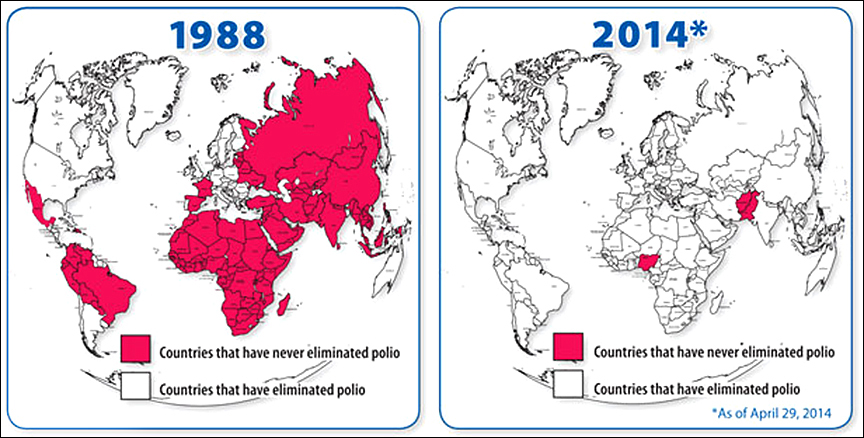 Polio Eradication Progress, 1988-2014 By Chana Ya’ar First Publish: 6/30/2013, 3:56 PM http://www.israelnationalnews.com/News/News.aspx/169460#.UdZDZ6zhdbc
They and an official from the U.S. Centers for Disease Control were in Israel to see what the Jewish State is doing to prevent the possible spread of poliomyelitis – a disease once considered “dead.”
The decision to spend “several million shekels” for nearly one million doses of the “live attenuated” vaccine came after the live virus had been detected in February in routine samples of sewage extracted from the Negev Bedouin city of Rahat.
Health Minister Yael German and other officials stressed there was “no reason to panic” as there has not been even one case of the clinical form of poliomyelitis – the type that causes paralysis.
But the decision to administer oral polio vaccine (OPV) was made after consulting with the foreign experts.
No Israeli children under age eight have received a Sabine OPV, due to a decision to discontinue the vaccine when the disease was considered eradicated. But babies and young children do receive several doses of IPV – the Salk vaccine – in well baby clinics around the country.
Israel is one of only five countries in the world that routinely tests stool samples via 16 sewage treatment plants around the country.
WHO figures indicated there were an estimated 350,000 actual cases of polio in 125 endemic countries in 1988; but in the countries which routinely test for the disease, last year the number had dropped to only 223 reported cases. |
|
|
|
|








